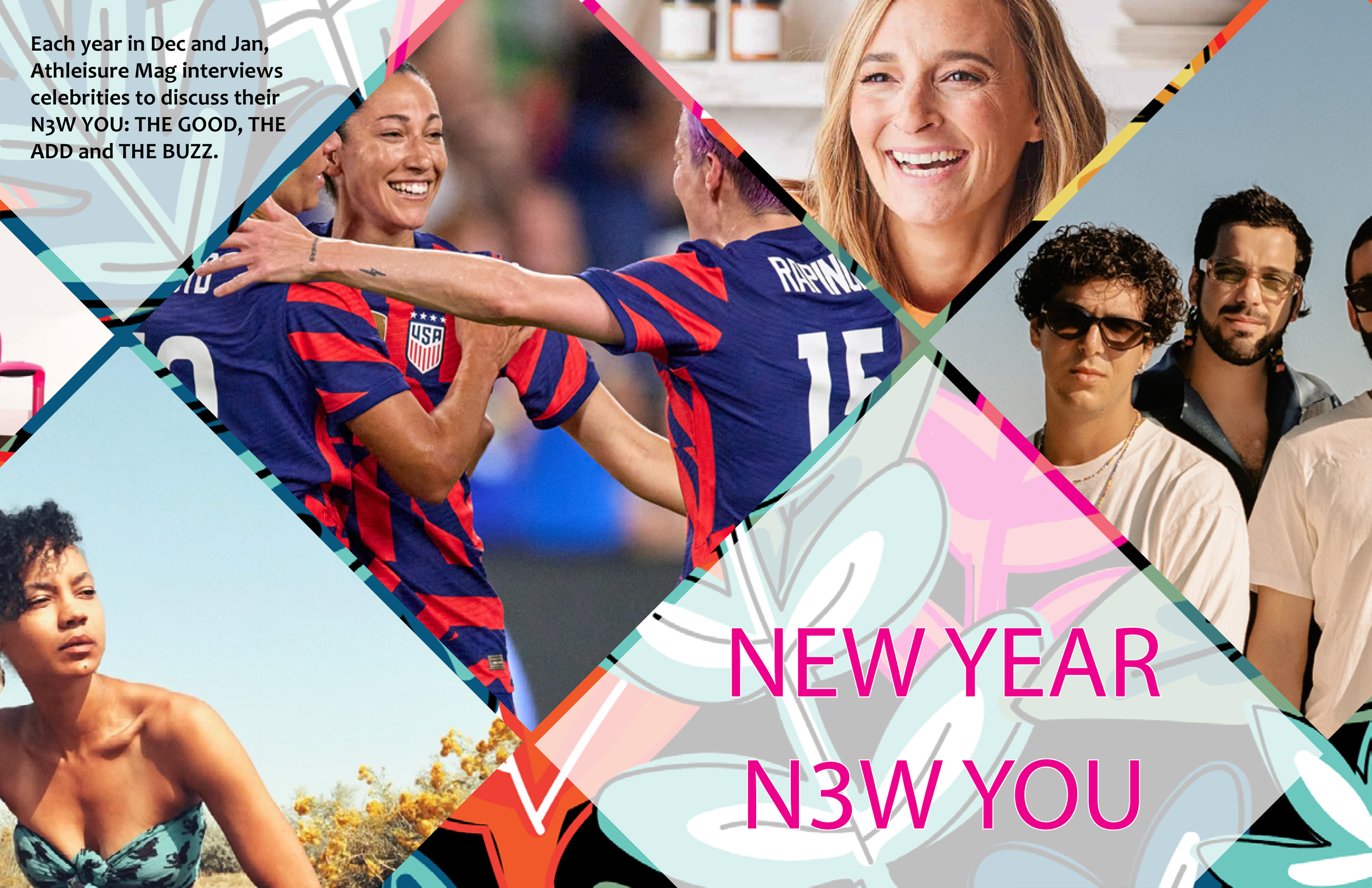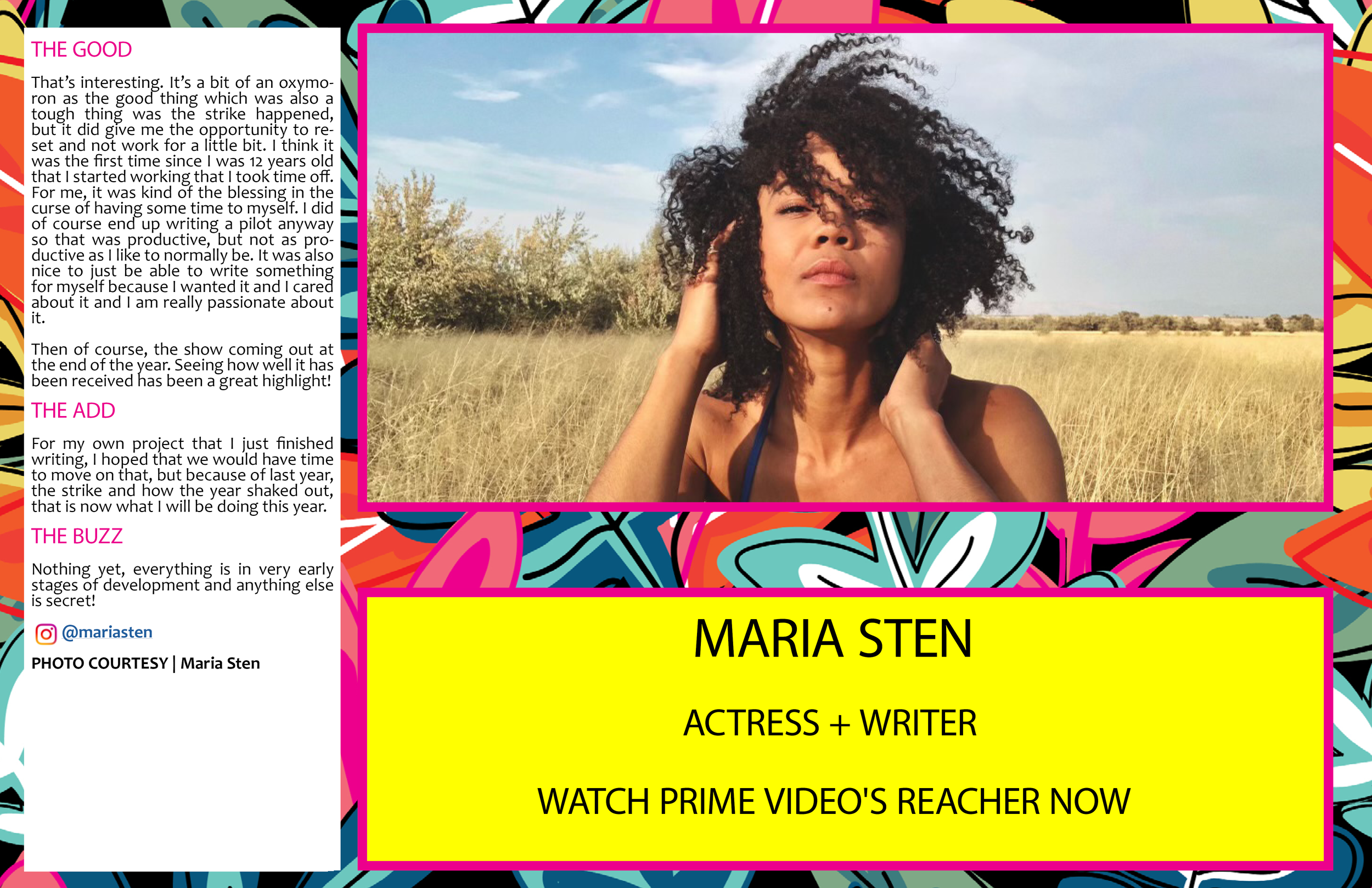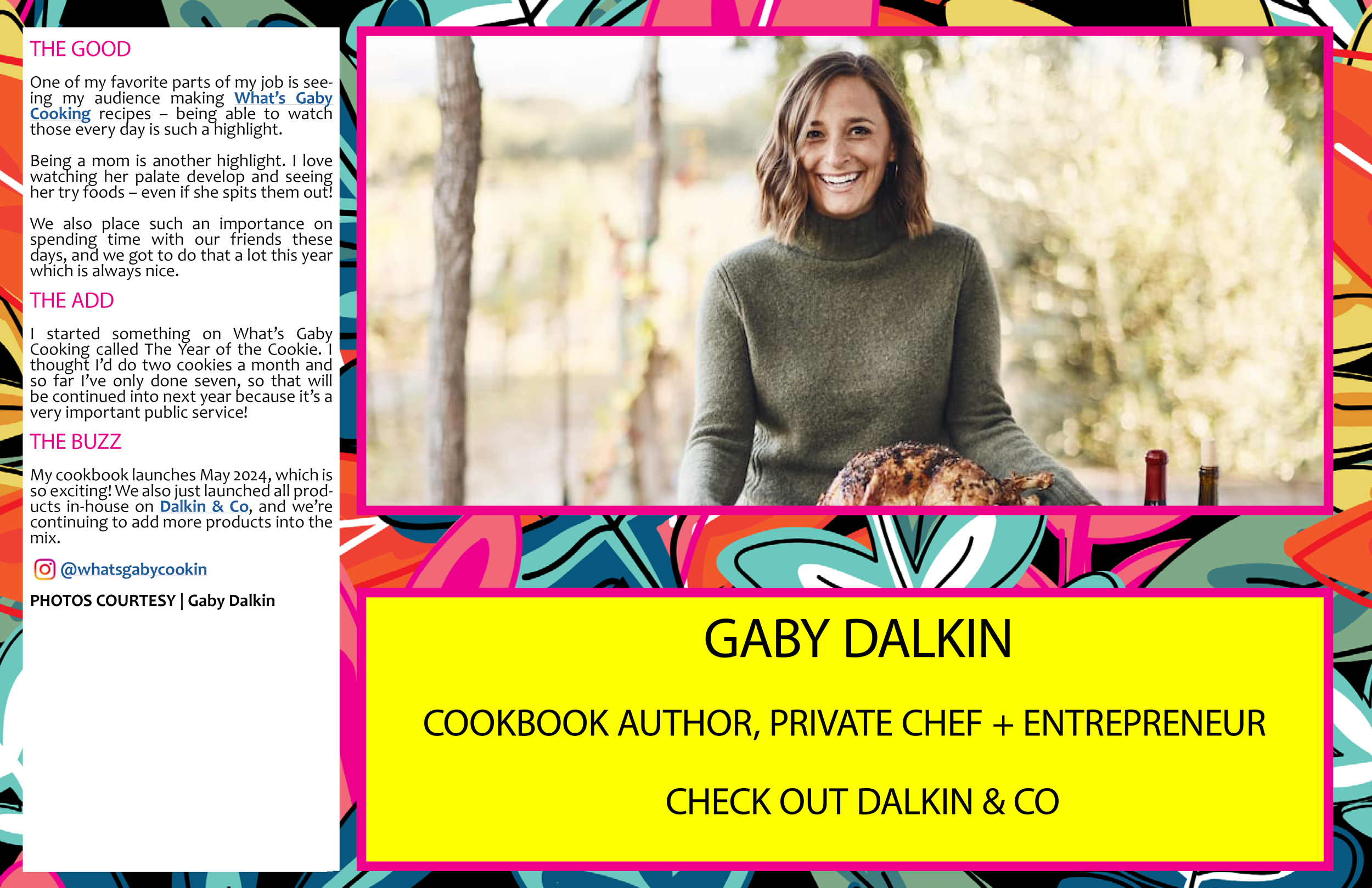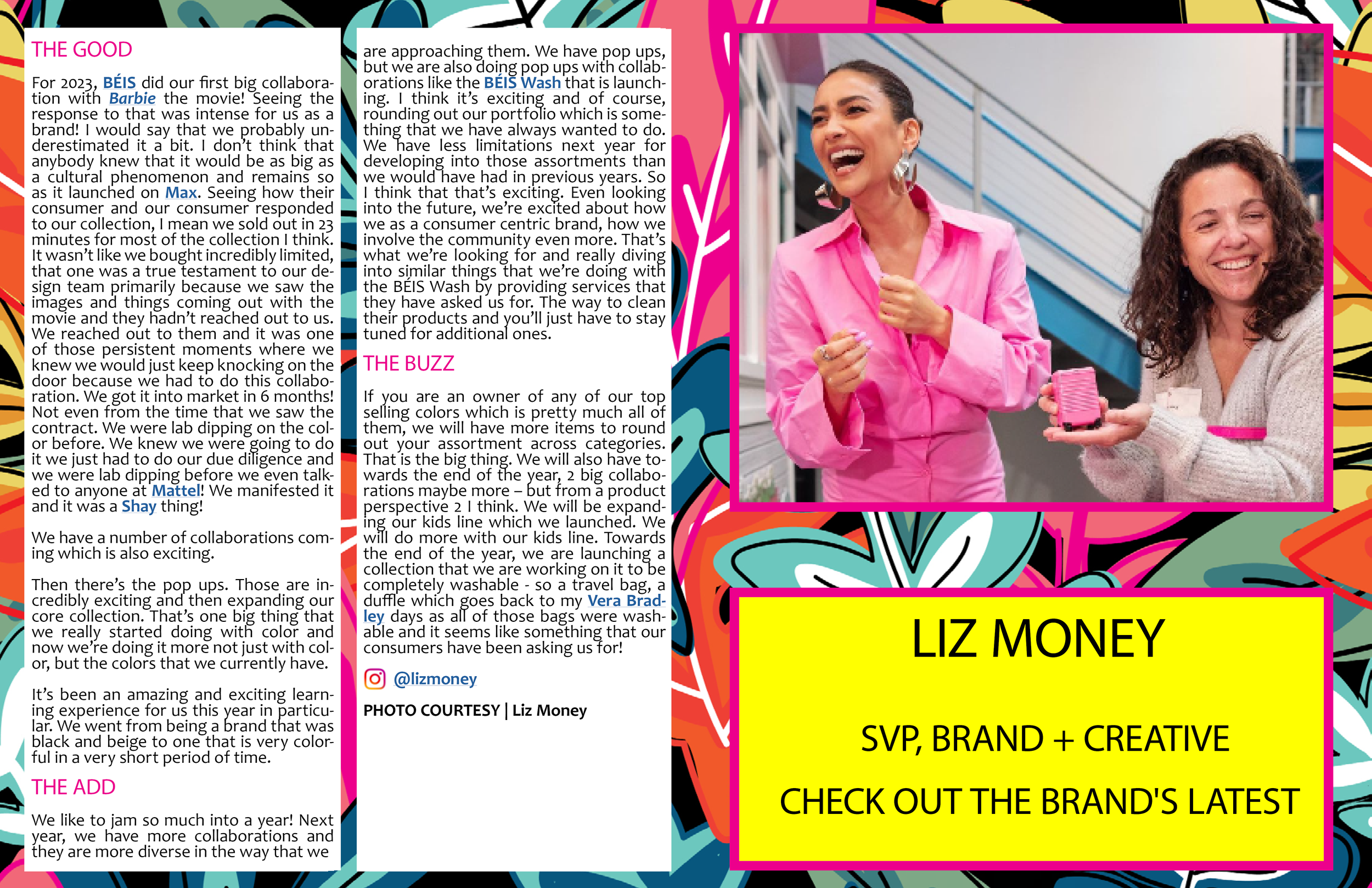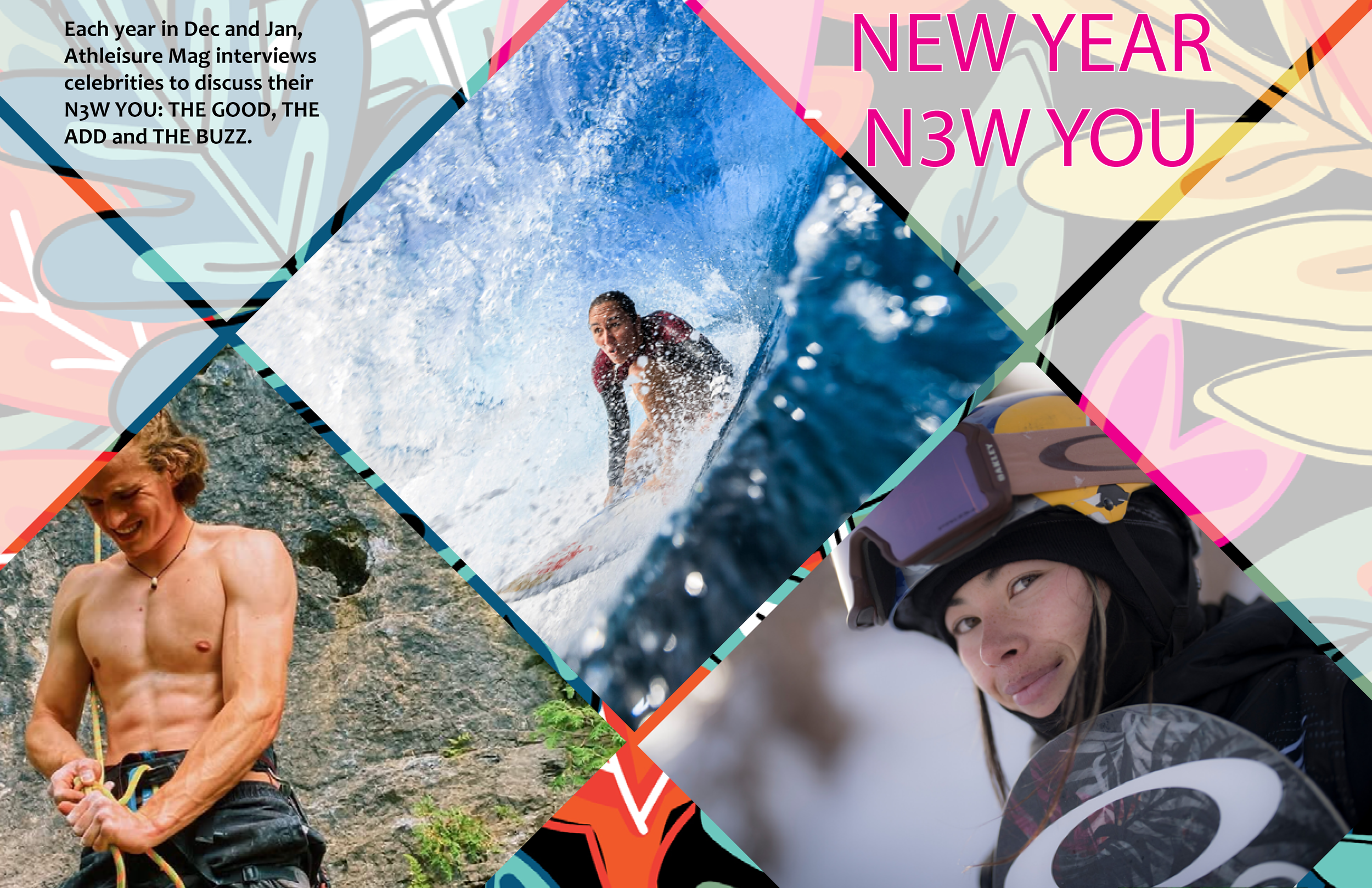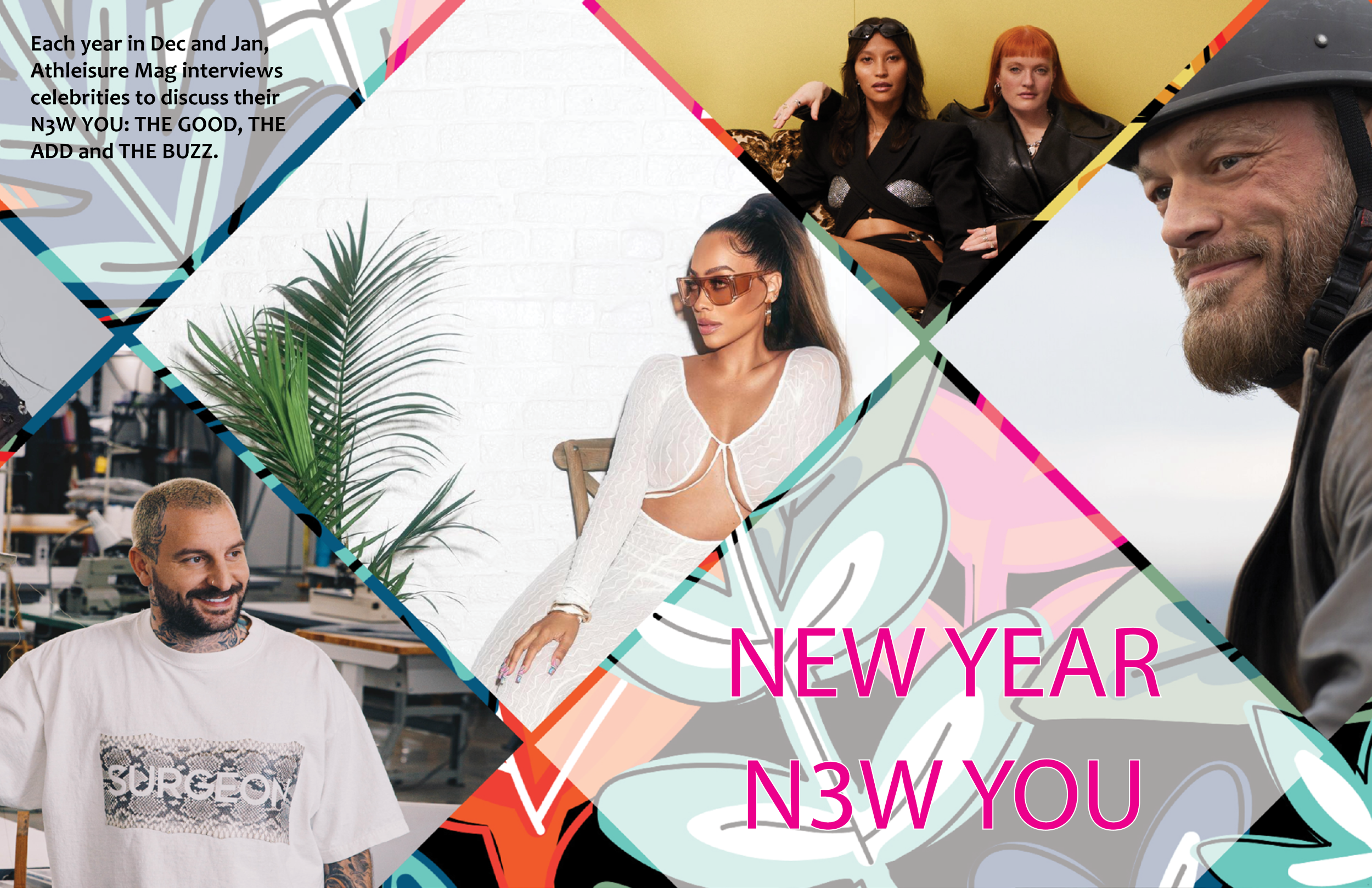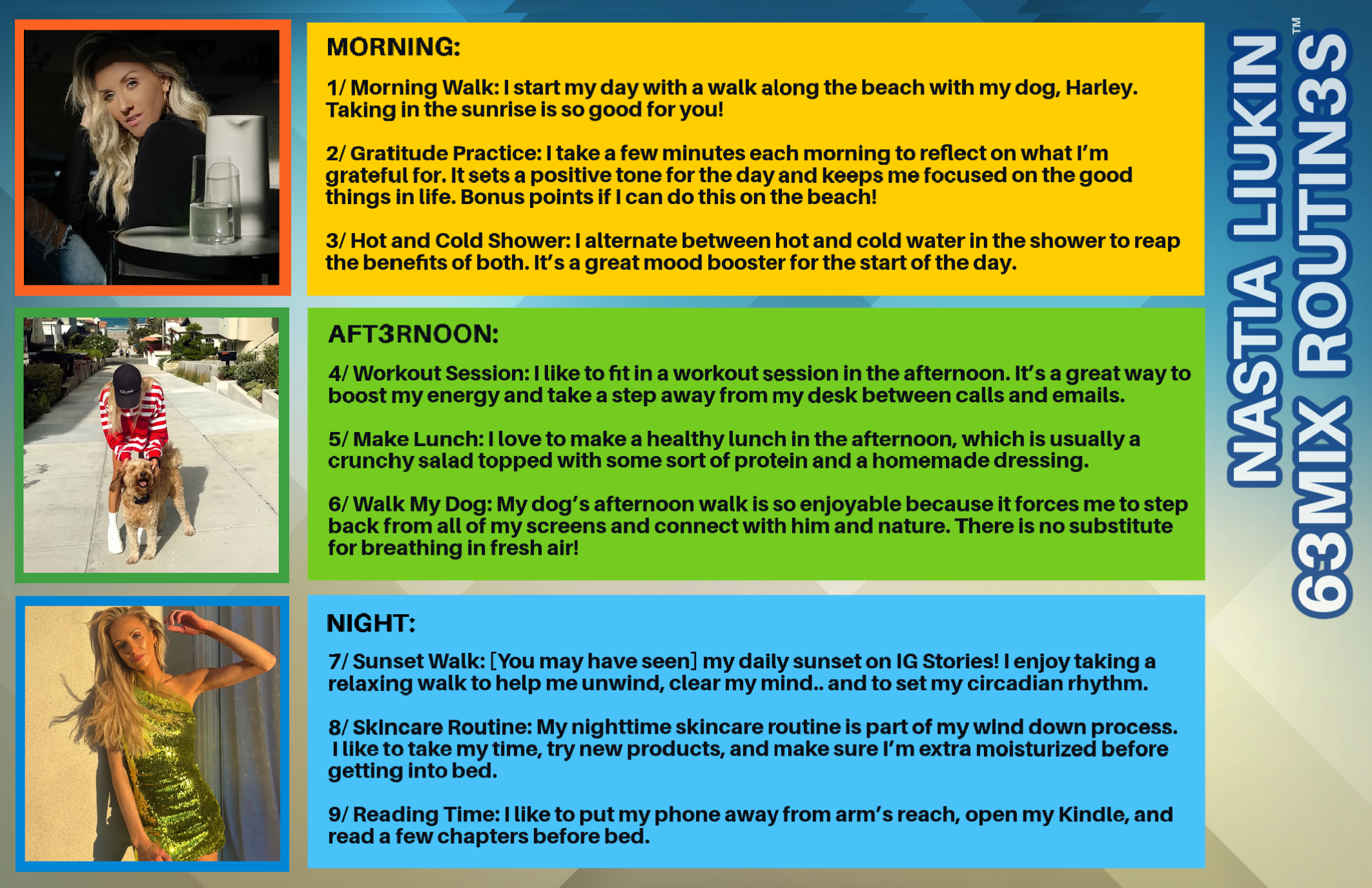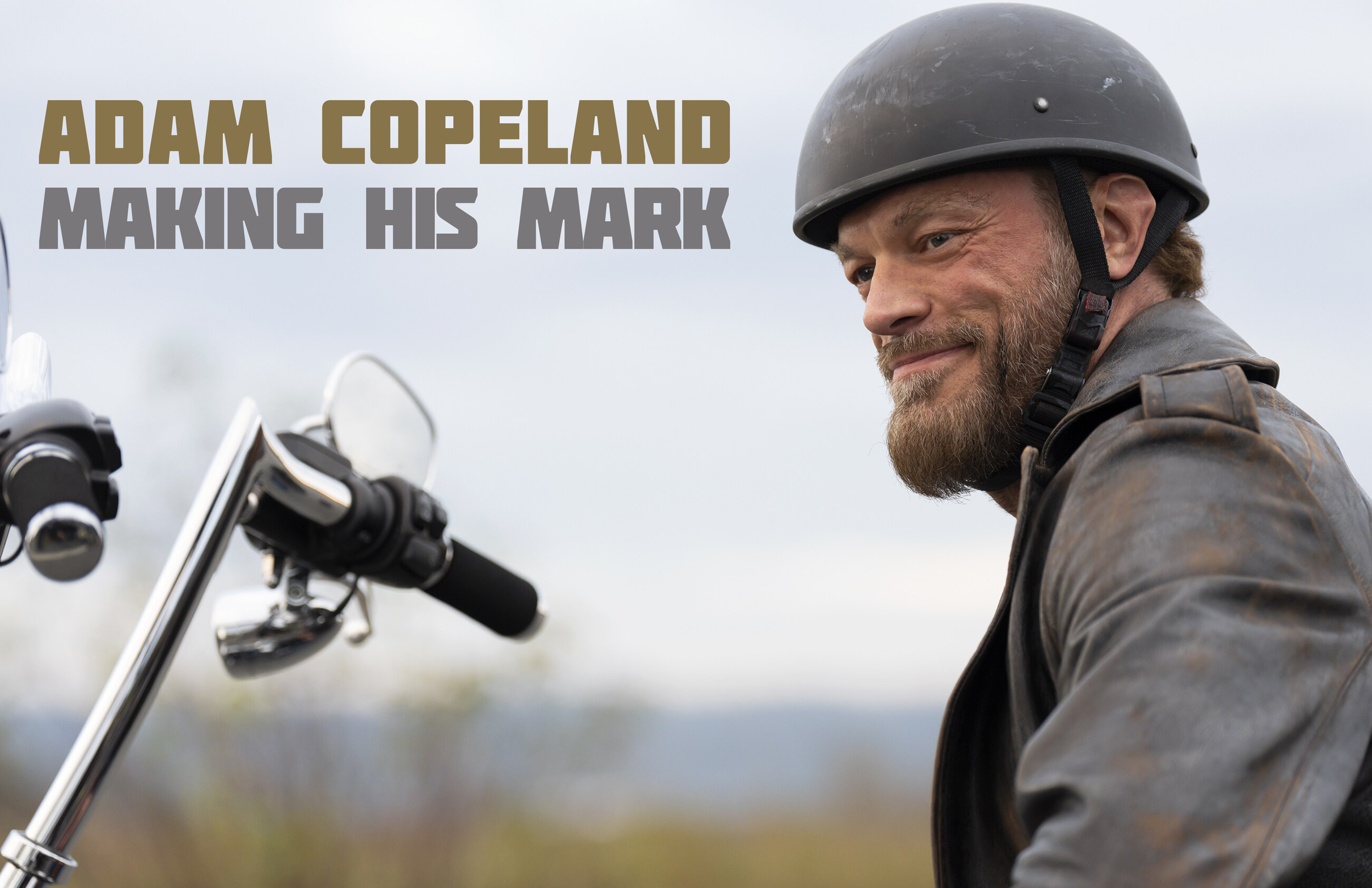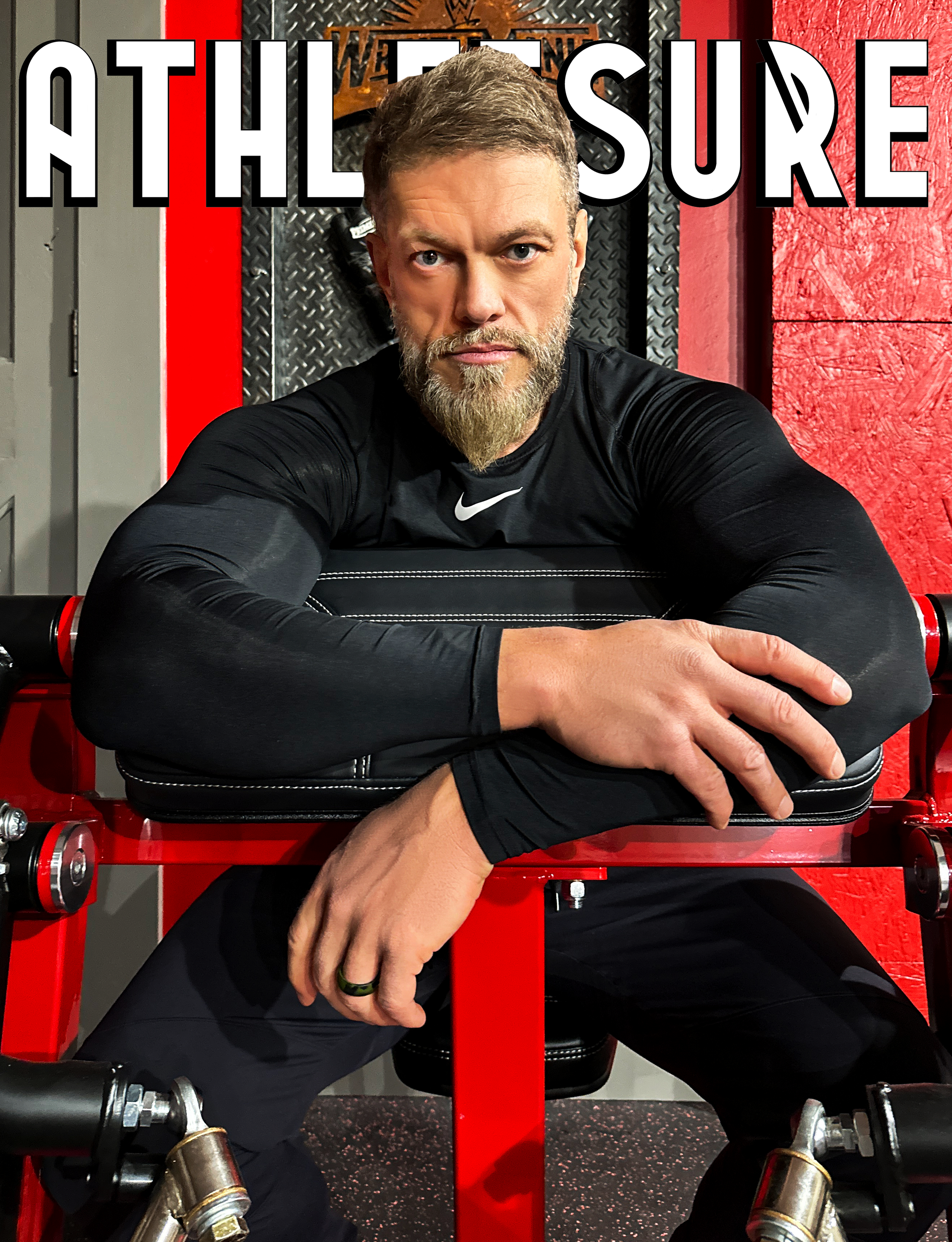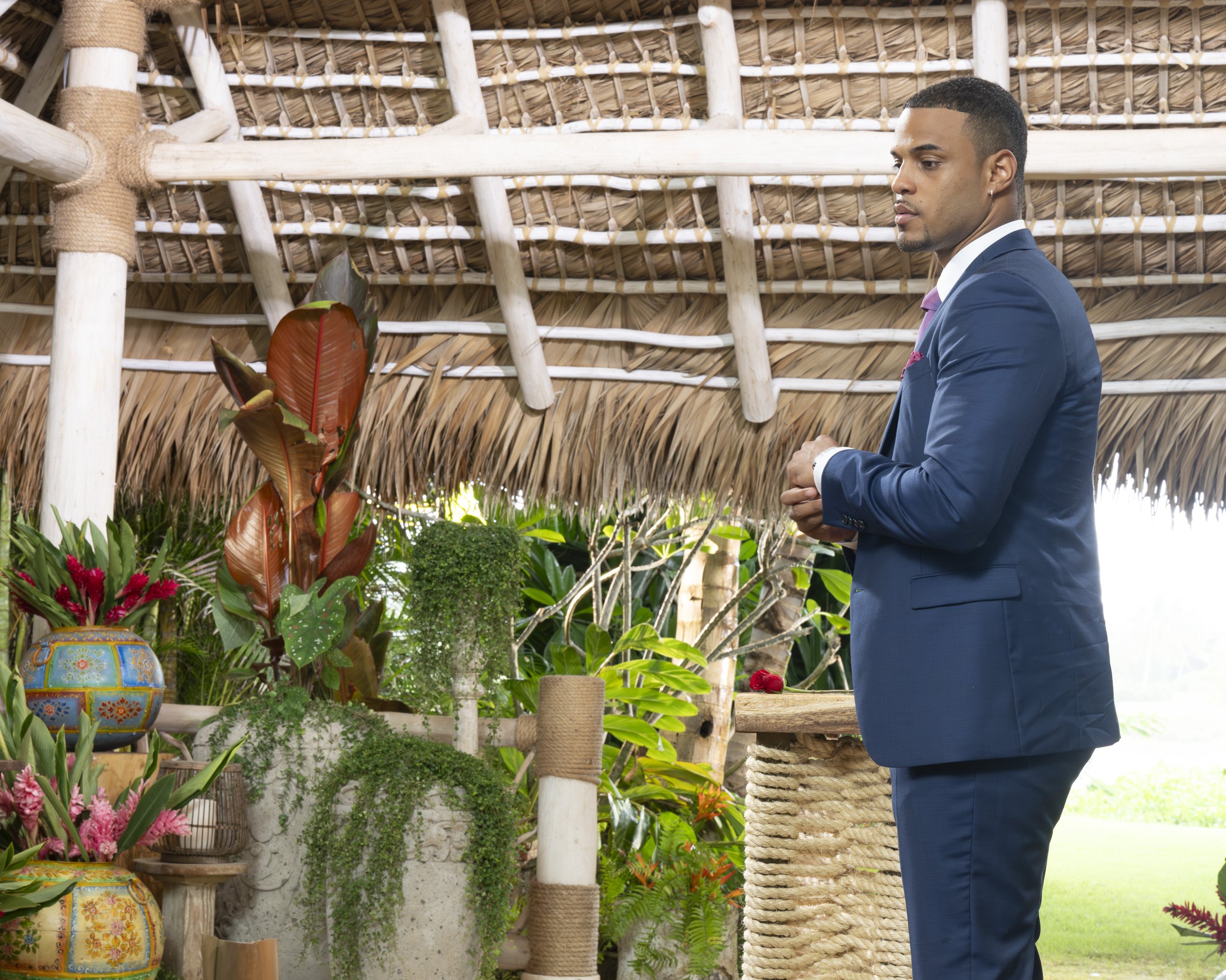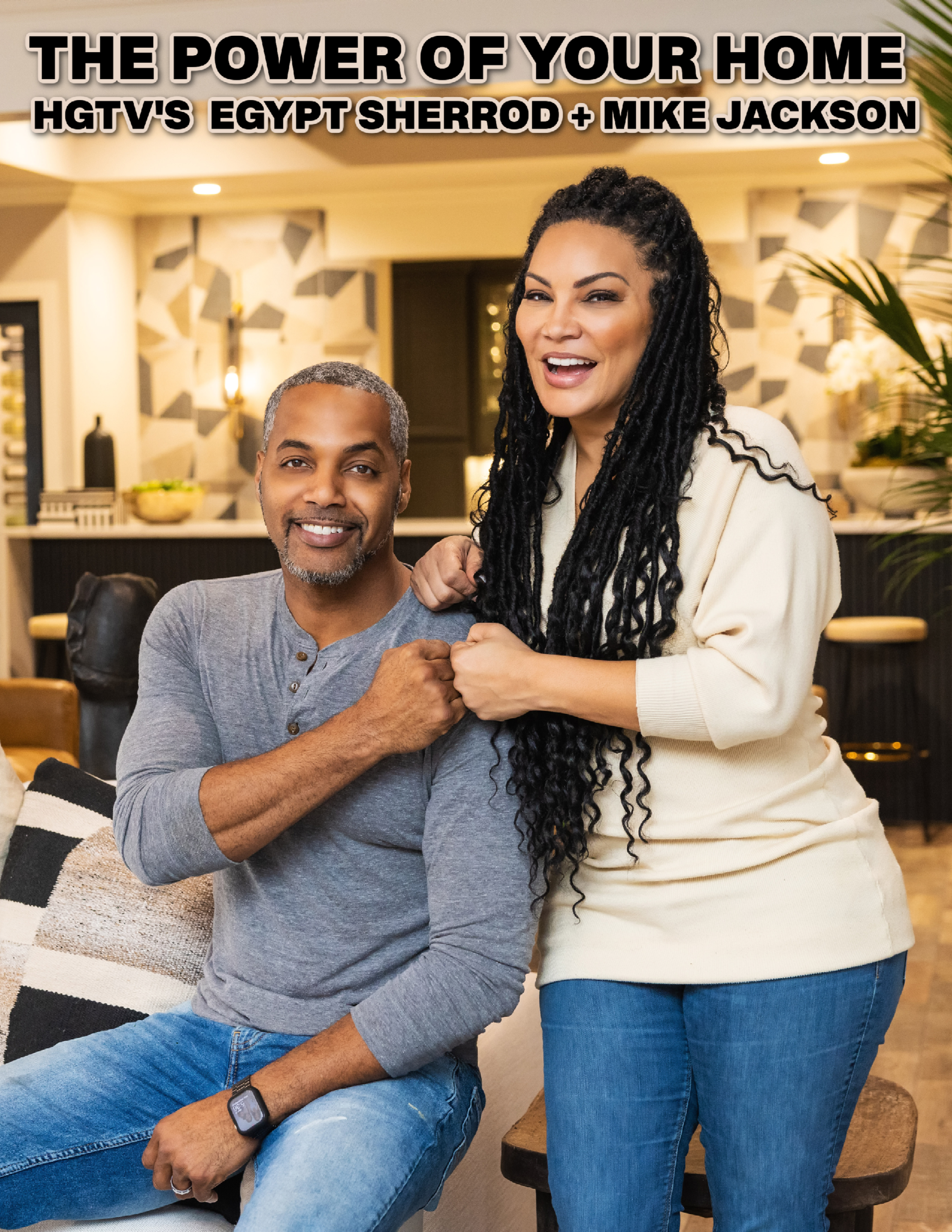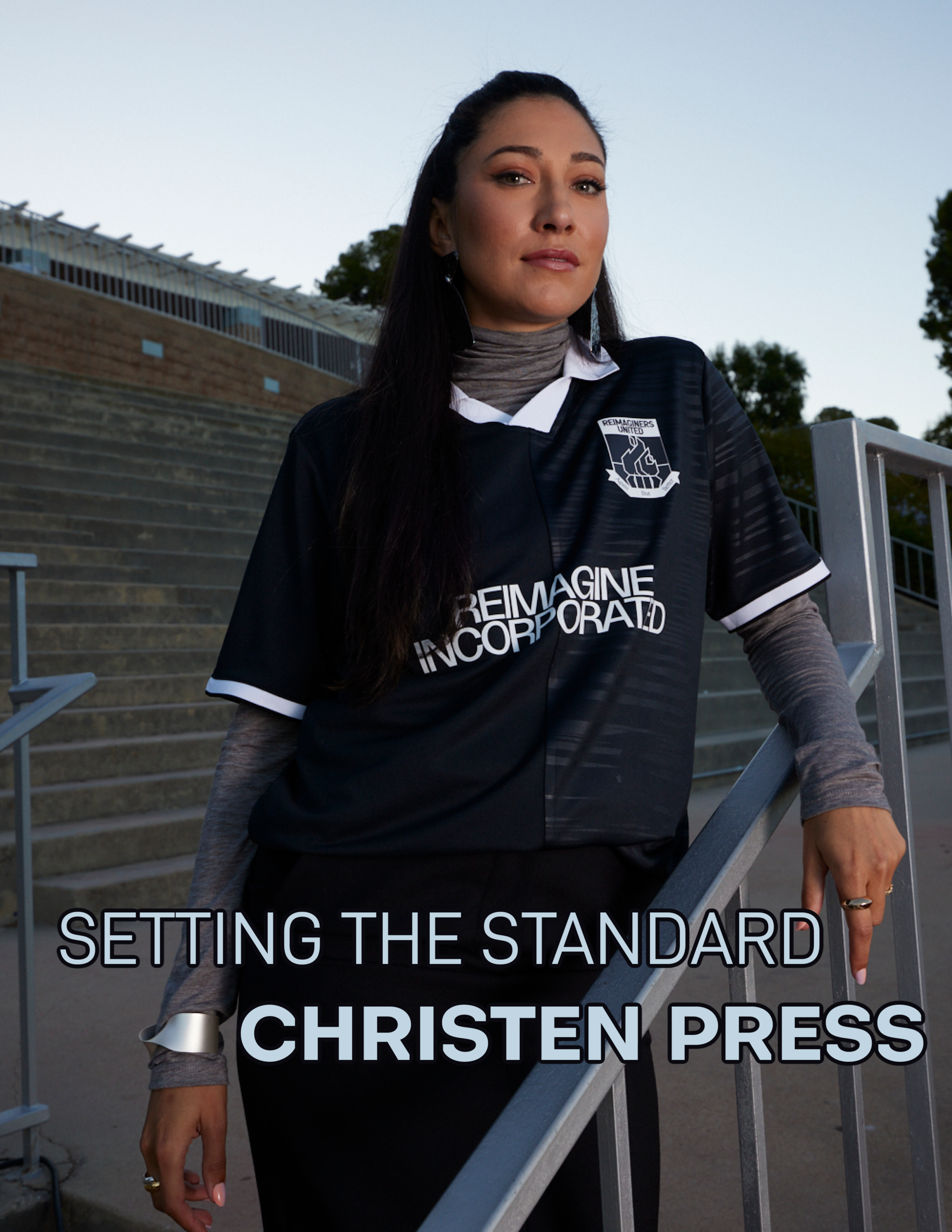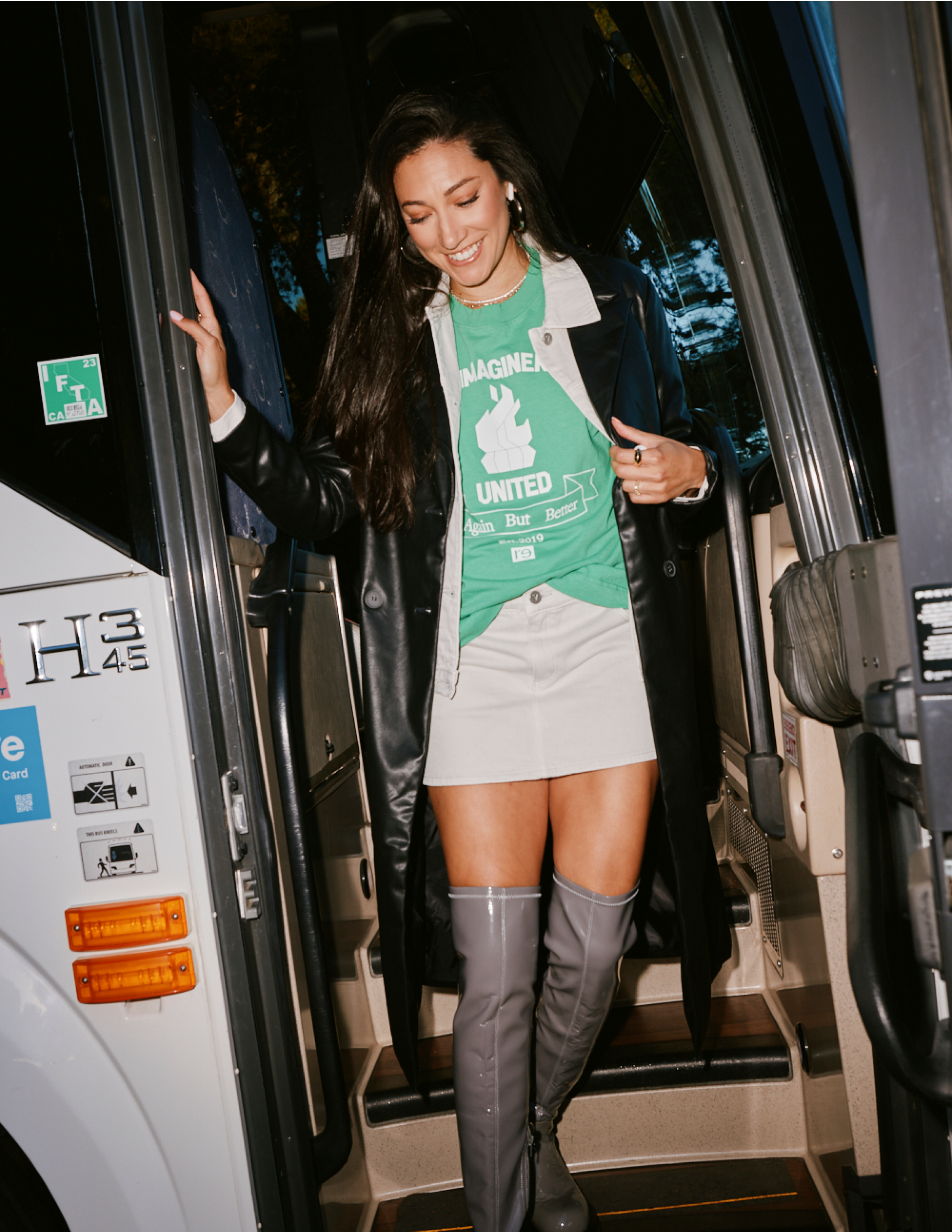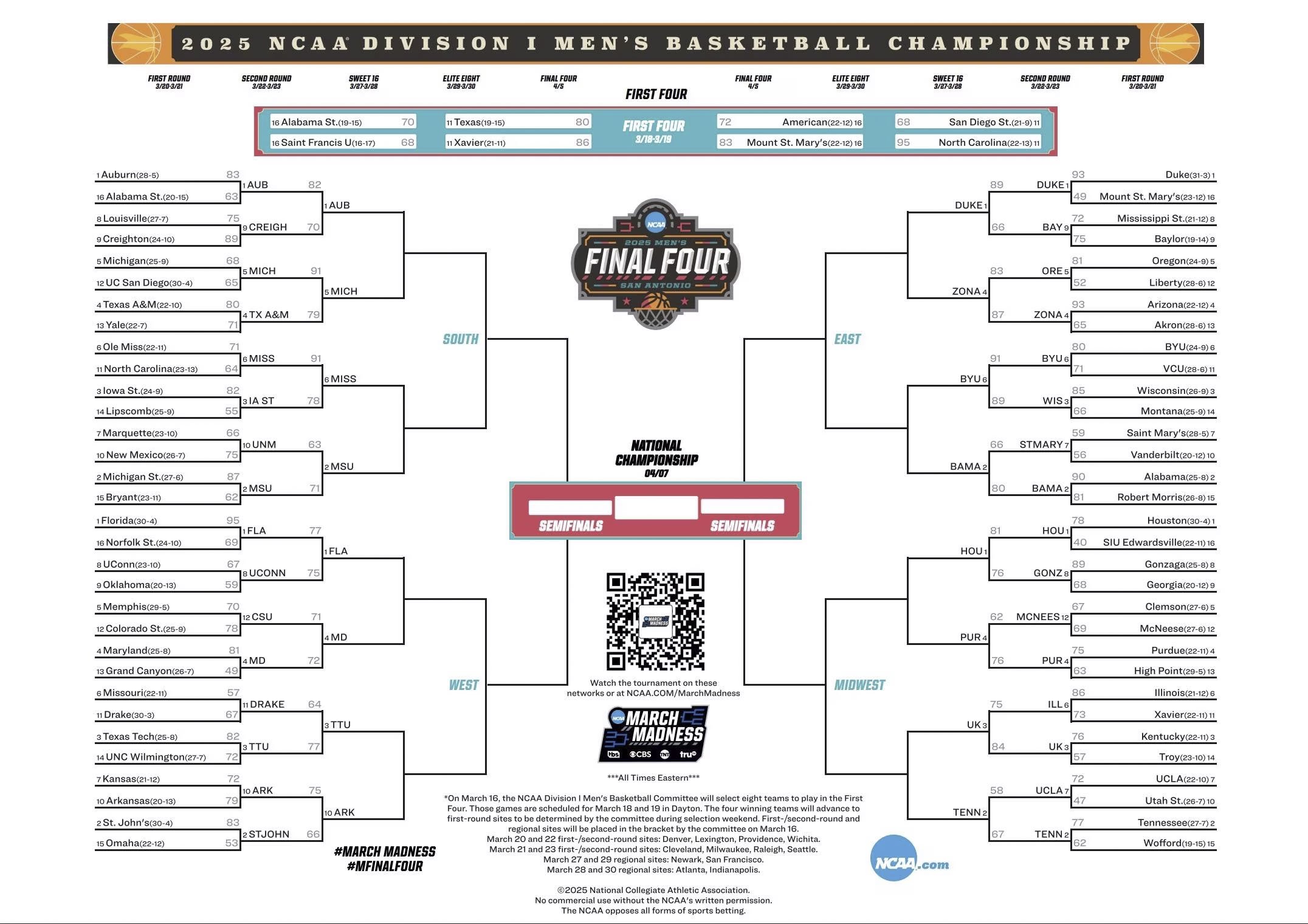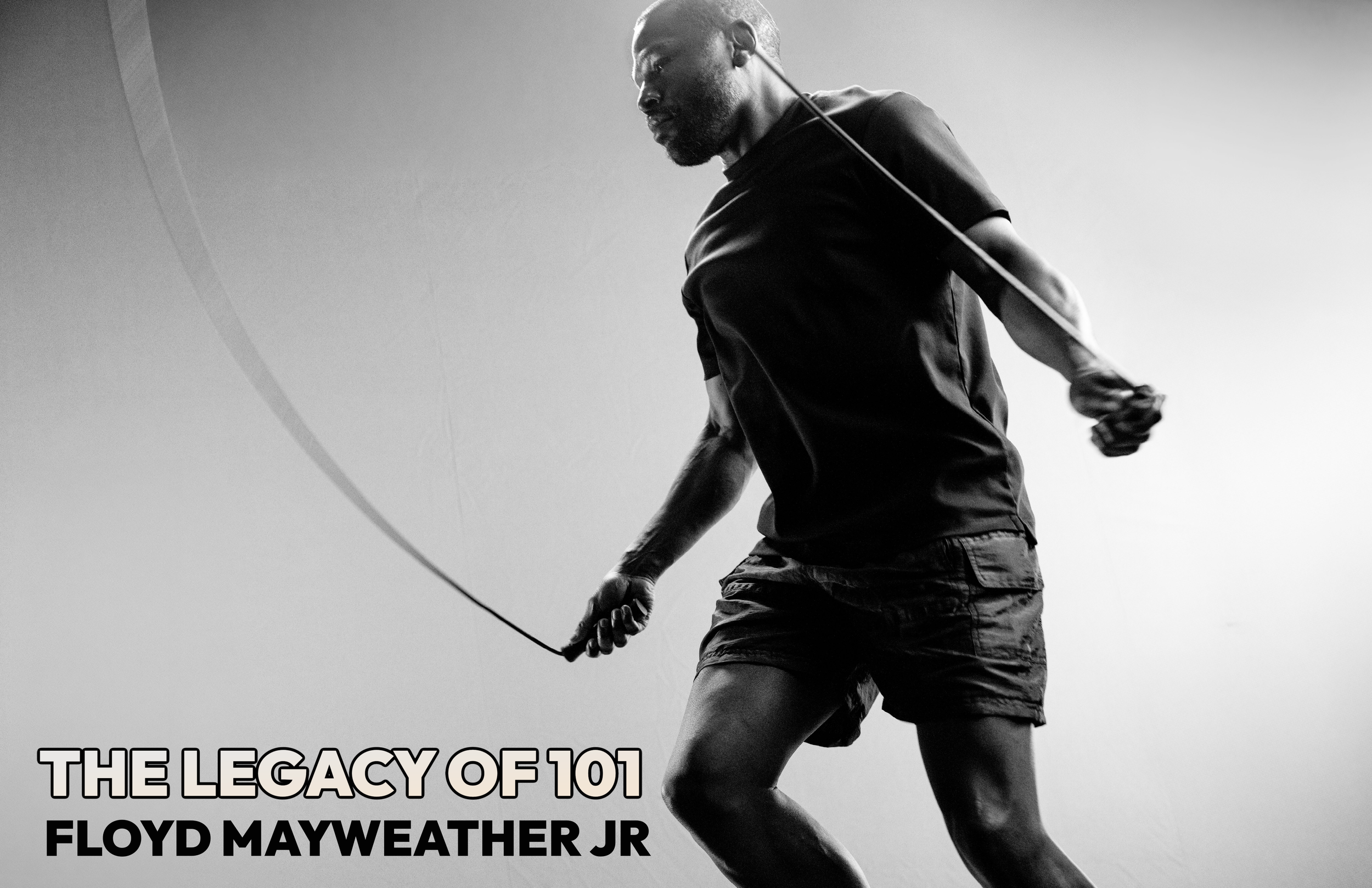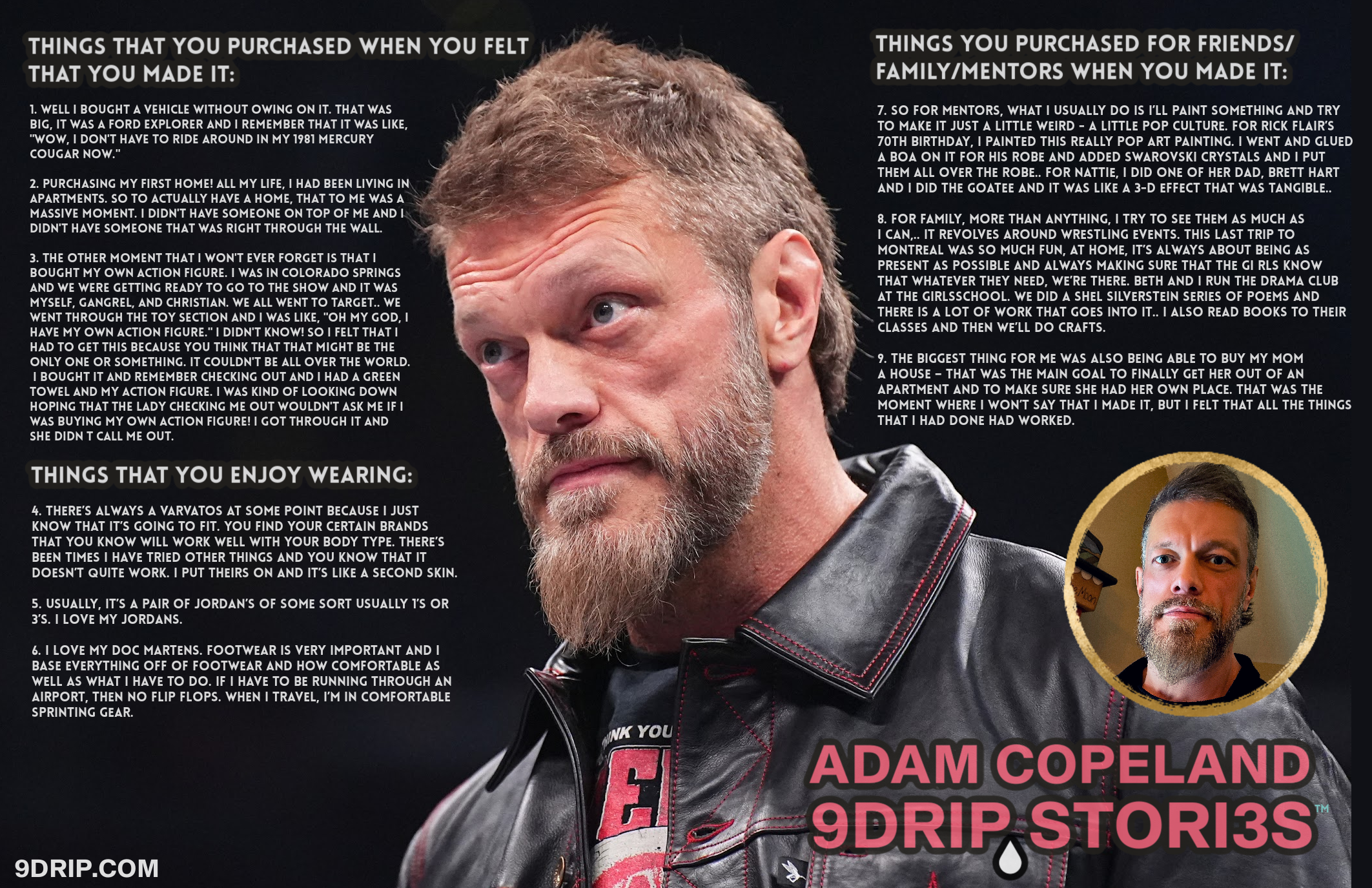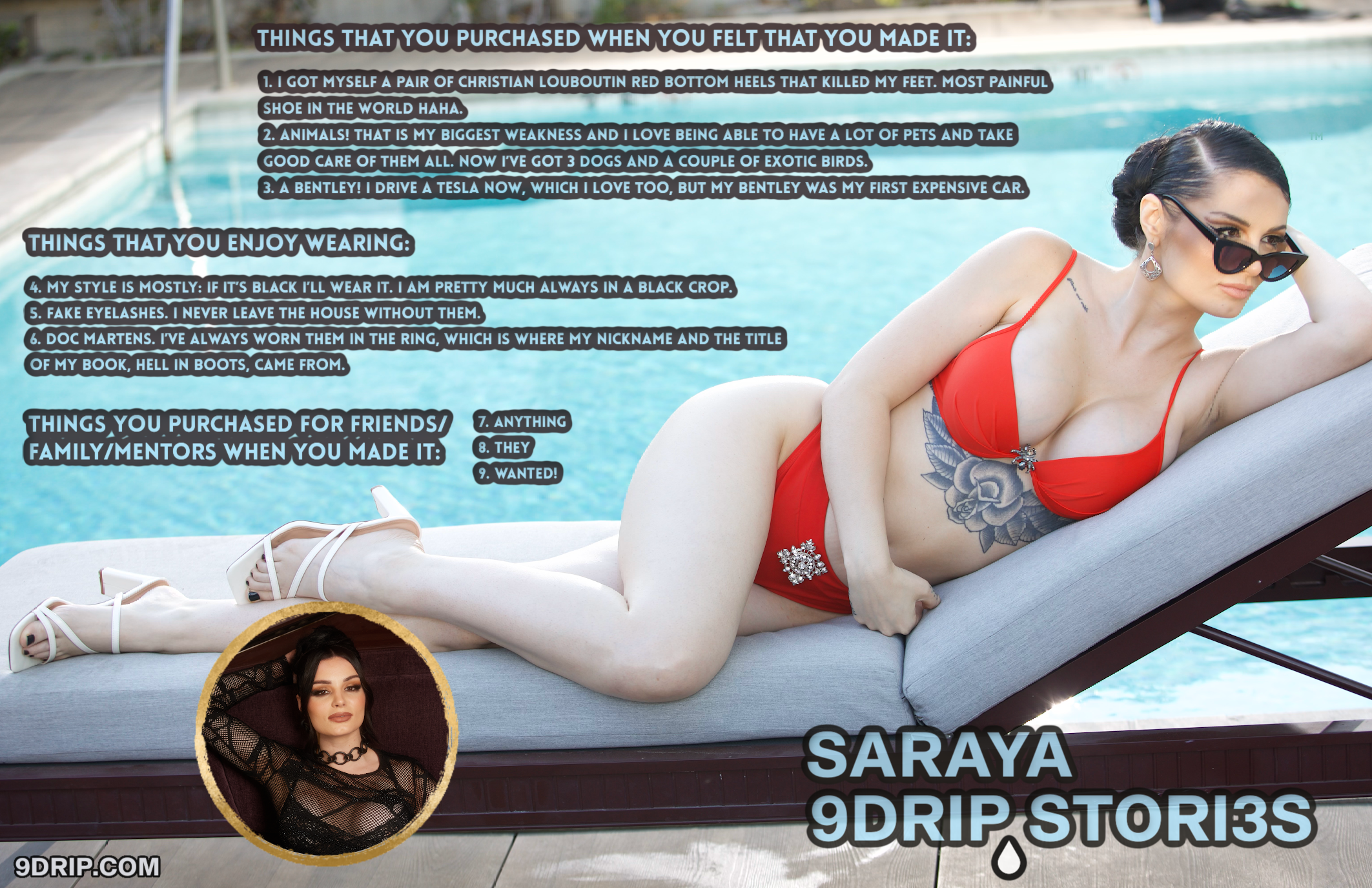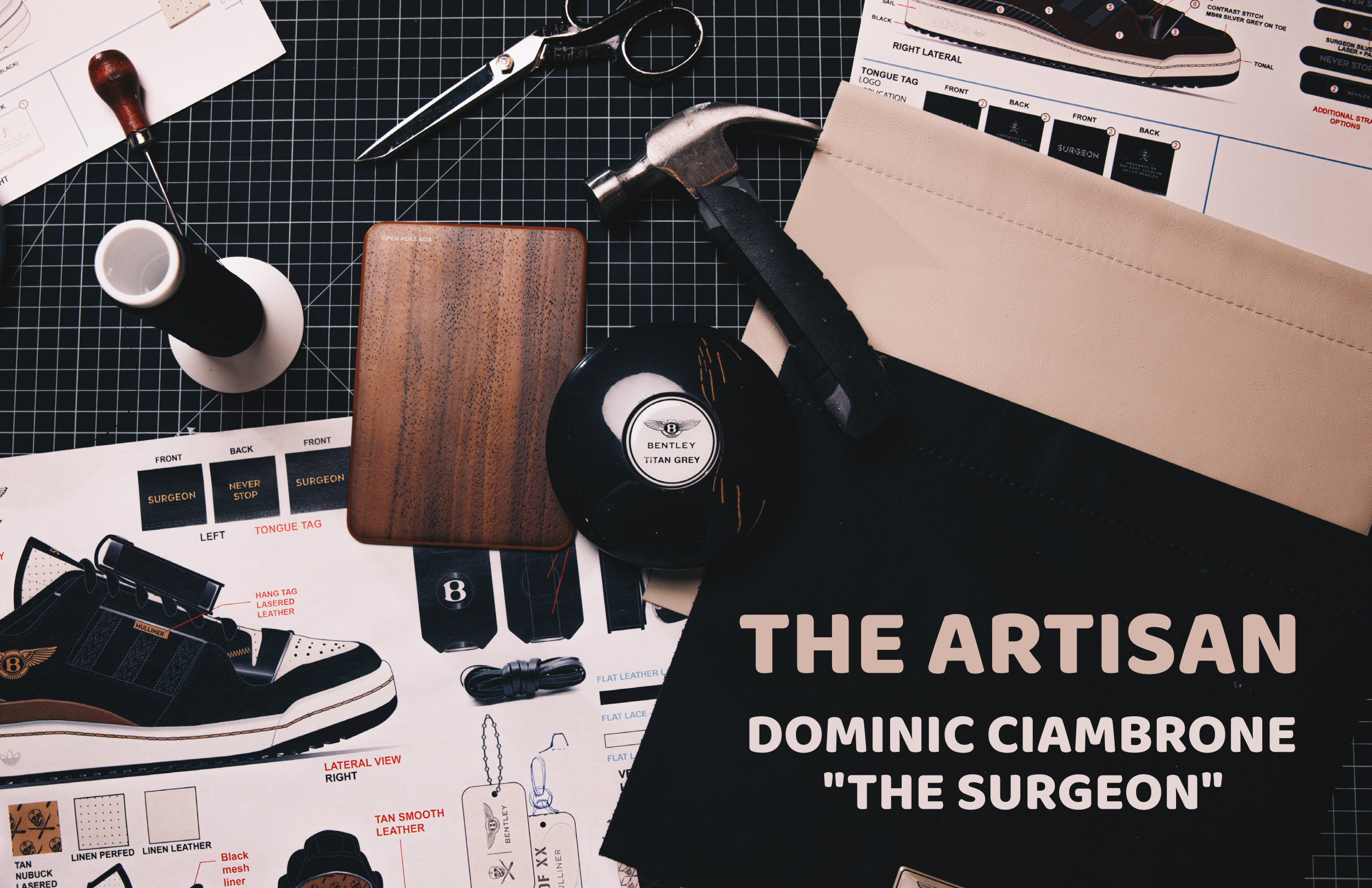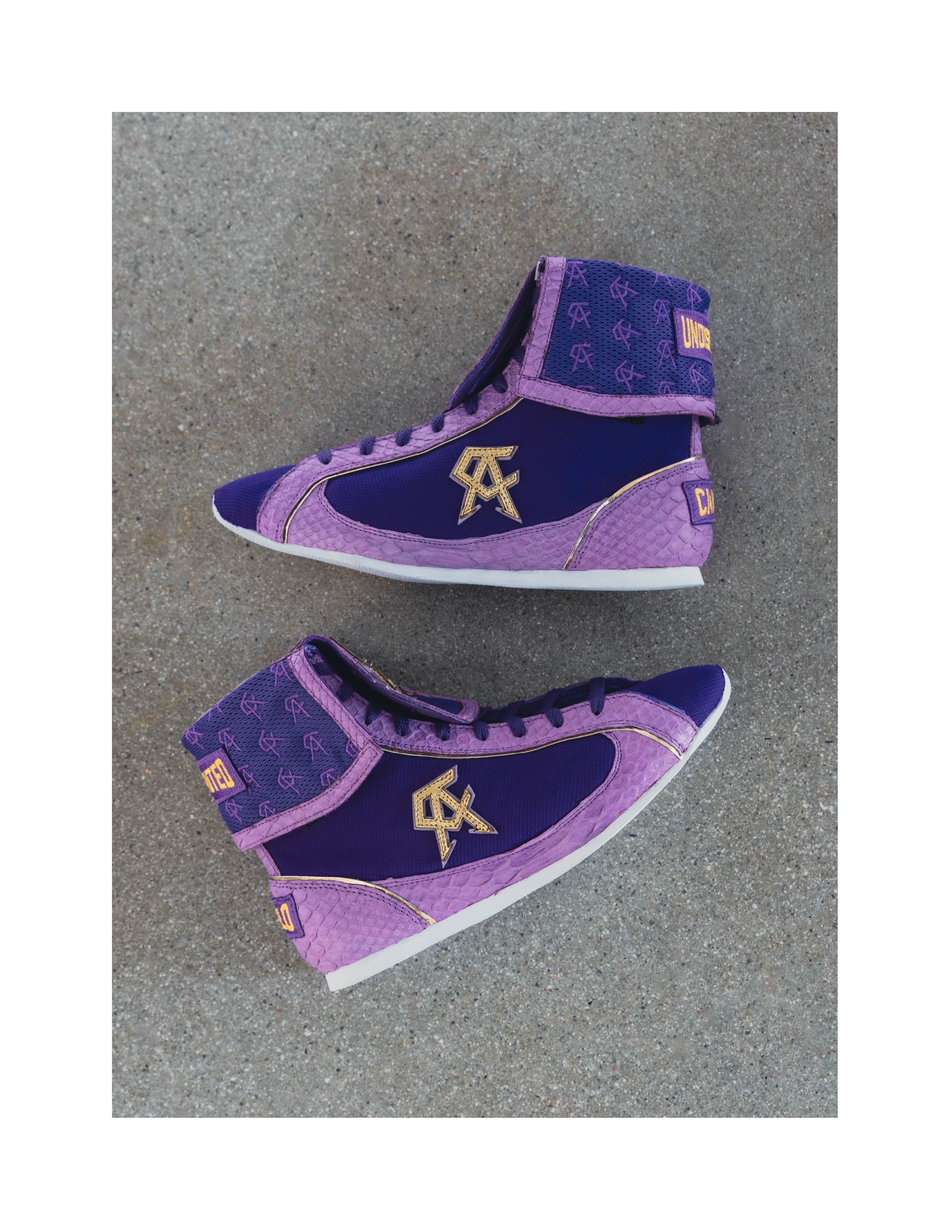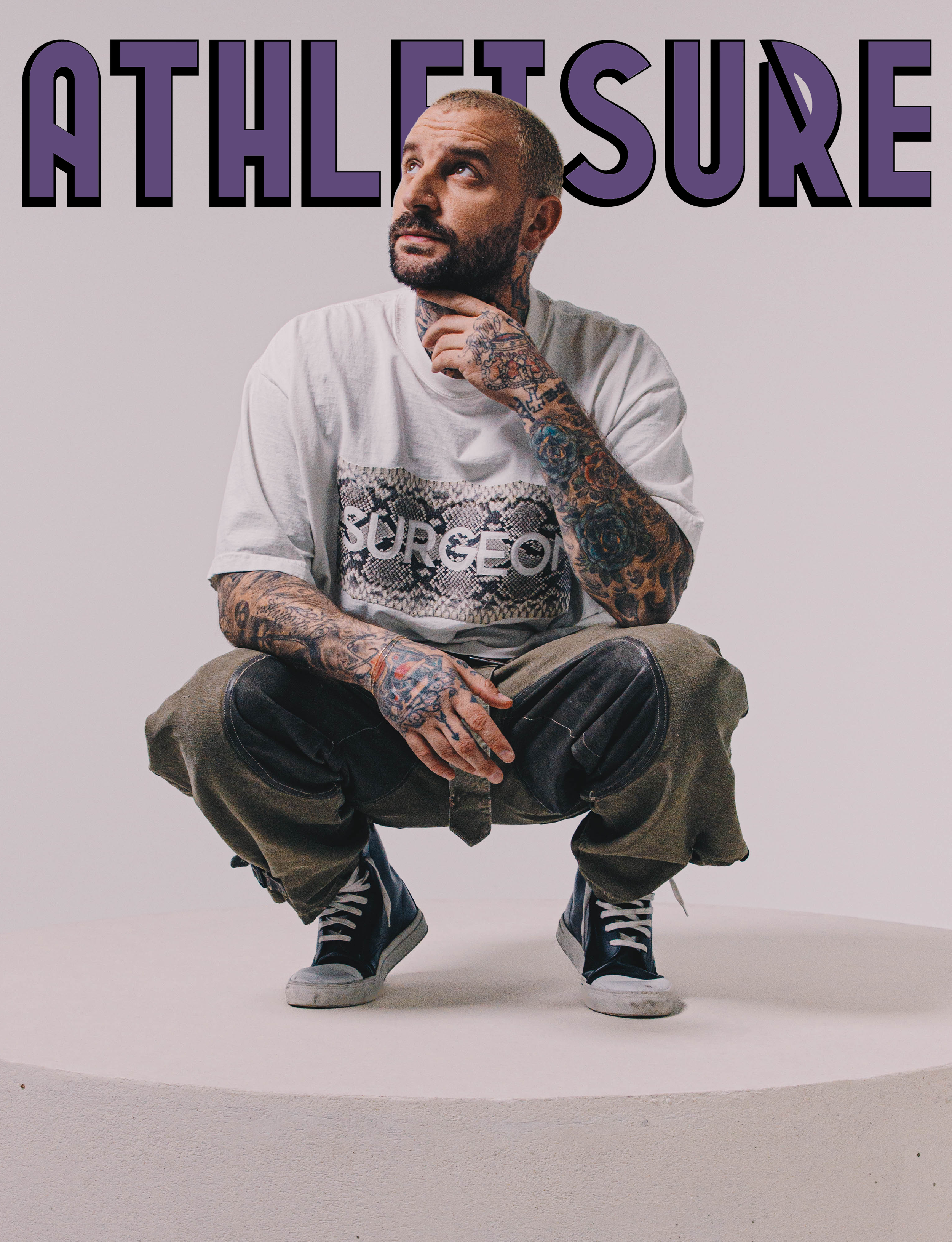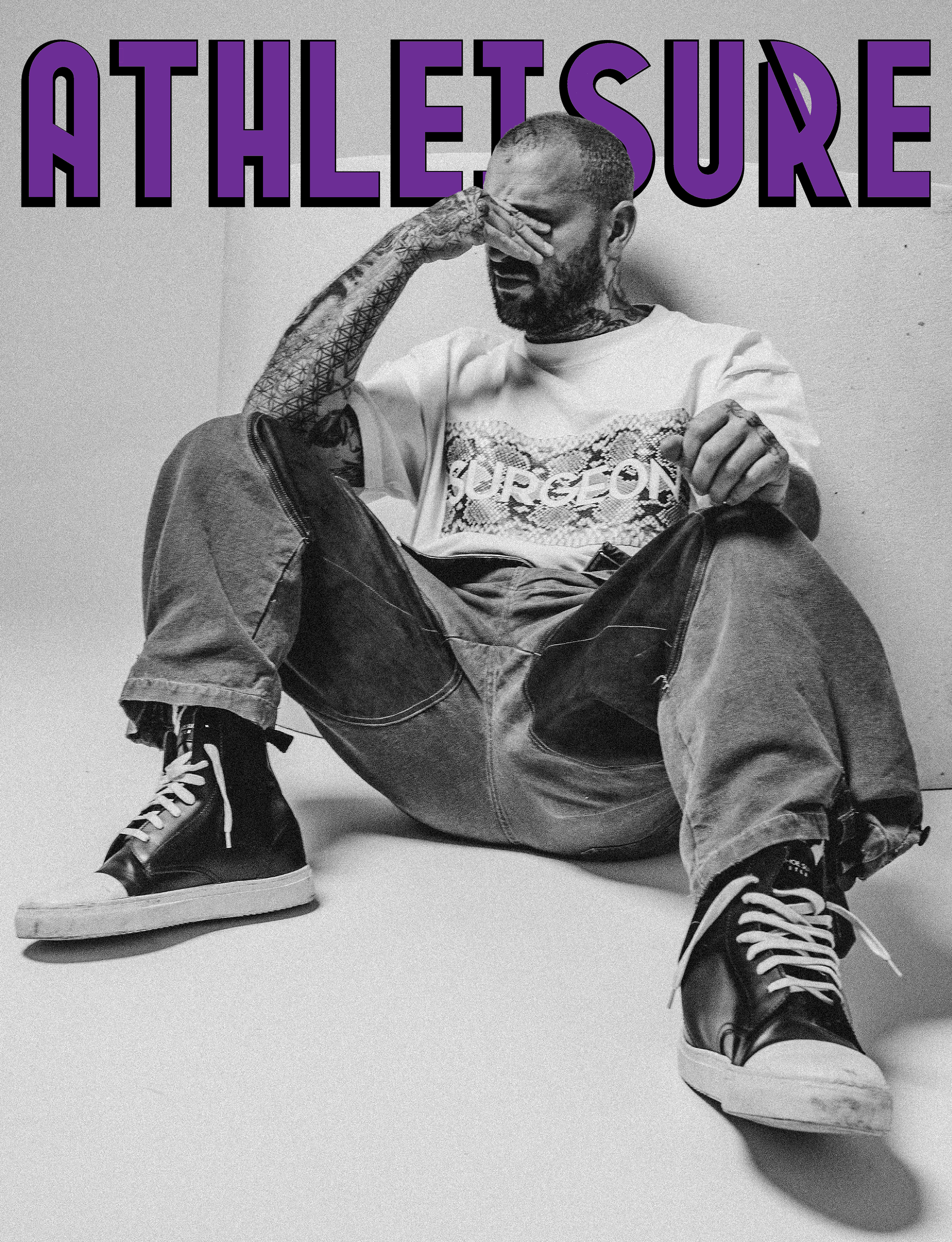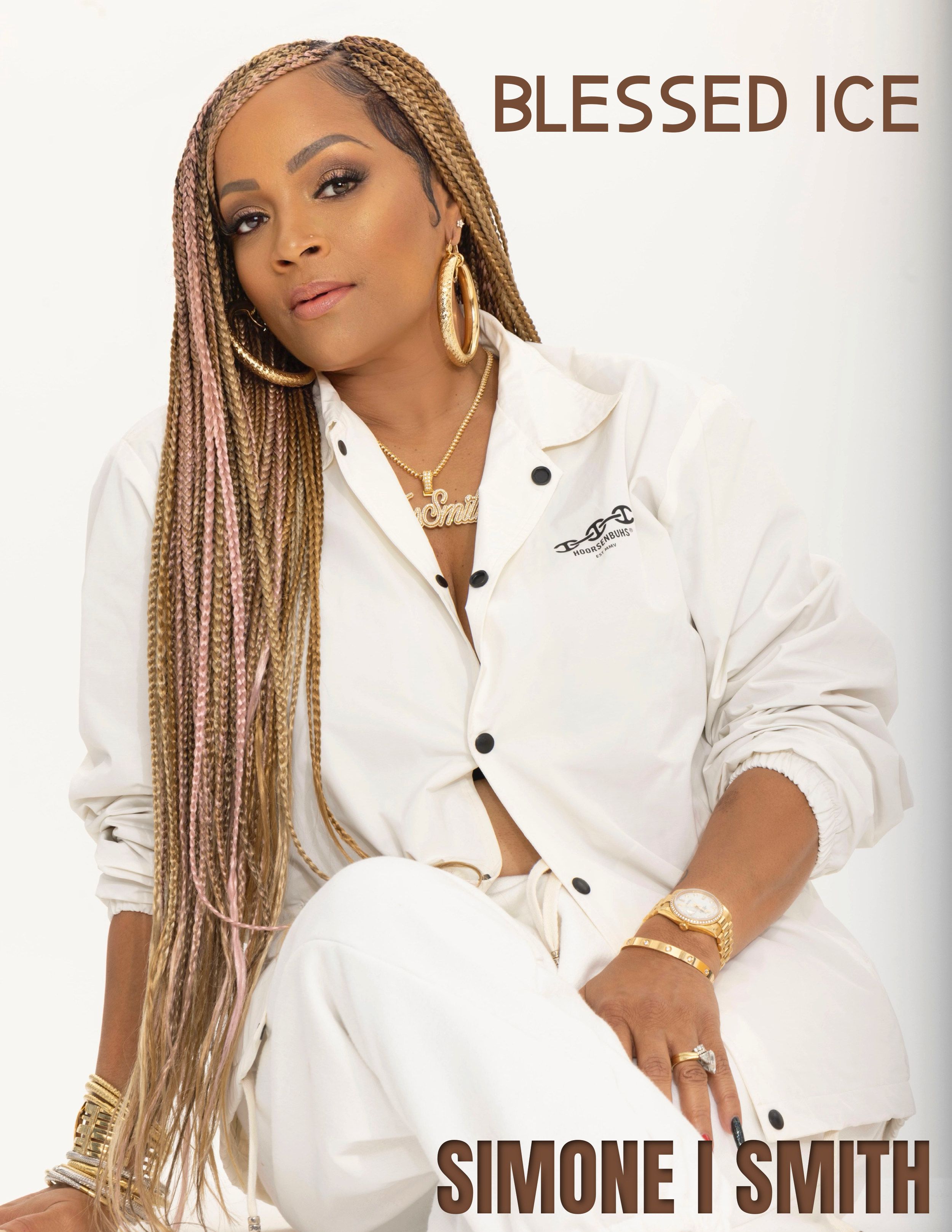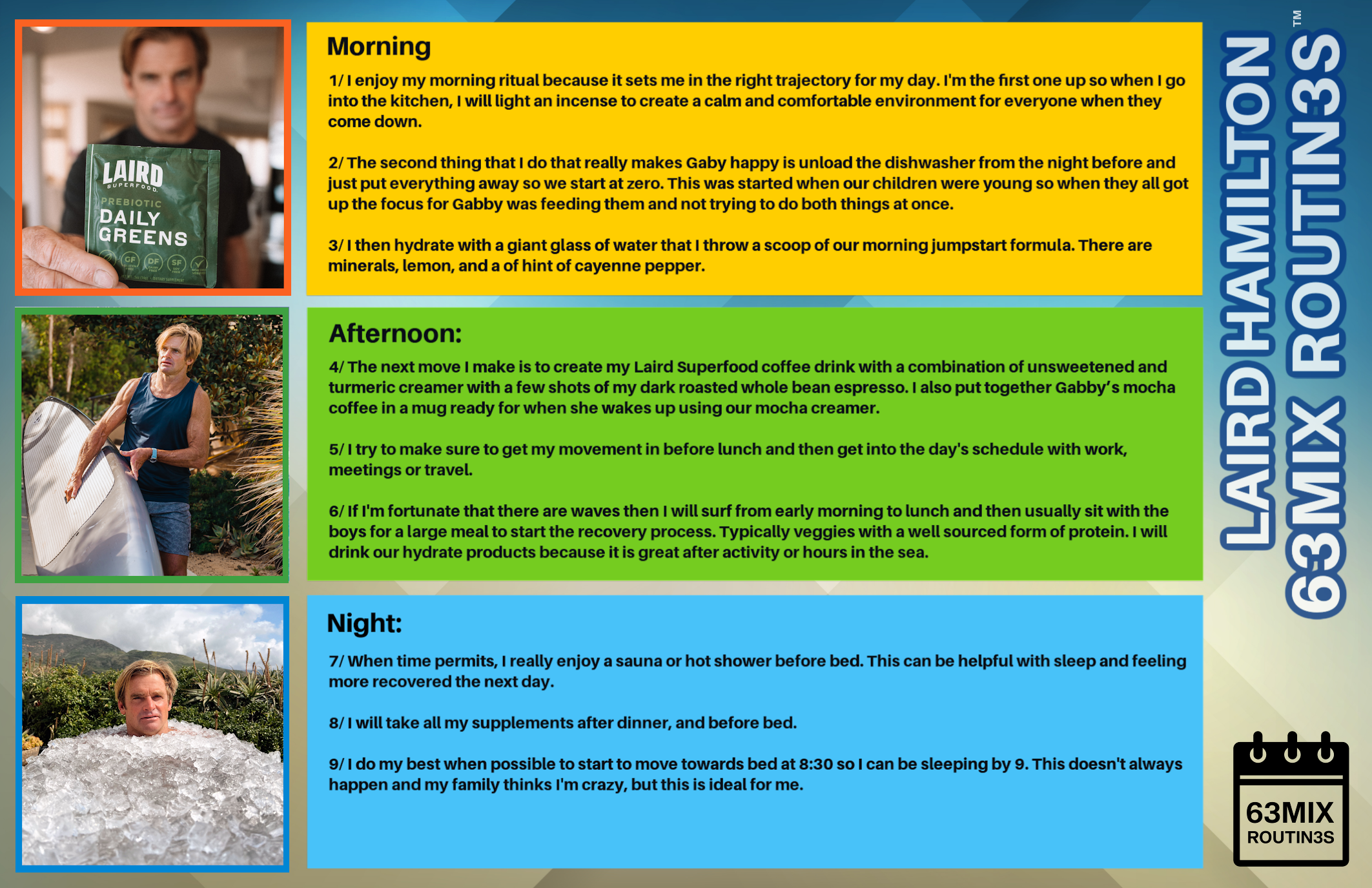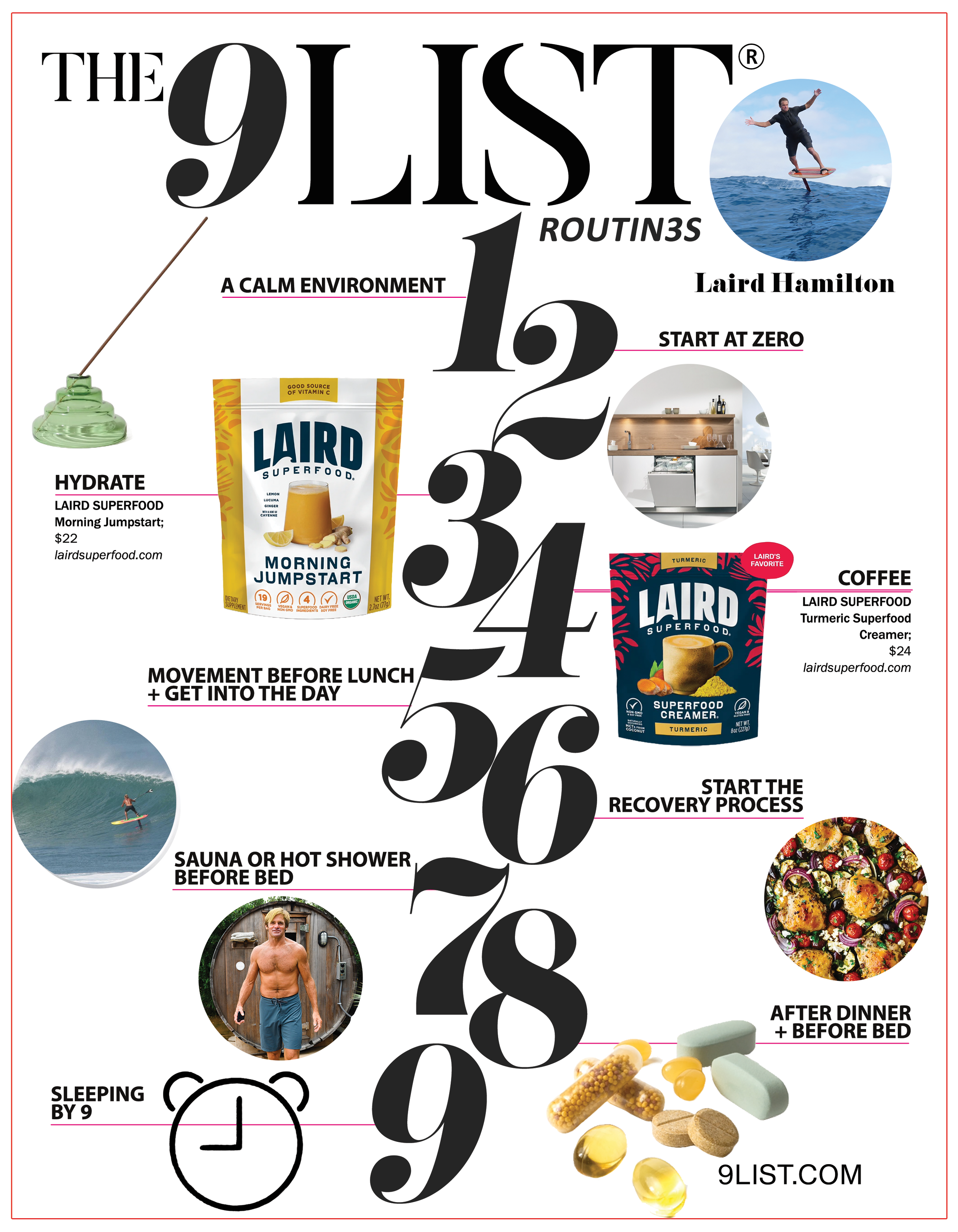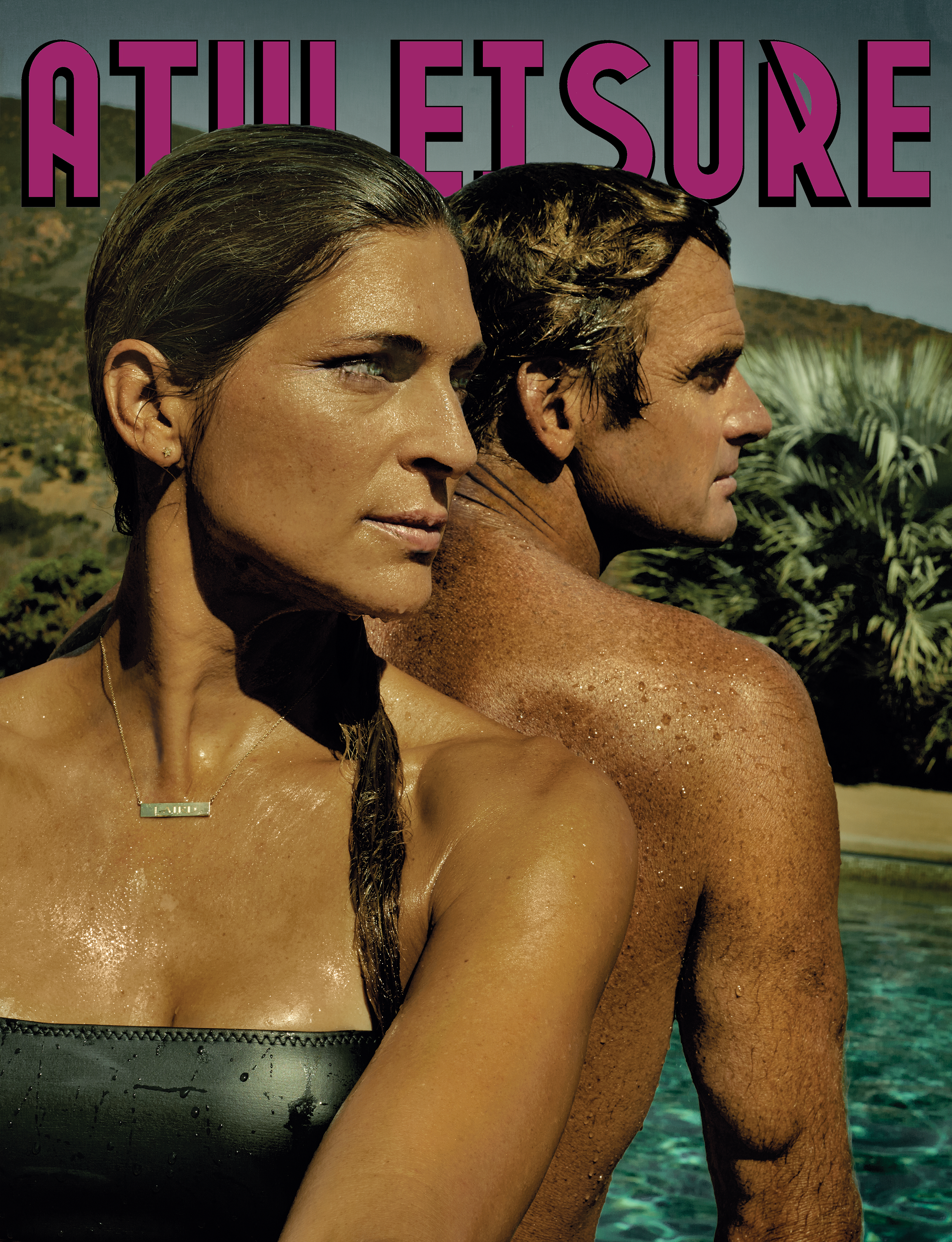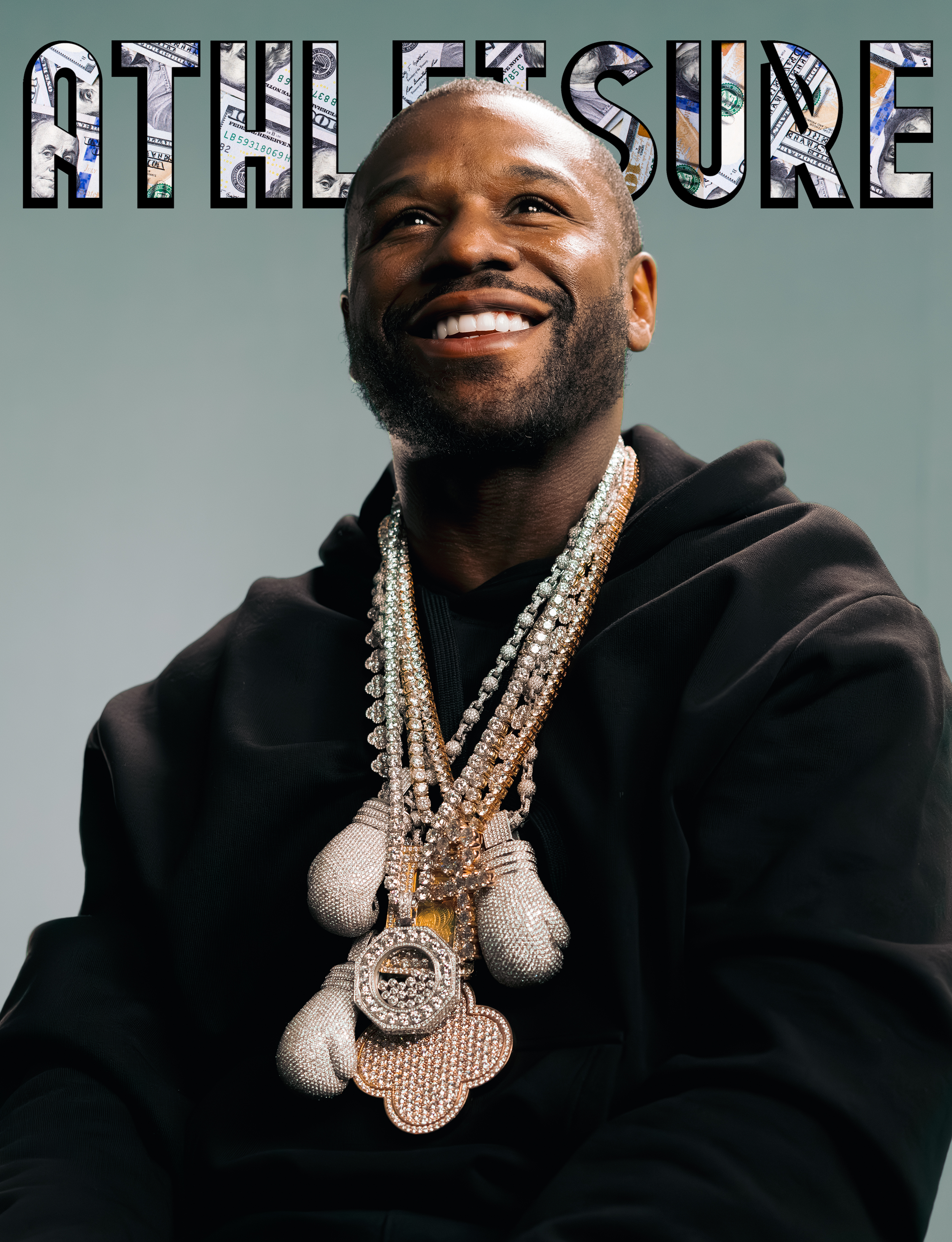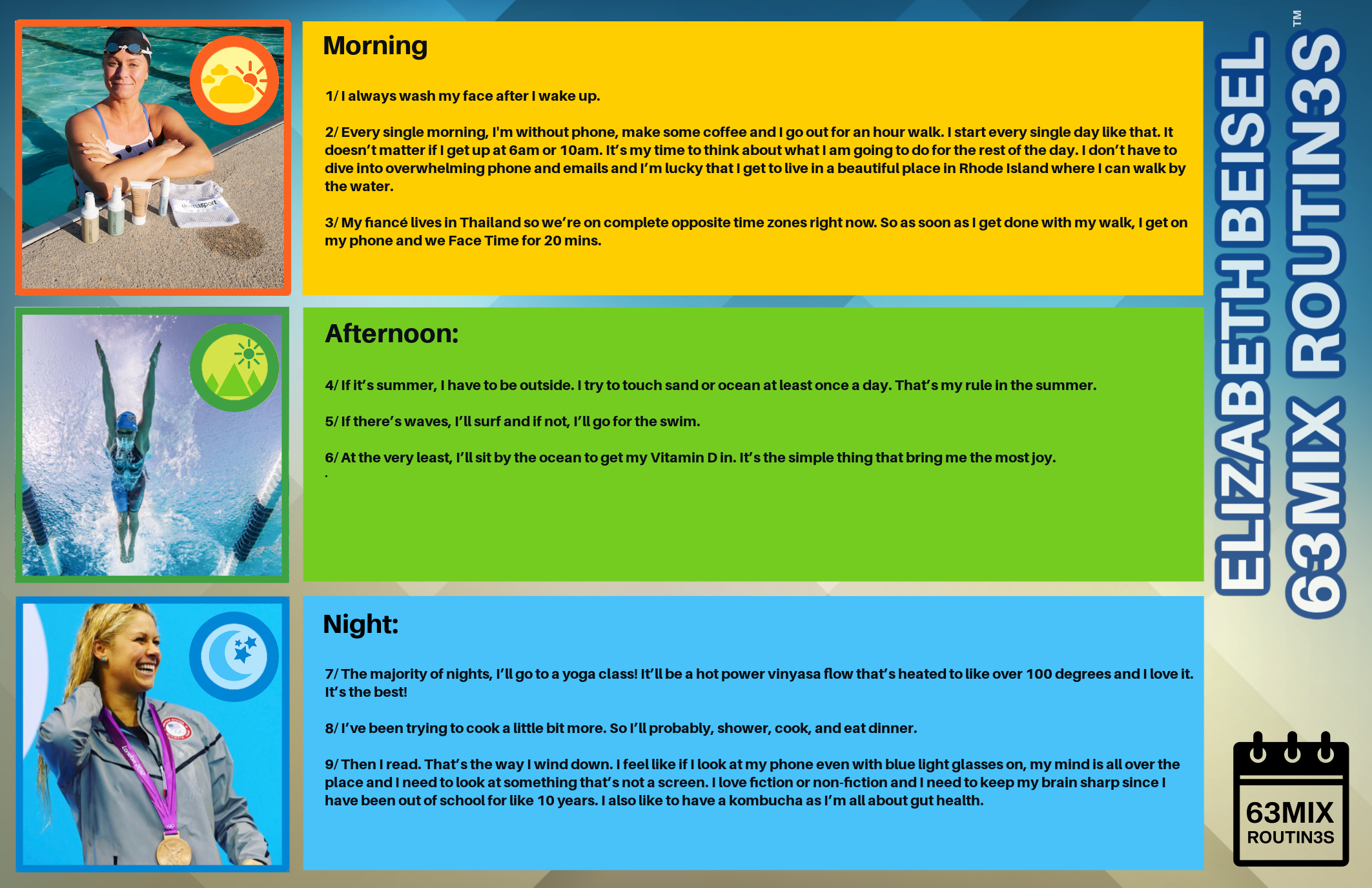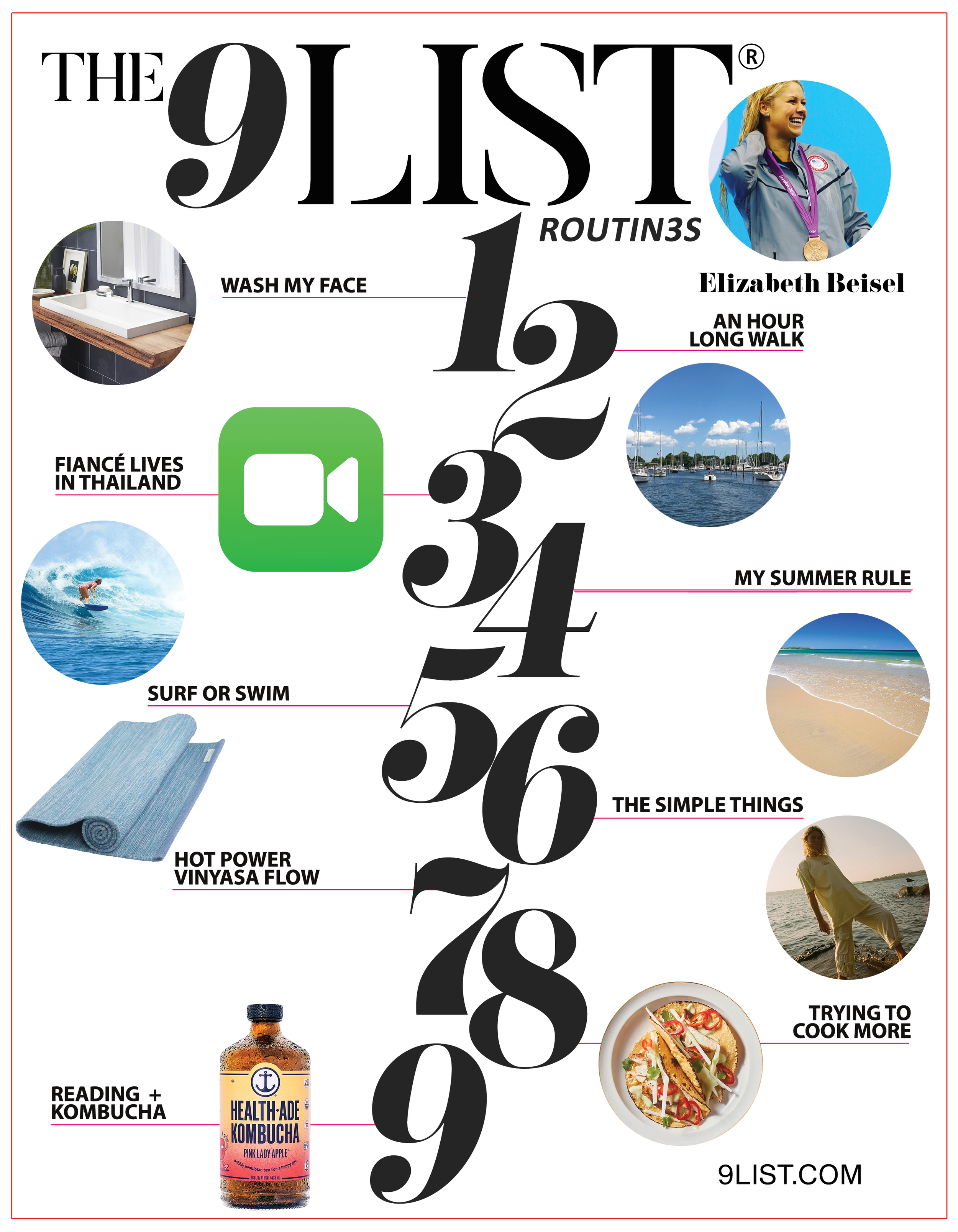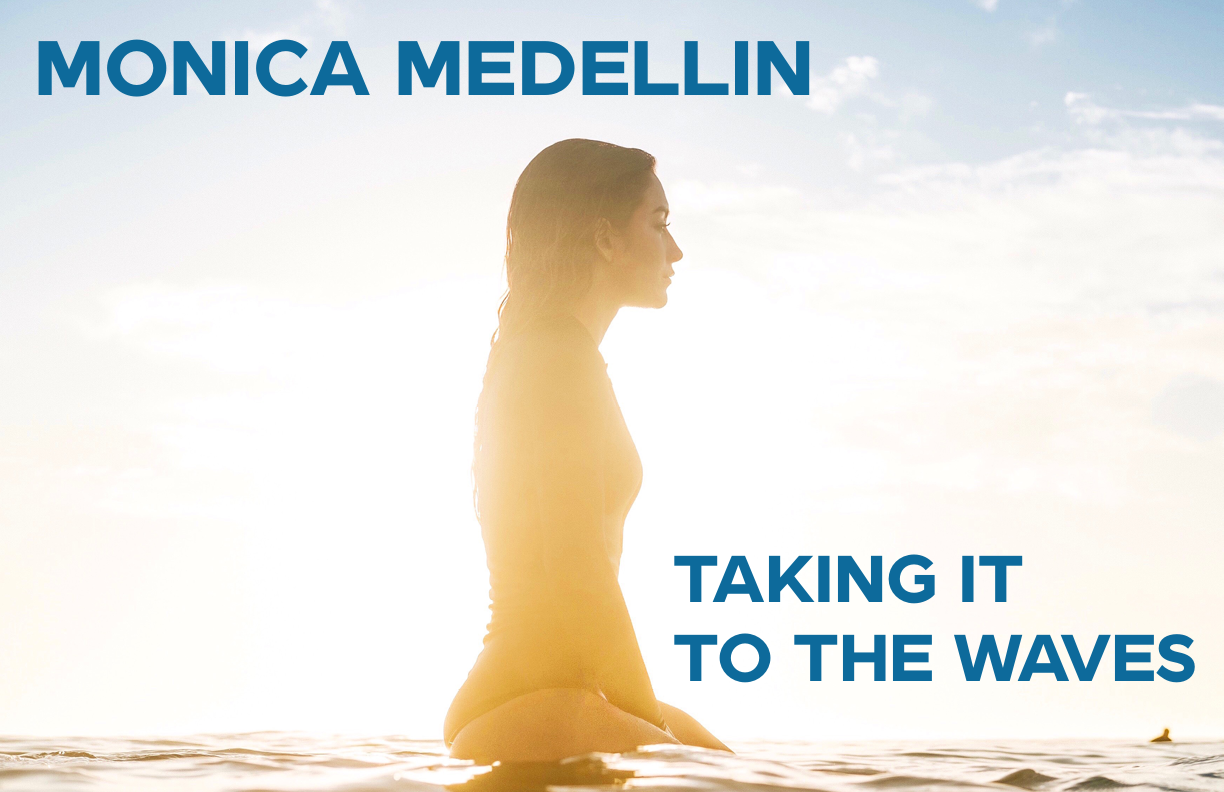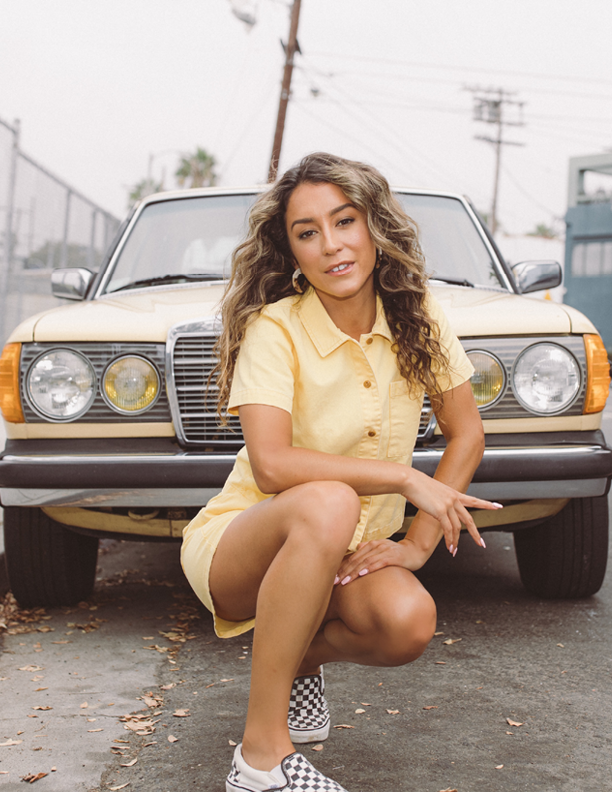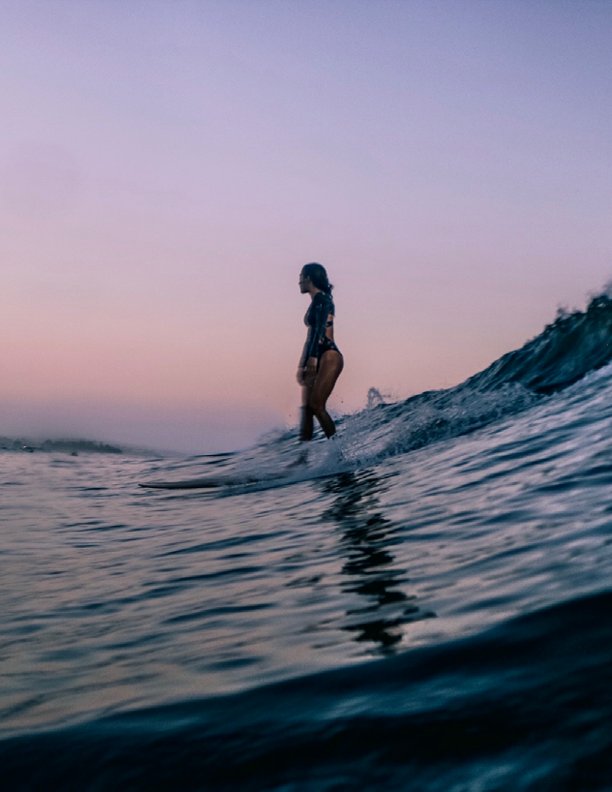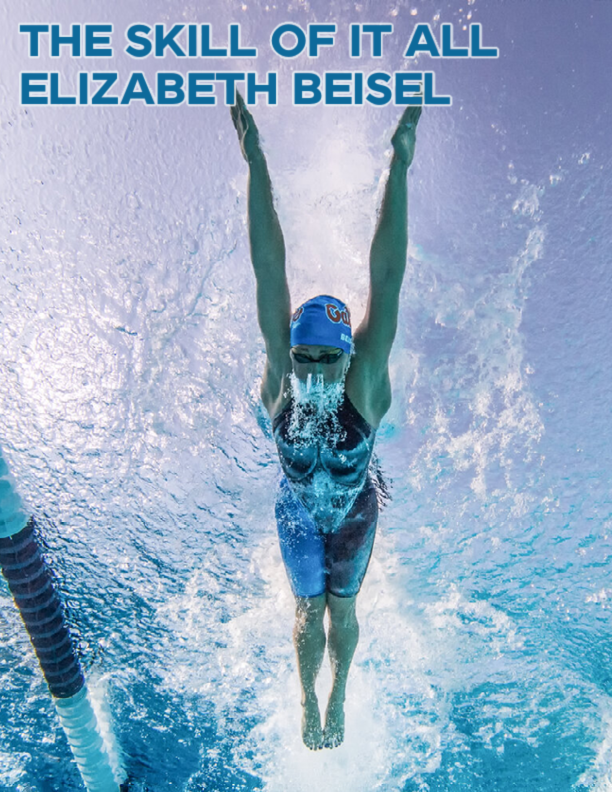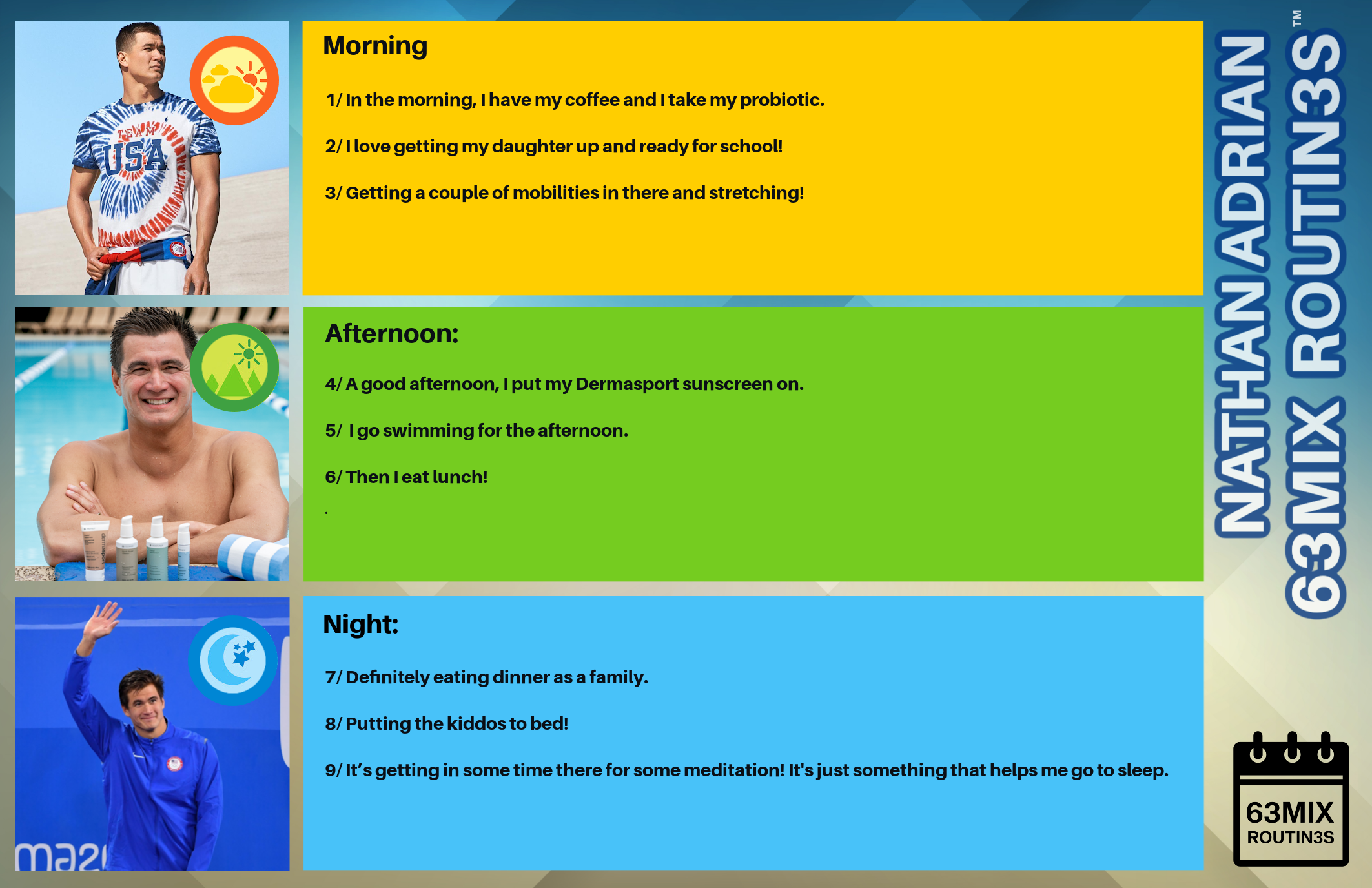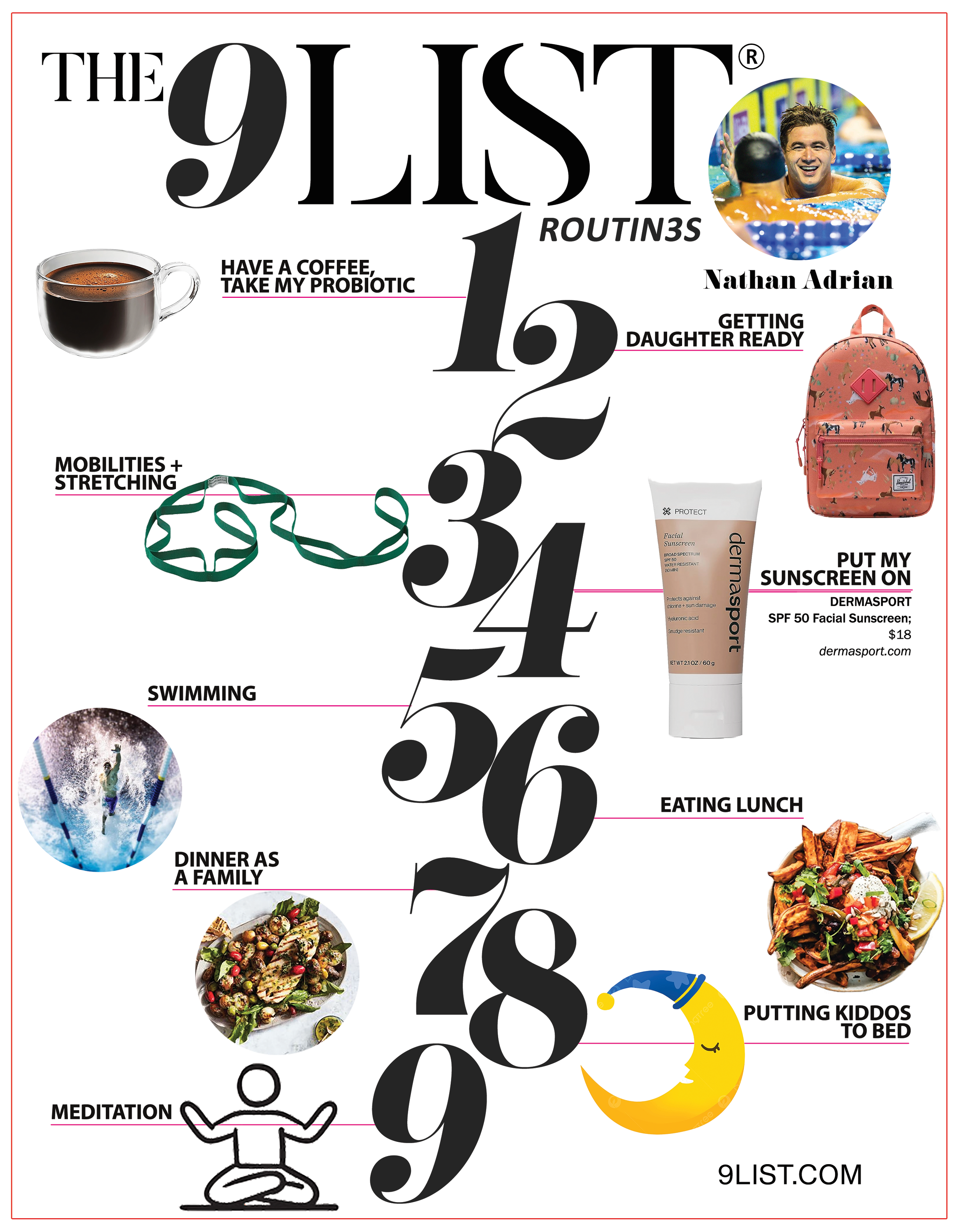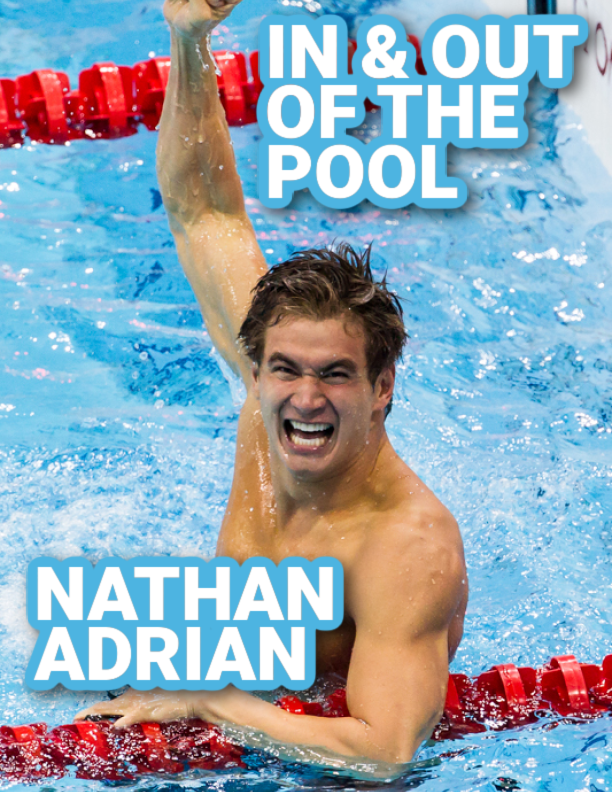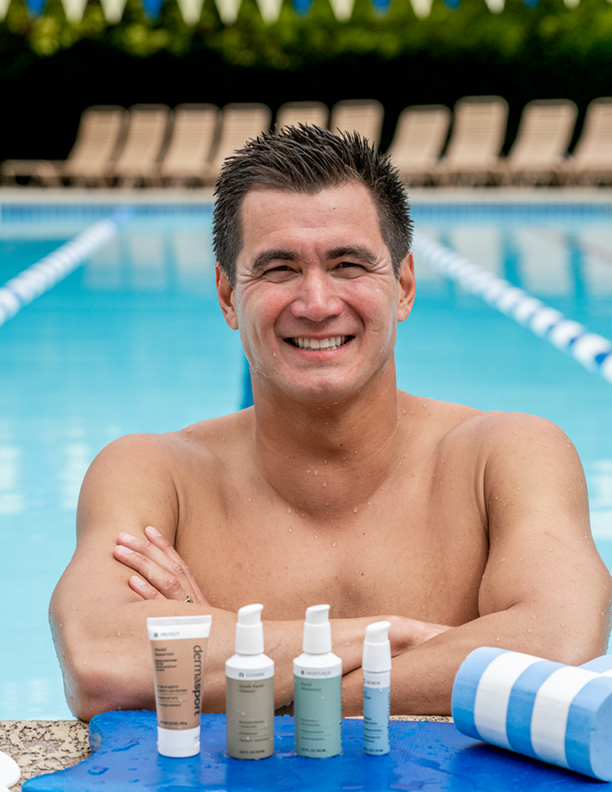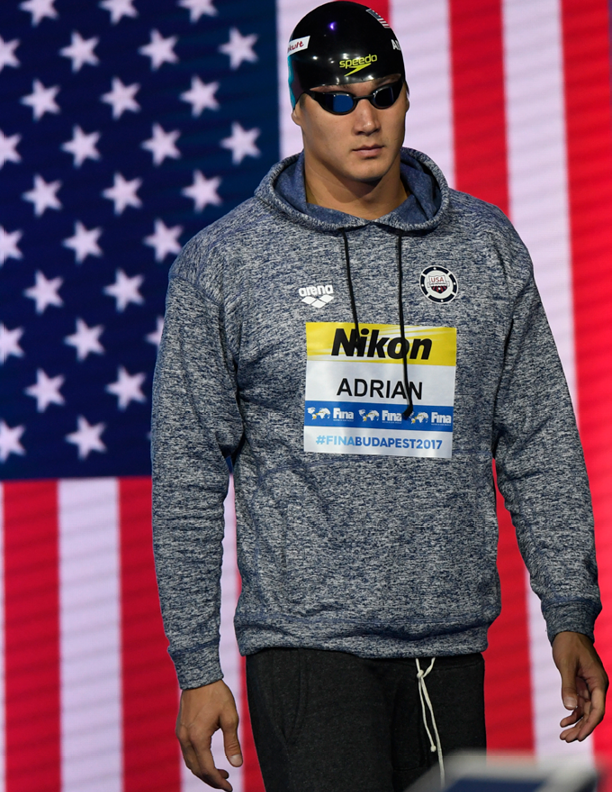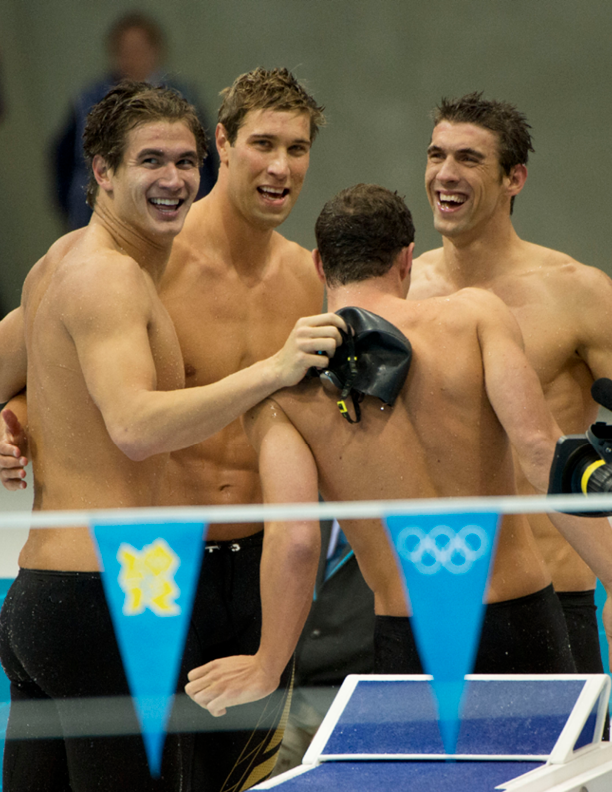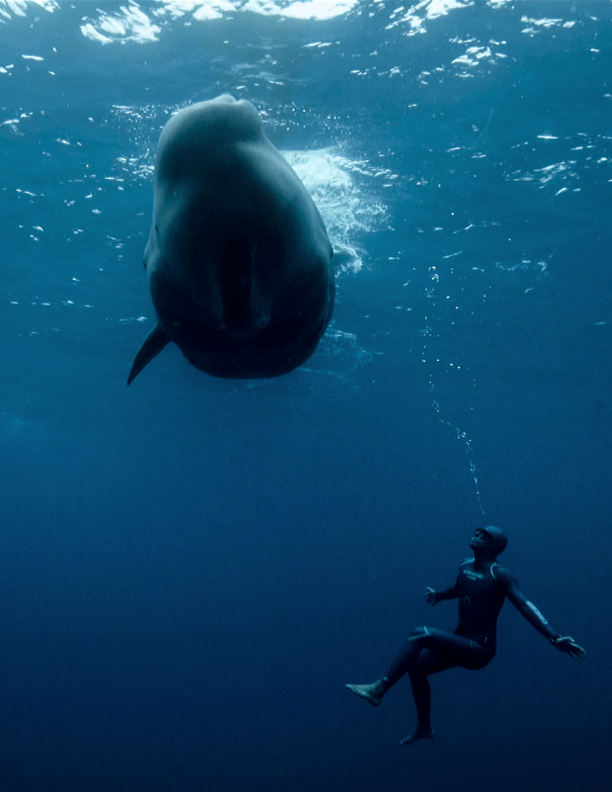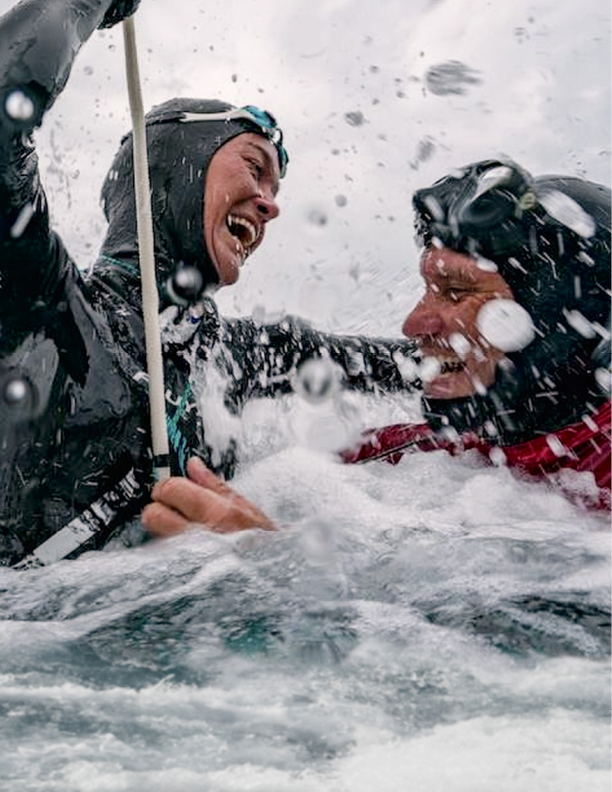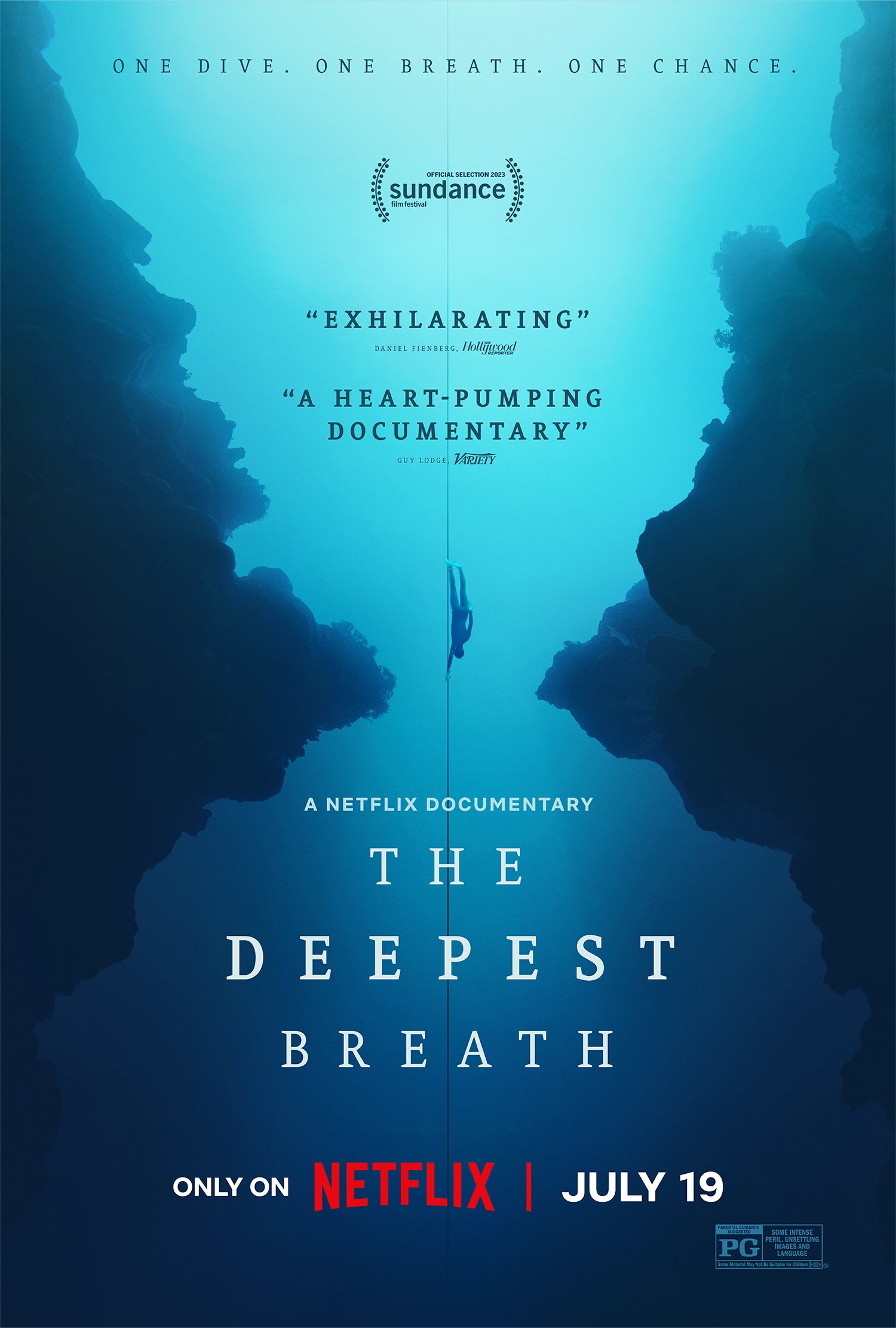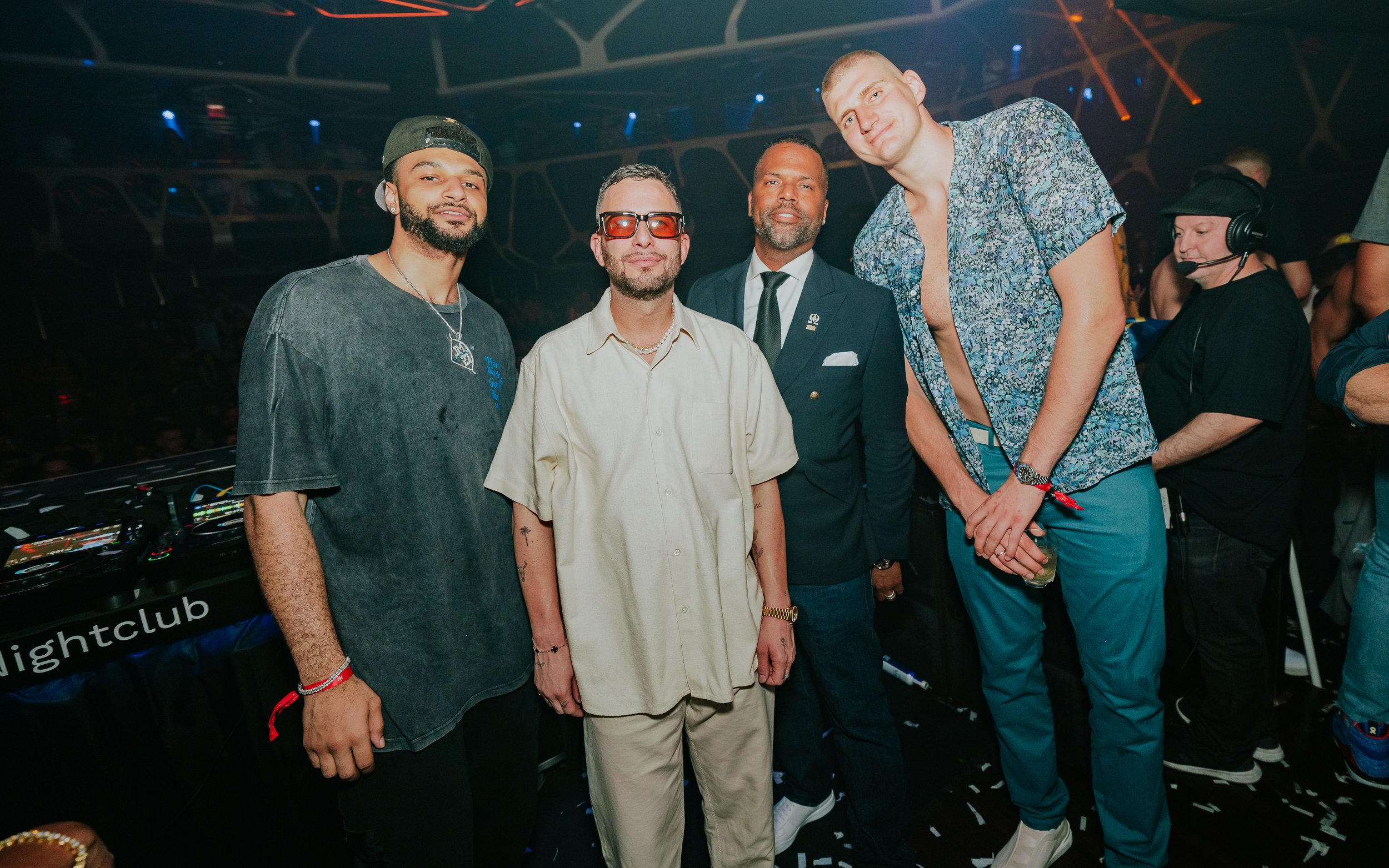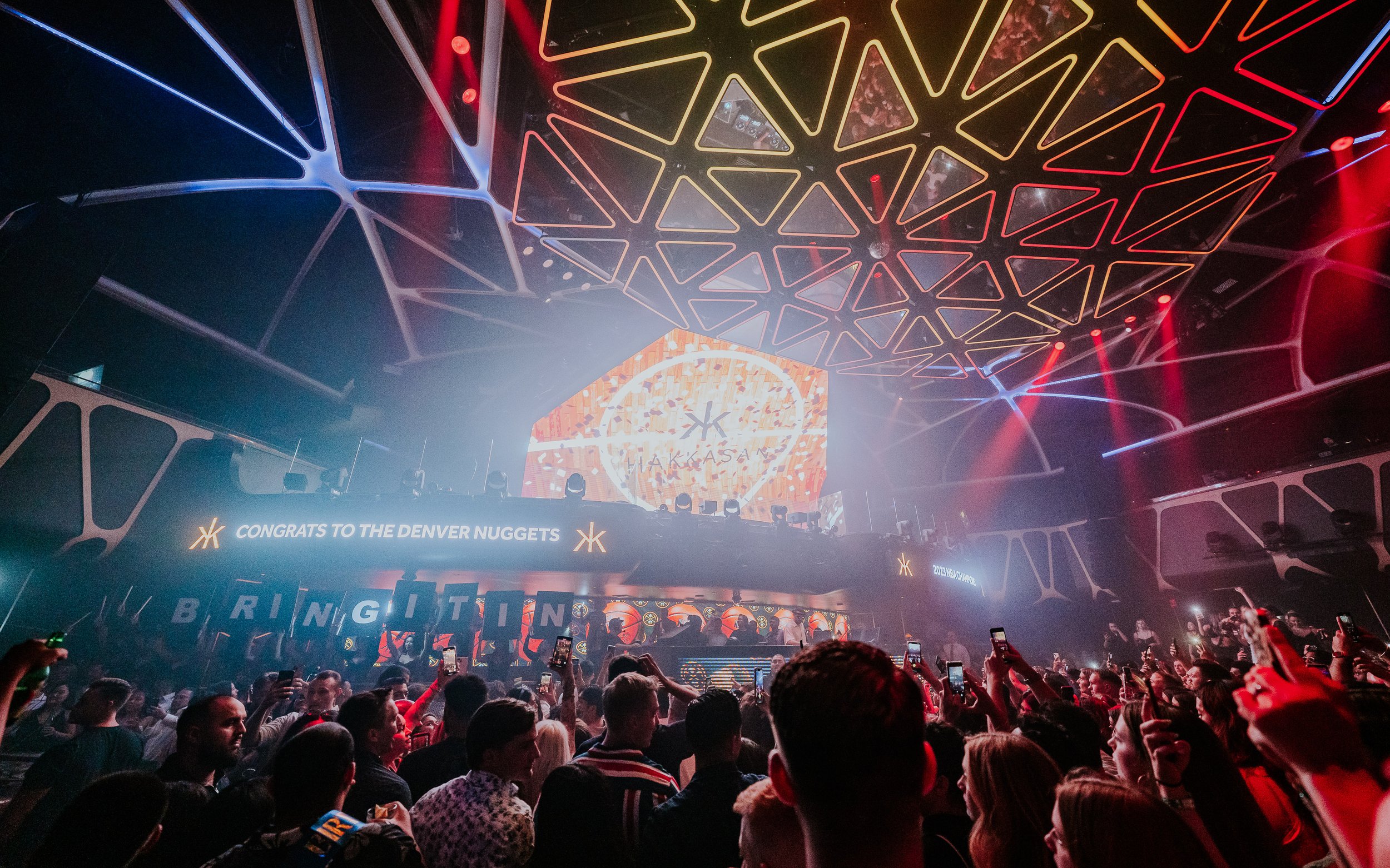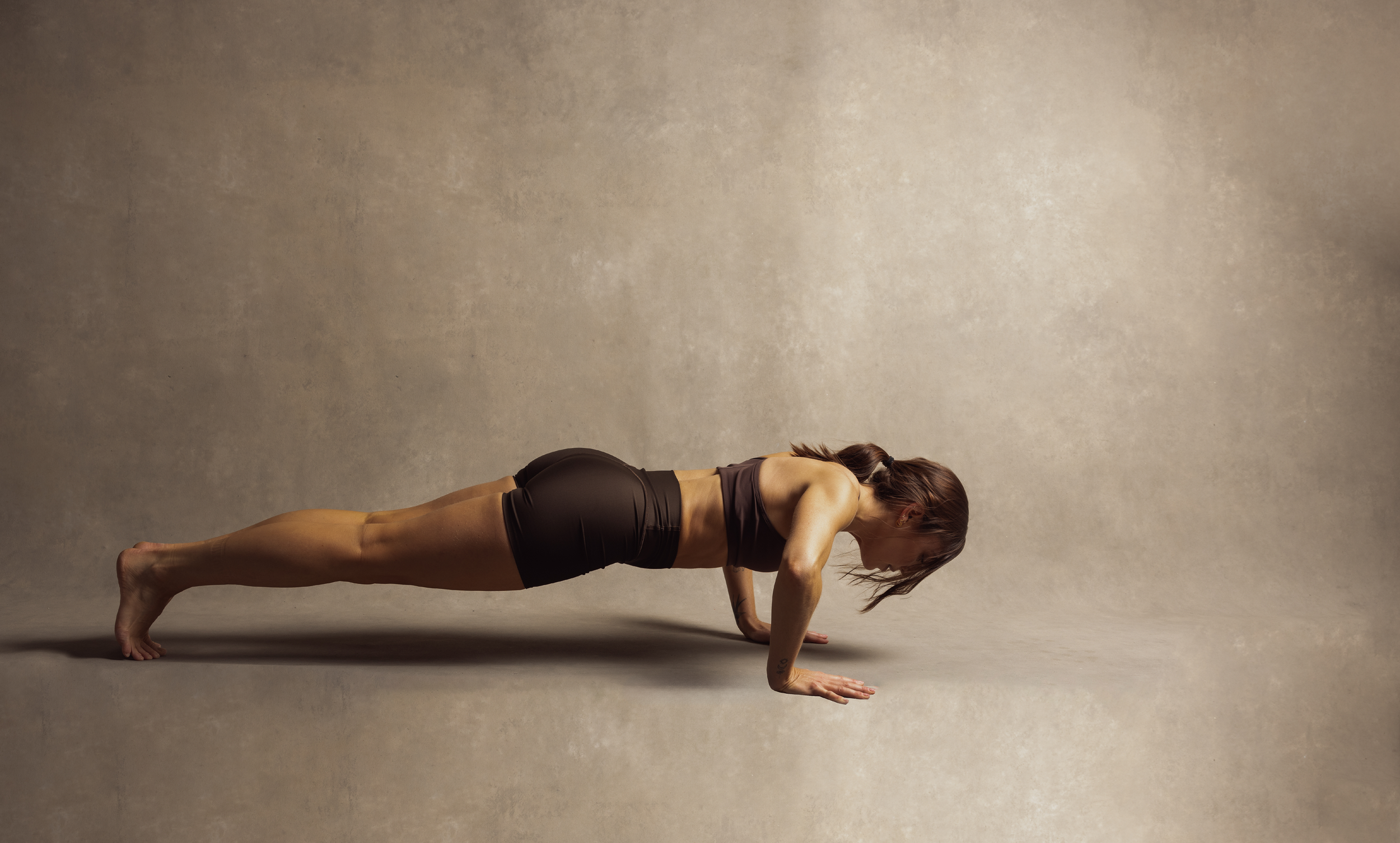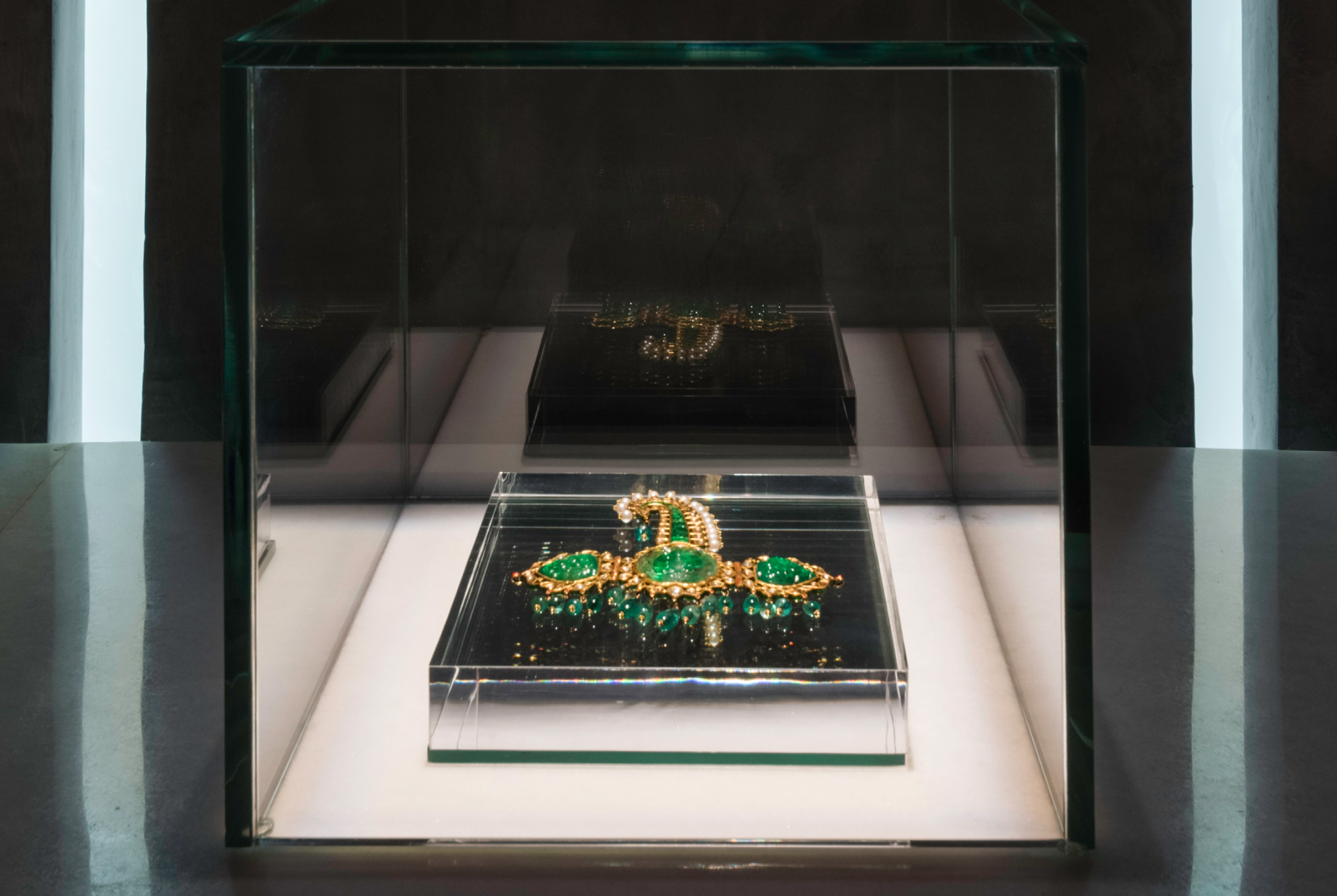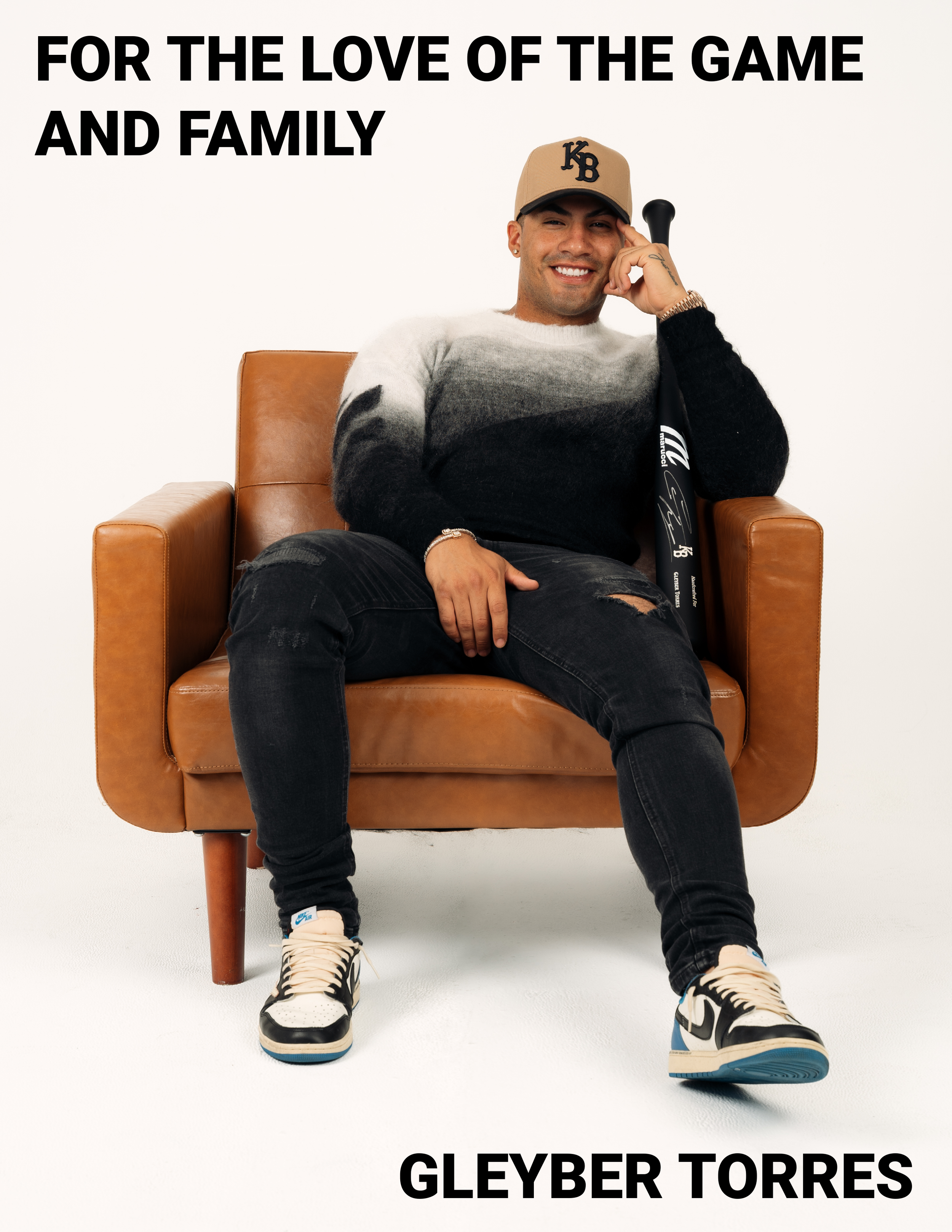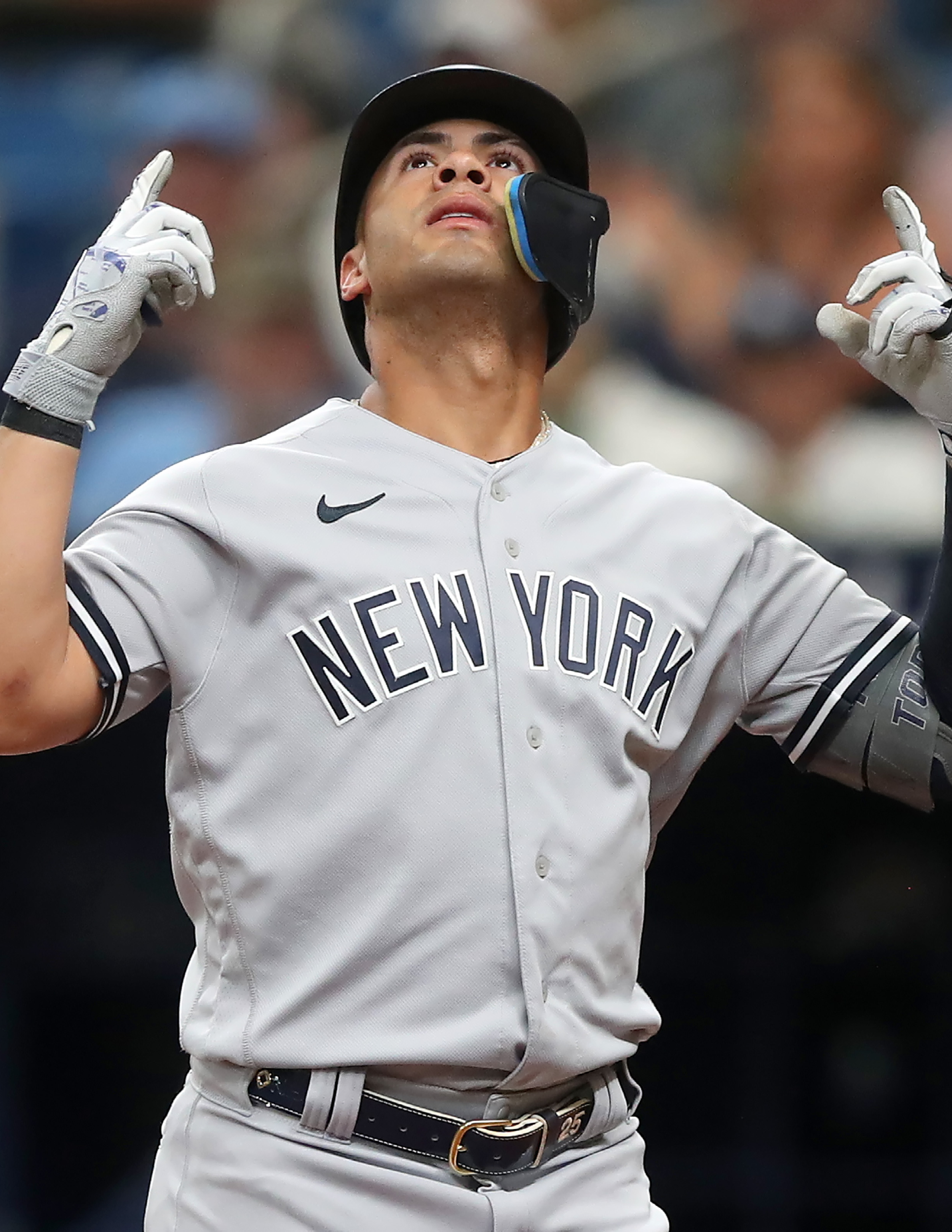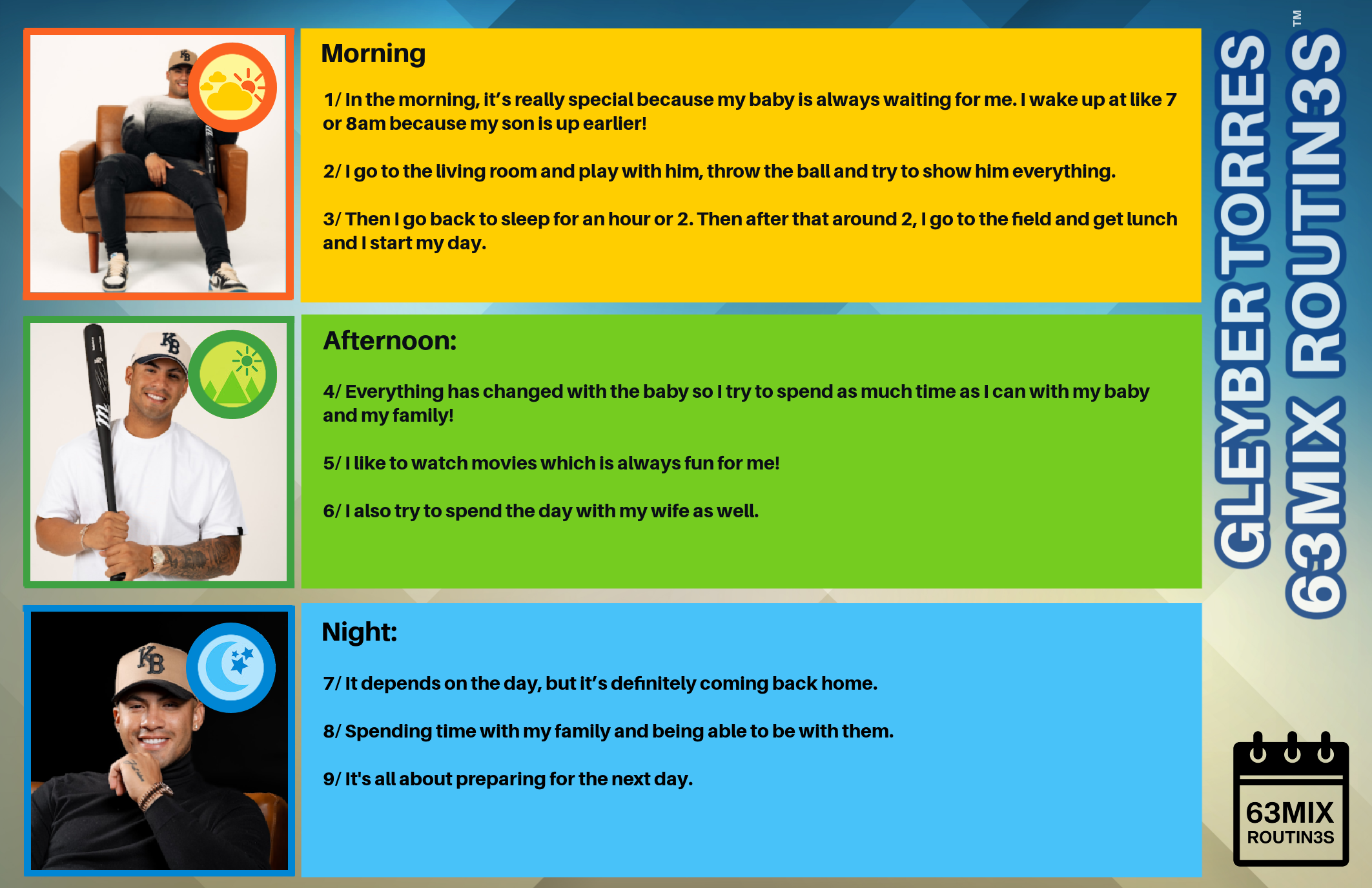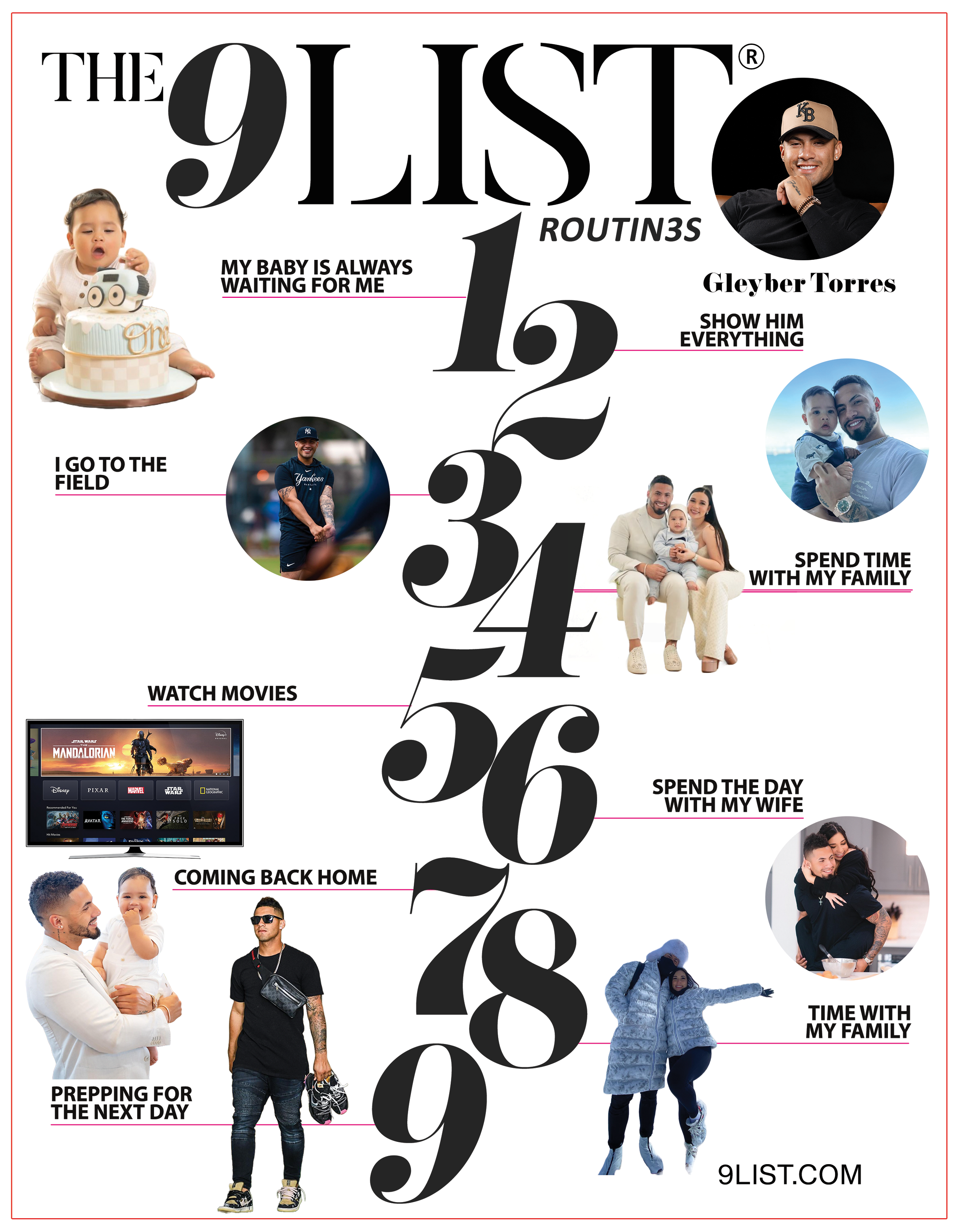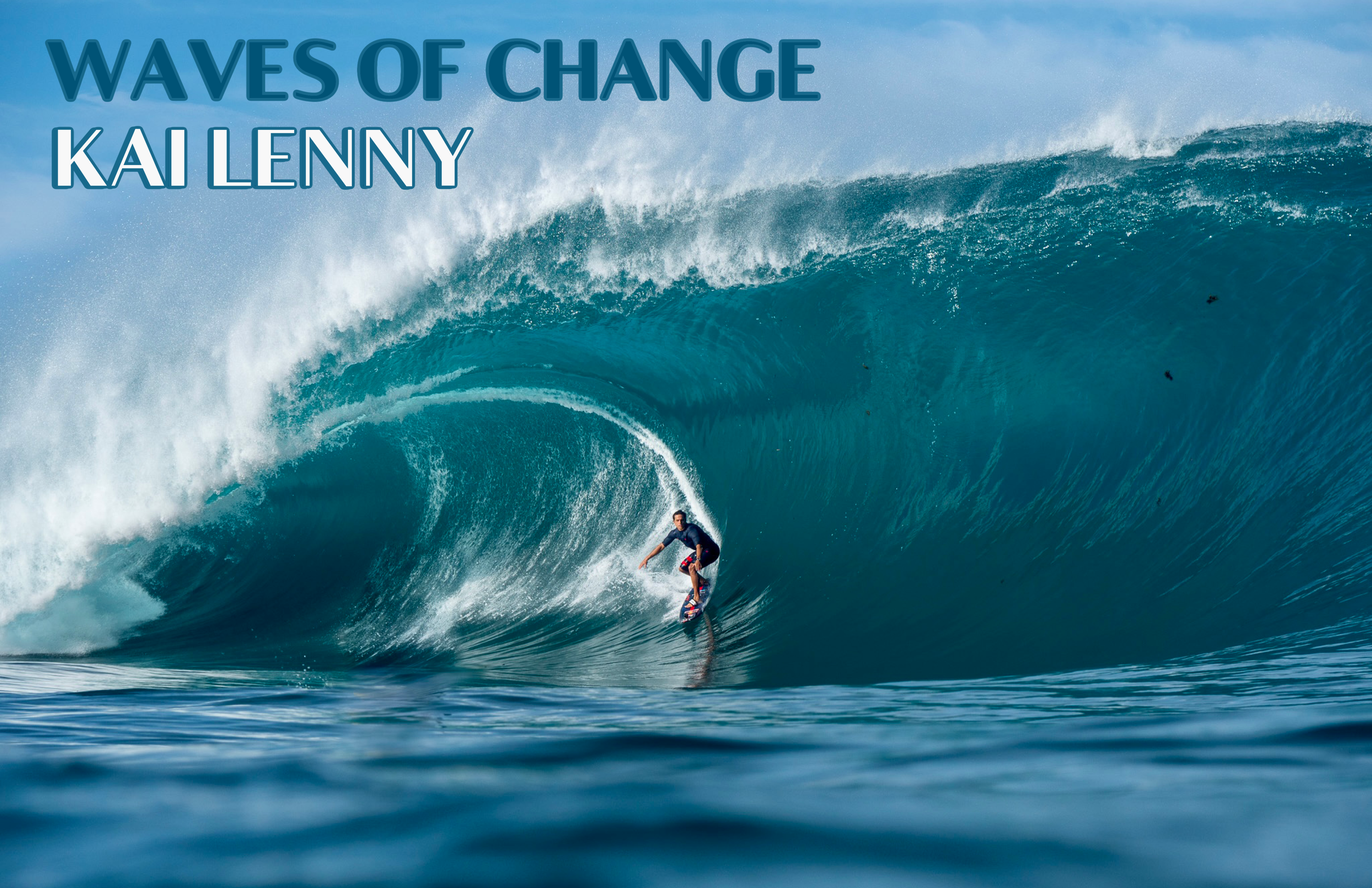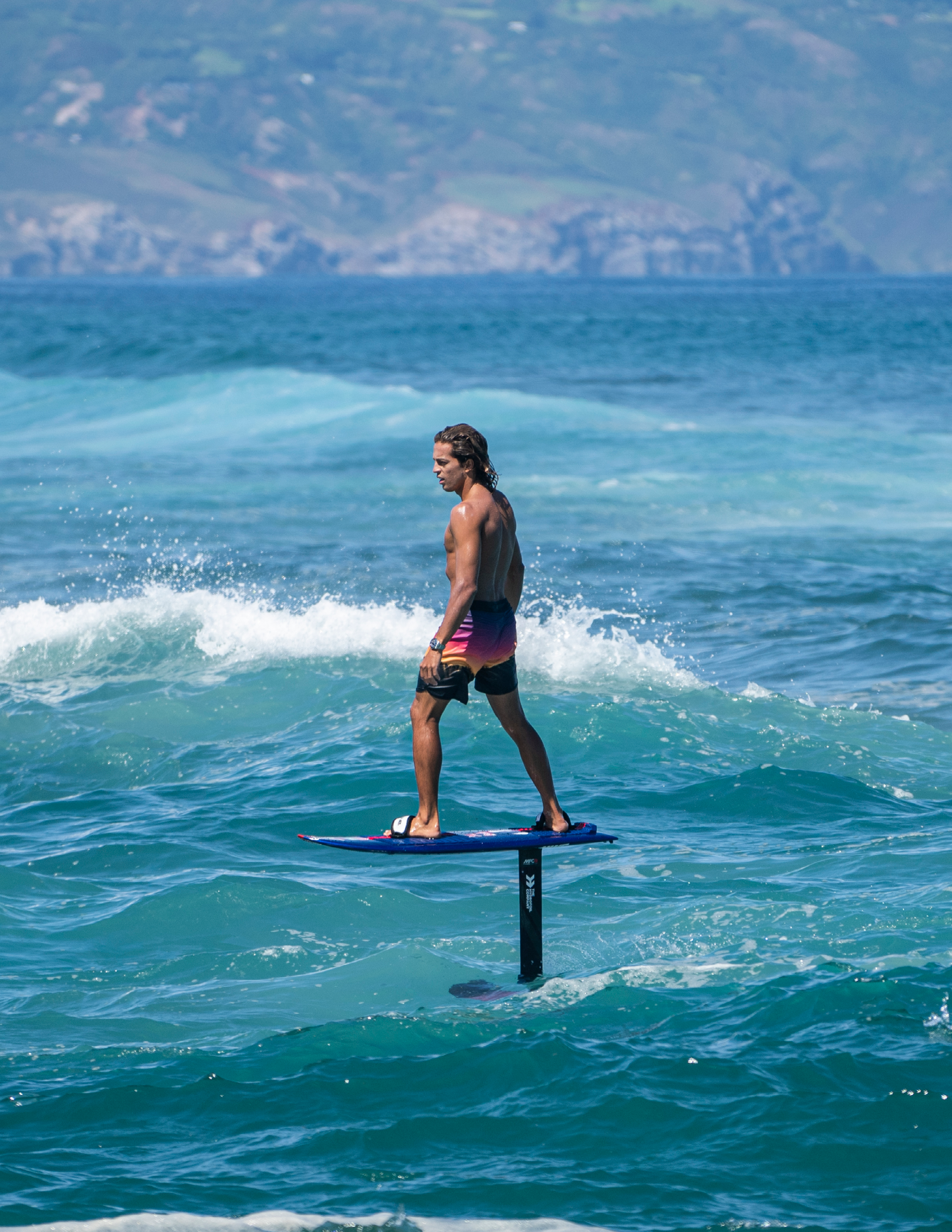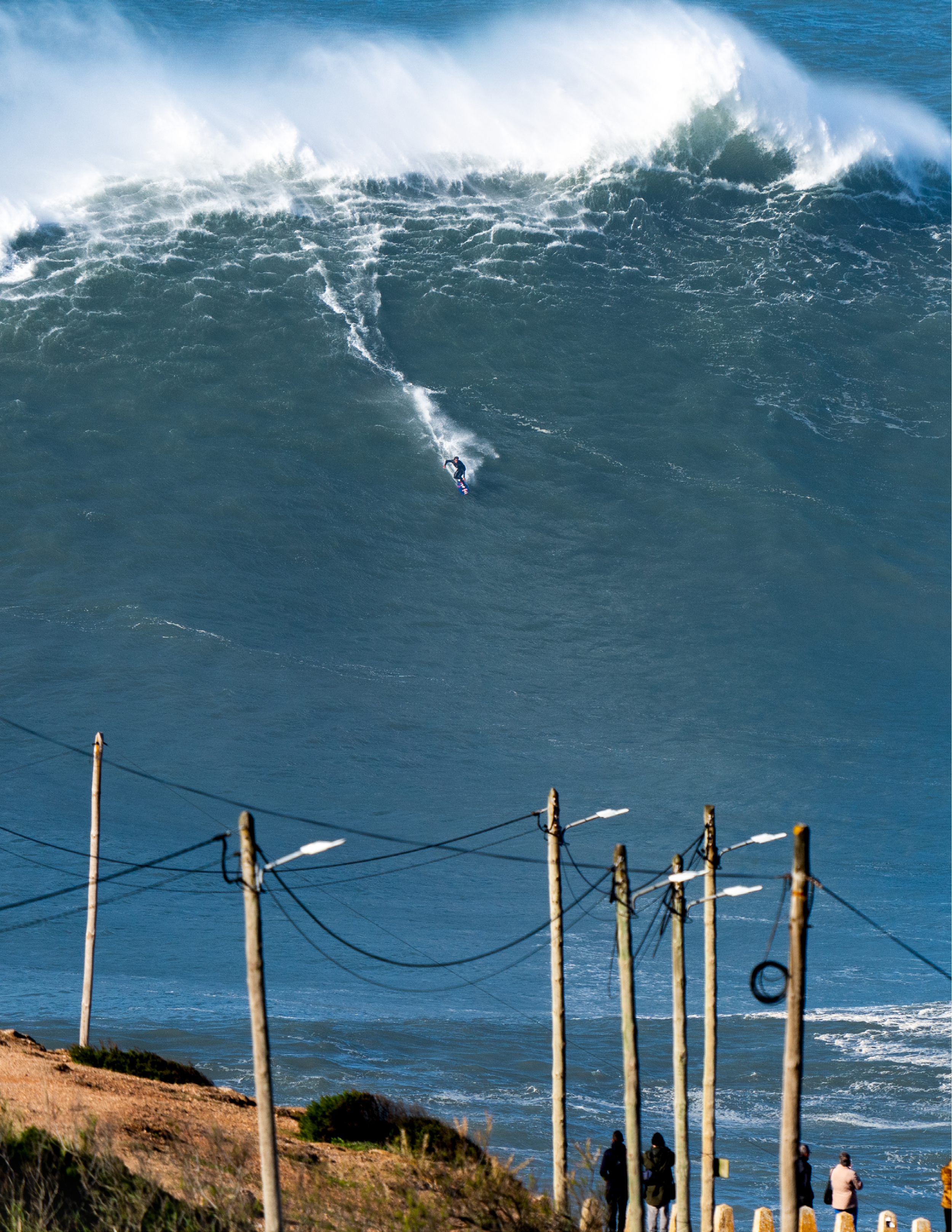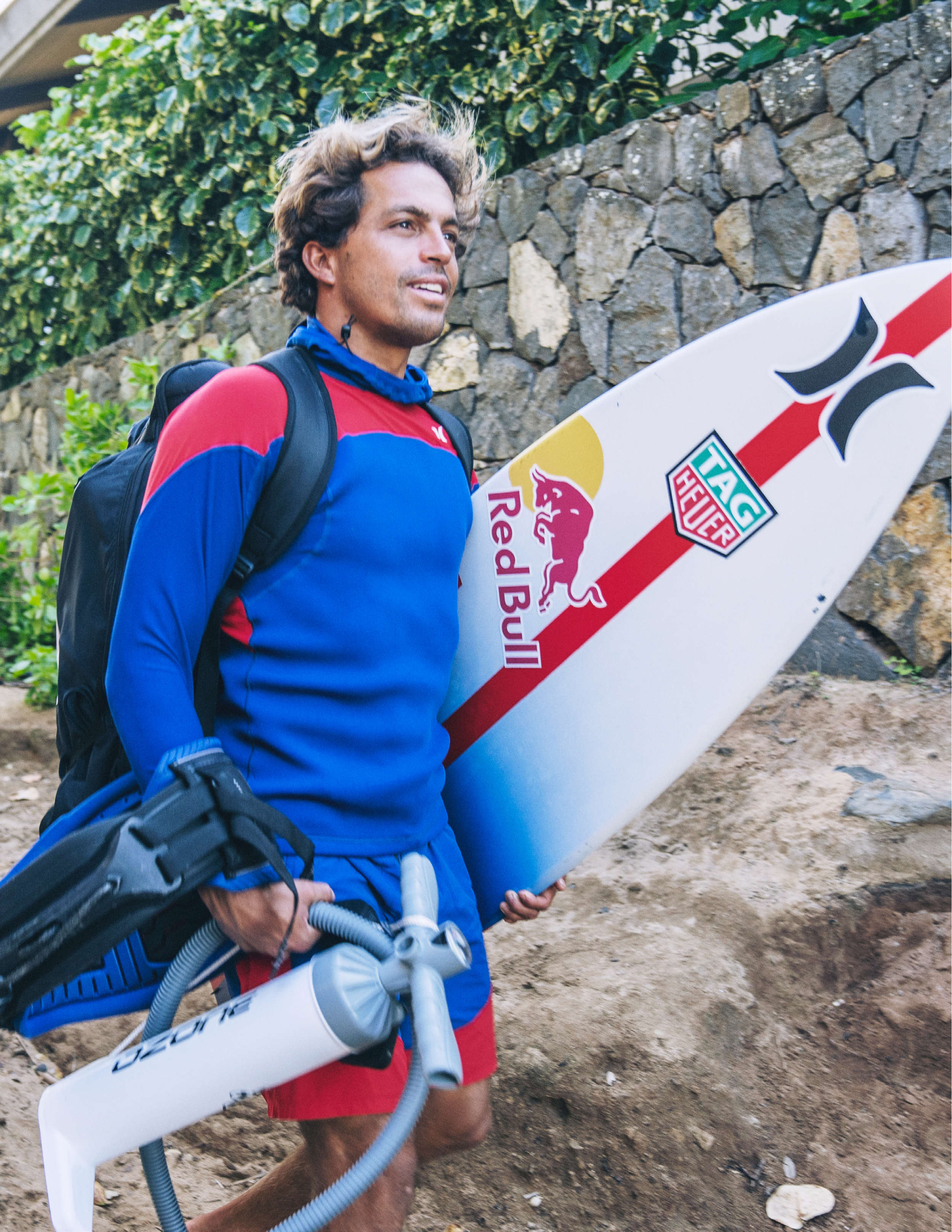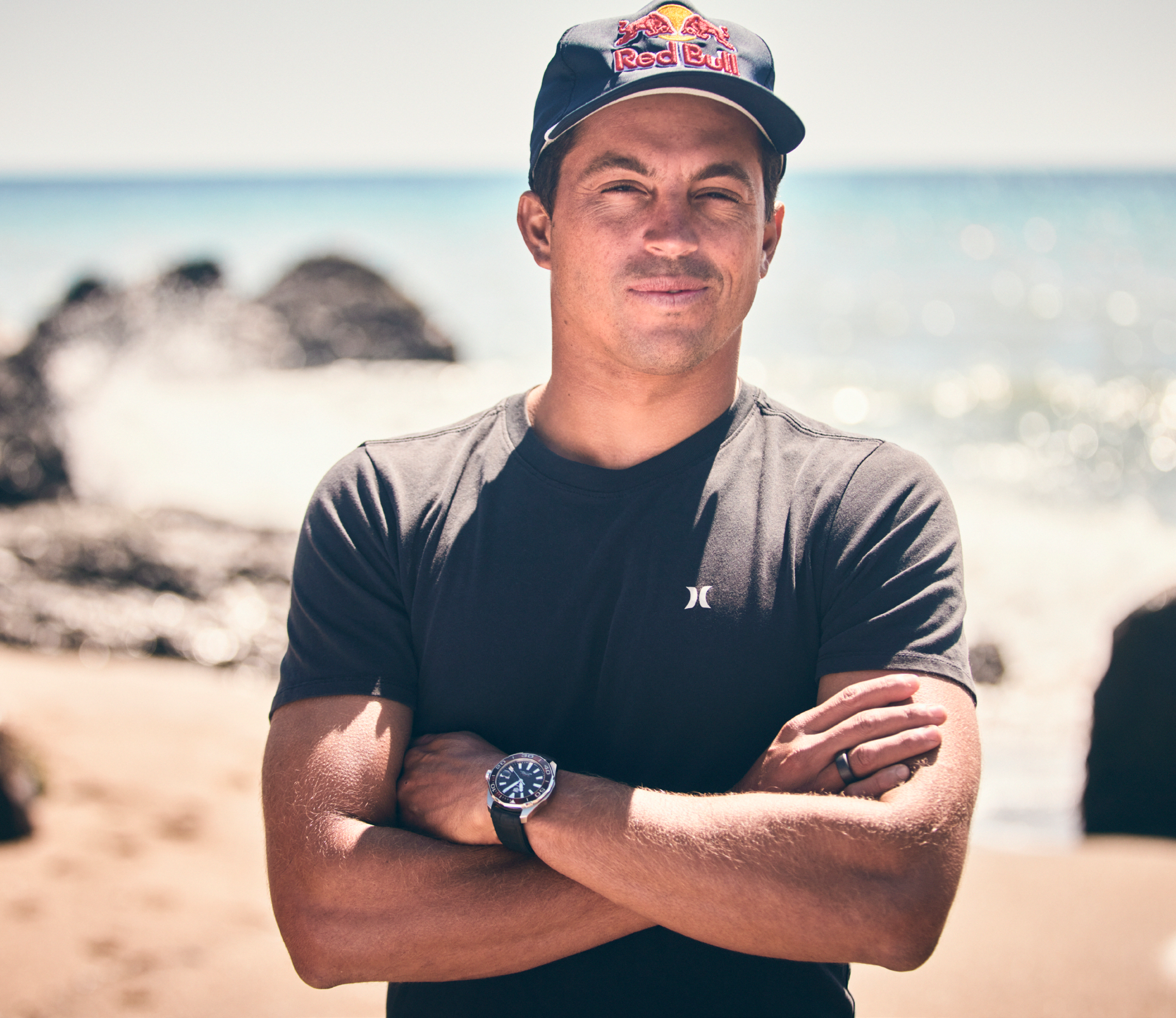63MIX ROUTIN3S | ADAM COPELAND
MAKING HIS MARK | ADAM COPELAND
As we look to close 2023, we're excited to have actor and legendary wrestler Adam Copeland! Many know him as a WWE Hall of Famer who wrestled under the name Edge for a total of 31 championships there and he held the World Heavyweight Championship between 2002 and 2013 7 times as well as the WWE Championship 4 times and a number of accolades while there! This year, he transitioned from WWE to the AEW showing that he continues to be dedicated to his passion and crafstmanship of this sport and doing it in his own name.
His love for wrestling is also shared by acting which is another way to fuel his creativity and dedication. Fans of his have enjoyed him over a number of seasons/episodes of Syfy's Haven, History Channel's Vikings, and a number of movies! Now, you can see him in his latest series Percy Jackson and The Olympians where he portarys Ares, streaming now on Disney+. We wanted to know more about how he got into acting, some of his roles that he has been in, being in the Disney+ series, as well as his phenomenal wrestling career. We caught up with him at home to find out more and you can read his thoughts on 2023 and 2024 in our feature NEW YEAR, N3W YOU!
ATHLEISURE MAG: When did you realize that you enjoyed wrestling?
ADAM COPELAND: Honestly, it was the first time that I saw it. I distinctly remember that it was Roddy Piper and this was the old black and white TV where you had to turn it with pliers, 3 channels, and one of the channels was CKVR TV from Barrie, Ontario. I didn’t know it at the time, but it was Pacific Northwest Wrestling out of Portland, Oregon. It was Roddy Piper and I still remember the trunks that he was wearing were like a creamy yellow and green tartan design and he smashed a beer bottle over his head. I just remember – my brain couldn’t process what this thing was, like this guy is a maniac, but I can’t take my eyes off of him. It just kind of blew my mind, because I was young and very impressionable, it just struck some kind of strange chord with me. I think it was because it was just this big larger than life kind of thing. I loved comic books – I voraciously read comic books. I love KISS because they were super heroes but you could go see them in concert. They played characters and so wrestling was that! I could go down to Maple Leaf Gardens and I found out where they came into the building so that I could accost them back there and bug them. So it really was from the first time that I saw it.
Then it was diving into it deeper and discovering Hulk Hogan and going, “woah, what is this guy doing?” His eyes and his energy! And then from there, it was the deep dives and discovering why I gravitated towards certain people’s matches. Like why did I always enjoy wrestling? Watching Bret Hart wrestle and then I guess as I got smarter, more educated to what the industry is, that’s when it dawned on me. I was like, “oh, it’s because he’s really great!” Got it!
Savage I mean, you’re looking at the Macho Man – he’s awesome, Shawn Michaels, Ric Flair, Ted DiBiase, Bob Orton – man, the flood gates were open!
AM: I grew up in Indianapolis and went to school at Indiana University, and we’d have our friends in our dorm watching the matches before we went out or after studying and I remember when I first saw you in the ring and it was explosive!
AC: That was the guy liner phase!
AM: Obviously you’ve dominated in your career as wrestler without a doubt.
My mom was a huge Highlander fan and I am as well. Seeing you in Endgame was great to see. When did you realize that you wanted to pursue acting?
AC: It was never on my radar honestly. It really wasn’t. The Highlander thing was just that WWF at the time said, “hey, there’s a small role in the next Highlander movie. It films in Bucharest. Do you want to go?” I said, yeah sure. It sounded like fun, it seemed like an experience and I had never been to Bucharest. That’s really all that was, but my entire goal as early as I can remember wanting to have a career, I wanted my career to be wrestling.
The acting thing was always like if something popped up, sure cool. It wasn’t until I was forced to retire in 2011 and then it serendipitously landed in my lap again and it was the Executive Producers of a show called Haven saw my retirement speech and they said that they were in tears. So they said that they wanted a tie into wrestling and a tie in to SmackDown and they said, “can we get that guy, he just retired?” A week later, I was up in Halifax filming and 1 episode became 41.
And in that process I realized, ok this still taps into that creative vein. And that’s the way that I am wired. I like to create. I like to tell stories. So whether that's writing or whatever it is. So I really really enjoyed the process. I really started diving into that because wrestling was off the table. So it was like, if my first love is off the table, all of these things come off of the same tree. It’s just different branches on where you go to on this or over on this one. So once I understood that I enjoyed this process and wrapped my mind around the differences too. With wrestling, I equate it to maybe standup or a band with a setlist that they change all of the time. You play off of and read off of your audience. It’s a really, really amazing thing. What I had to get used to in terms of acting was thinking that a take I did which was really, really good – and then they may not use that one.
AM: That’s true.
AC: Then a year and a half later, you see what takes they use and you look at it and say it’s interesting. I had to wrap my mind around that.
AM: Especially since you can work with one director and they think that that was amazing, but the next director or producer wants and looks for something that’s completely different.
AC: Entirely different! I pretty quickly learned too that if a director has an idea, my job is to try and bring that vision. It’s not really my vision because I can have a certain way that I think that I am going to do things, but on the day, it can be entirely different from the set up, the angles, and all of those things. The director is going to get the shot that he or she wants so you mght as well try and dive in with them to get it!
AM: I really enjoyed Vikings! What drew you to that show?
AC: It was my favorite television show. I loved Vikings. I’d sit down, I’d watch Vikings. I was on Haven for gosh, the first 4 seasons and Vikings was in production then. So once I wrapped with Haven and the show ended, I said to my manager that we needed to keep an eye out for Vikings because if something came along there, I wanted to try to pounce on that. An audition came along for it and again, it was kind of like Haven where the character was only supposed to be in 4 episodes and then before I knew it, Michael Hirst (Elizabeth, The Tudors, Vikings: Valhalla) who is the creator and the writer who wrote all of the episodes, he said we need to write more for Kjetill and I said, I’m in.
AM: I love that show and my sister and I watched a number of episodes together.
AC: I loved it too! I can’t show the girls that one, but I really loved that show. I loved the challenge of a period piece, accents, drama, and those were all things that I hadn’t delved into before. So that was super exciting, the challenge aspect of it, because I love a challenge. I would get my scripts and phonetically write everything out. Ok, there’s a hard ‘s’ here, it’s not ‘is’ it’s ‘sss’ and then I would run my lines. So it became second nature and by the end, I didn’t even think about it and I would end up talking like that in between takes.
AM: Percy Jackson and The Olympians is streaming now on Disney+. What drew you to this 8 episode series? How did you get attached to the project?
AC: So, when the books first came out, I was on the grind. 220 shows a year which means you’re generally on the road 250 days a year. So from the years of 1999 – 2011, I didn’t catch a lot of what was happening in terms of social media and mass media. It all kind of flew by me. So I didn’t fully grasp how huge the books were and I’m kind of glad that I didn’t. Because the audition came through and I was like, “oh Percy Jackson – that could be interesting, ok.” I thought that they had made a couple of movies and that was the extent of my knowledge. So I read for the part and I sort of went, “oh, ok this guy, I think that I know this guy.” I found the comedic beats in it. So I wore one of my Edge/Adam Copeland vests and I wore my Andre the Giant T-Shirts cut off. I have never dressed up for an audition in my life, but I thought, what the heck? I shaved my own head, I had my own little mohawk and I read for it and had a lot of fun with it. It was really funny but Beth said, you had a lot of fun with that and I feel like you found that guy. I agreed, but then you have to throw it away because once an audition is done, you have to stop thinking about it. You can’t dwell. About a month and a half, maybe 2 months later, my manager said, the Executive Producers of Percy Jackson want to do a Zoom. I was like, ok and I was trying to remember when I had read for that. I forgot. Then, sure enough, they were like, “when you get out to Vancouver, -“ that’s when I realized that I had got the part! I told them that I was still wrestling for WWE and they said it didn’t matter and that they would figure it out.
AM: Wait, what?
AC: Yeah, that’s unheard of! I guess they had seen my audition and thought, "he's the Ares that I pictured when I wrote him.” That was a huge boost of confidence too.
I hadn’t read the books yet, but I had found the voice of this character in just reading the sides. That was super fun and then I read the books. I was like, “oh man, these are awesome!” Then learning that over 180 million copies worldwide were sold and it made me really glad that I didn’t fully dive into that knowledge before I read it. I mean I think it would have felt like a different kind of pressure I guess!
AM: Of course! It would be like stepping into Harry Potter without having the awareness of the weight of that franchise and then finding out after being in it.
AC: Oh yeah! Even when I got out to set and realized just the scope and the magnitude of this world, it was really really kind of jaw dropping. But it was such a blast and having seen – as I have only seen the first 2 episodes as well, but I watched them with my little girls who are 7 and 10, they have now watched it 3 times. They absolutely love it and watching it with them and seeing how they react and how much of a smile it has brought to their faces already, I am so proud to be a small cog in this giant machine to bring this thing to screen because seeing the kids reactions have been so massive and so much fun for me especially at this stage in my life, 50 years old, 2 kids and this is something that they can watch. I’m so proud to be part of it. The quality of it, it’s such a good show.
AM: How much can you say about the show as some people who are not reading this may not have seen this yet. What can you say in terms of the backstory? Also, we know who Ares is, but how are we seeing him as it is portrayed in this series?
AC: This adaptation of Percy is very true to the books. I think that that is something that movies weren’t. I don’t think that Ares was in the movie, but he is essentially the antagonist in the 1st season of this series. So there is a lot of big holes there with him being so heavily involved in this. I think that for the fanbase, they can take some comfort in the knowledge that Rick Riordan (author of the Percy Jackson series). So from a fanbase perspective, that’s huge!
If you’ve never read the books, you can watch it and get it. It explains itself really well, just like the books do. Within the first 3 or 4 pages, you get what’s going on here. It really brought the character traits together. Walker Scobell (The Adam Project, Secret Headquarters, Blood Knot) is so good as Percy. He has just the right amount of charm and sarcasm. The kid is on his way. He is just so good and at his age, he’s 14 now, but when we filmed this, he was still 12 – ridiculous for him to pull off what he was able to pull off. Just ridiculous to watch all 3 of them Leah Jeffries (Empire, Beast, Something From Tiffany’s) and Aryan Simhadri (The Main Event, Spin, Cheaper by the Dozen) and in between takes, they would go to school. Then they’d come back and they would do another take. Or they would do my coverage and then they would go do a lesson. How are they computing all of this? I don’t remember what I had for breakfast and they’re pulling all of this off. I really can’t say enough about all 3 of them and their work ethic and really just the entire crew! It was a really good place to work even in the time that I was there.
In terms of Ares, he’s – I love him, I really do! He’s just acerbic, a little caustic, he’s angry and a little over his head while being all powerful in a way too. It’s fun to play those beats. Because if he was just a god, this omnipotent thing, how much fun is that? Even when I was in Vikings, ok, this guy goes insane. But you can’t just go insane, there needs to be a reason for that. If I can bite into that, Adam Copeland can bite into that, then hopefully, I can pull out some truths for the character.
With Ares, it’s the classic, he’s the child that feels like he should have gotten more attention and now he’s acting out. He just happens to be in a 6’4” 240lb frame and he’s a god and he has a giant sword. It made for a lot of really fun scenes – and scenes that weren’t in the book and that added more depth into the character. My favorite scene that I was involved in takes place in a diner with Grover Underwood (Aryn) and it wasn’t in the books at all, but it was a really, really fun scene to play off of each other with.
AM: The cast as a whole has incredible actors that are in this alongside with you. What did you take away from this whole experience?
AC: I think that more than anything, it was just, I don’t know – to be 50 years old and go, “right, I’m still wrestling – I’m wrestling again and I’m also working for Disney.” What? When I first started this and started training for wrestling at 17 years old, if you had told me that at 50, A – I’d still be wrestling and B – I’d be working for Disney at the same time, I’d have asked you what are you smoking and can you give me some because that sounds amazing.
Sometimes I just sit back. We did the red carpet for the premier last week and I brought the girls and Beth up with me. Just to see the excitement that they had to be involved in this thing and I think that I actually became a cool dad for about a week!
AM: You know, just walking the red carpet with my dad!
AC: I’ll take it, I’ll take it!
AM: I mean I think back to a lot of the things that I did physically when I was younger and being 44 now, there’s no way that I could do the flips and turns that I could do before! The fact that you’re still doing that, I couldn’t imagine it for myself, so I tip my hat to you sir!
AC: Well, a lot less flips for me now ha!
AM: There’s that, but still! But you’re still out there doing it!
AC: I am!
AM: Are there any upcoming projects in terms of acting that we should keep our eye out for?
AC: With the strike, everything just got put on hold. Then, within that strike, I had transitioned from WWE already and went into AEW, so there has been a lot of change, but all for good! My creative spark has really – not that it wasn’t lit before, but now it’s like woah! I have a blank canvas that I can paint all kinds of different palettes and things that I can use now. There’s a whole roster that I never even touched or told stories with. So that’s very exciting for me.
With acting, I’ve pretty much said since day 1 to my managers and agents, I say no a lot! I don’t even read a lot of stuff. It really has to hit because why do it otherwise? If it’s something that’s meh ok, and maybe it isn’t right or the method that you should use, but a lot of time it’s about who is involved. I would love to work with Kelsey Grammer (Frasier, Boss, Dr. Death) – yes, my mom’s favorite actor. She passes away 6 months later I get offered to play in Money Plane with Kelsey Grammer. I didn’t even need to read the script, I was in. Really more than anything, it’s about what is going to be fun. At this stage, from the time I was 22 on, I don’t feel like I have worked. That’s a gift and I didn’t realize how rare that is, so I don’t ever look past it and that means that I also want to continue that streak. It needs to be fun, not need to feel like work, and it needs to be creative and I’m happy.
AM: We touched on this a bit earlier, but you now wrestle under AEW. What's it like wrestling under your own name?
AC: I think that more than anything, I said this for years and years that I wish that I could have just wrestled under the name Adam Copeland. I mean I don't know, what is Edge? I didn’t even know what Edge was, I just pulled it out of the air, said it, and everyone agreed and that was that! There wasn’t a whole lot of thought put into it. Even as stupid as it sounds, the cadence of chanting – Har-dy, Au-stin, Ro-cky, Ho-gan, E-d-g-e – I was just happy to be there.
So to get the opportunity, I have always used Adam Copeland throughout whether it’s the television that I have done, writing a book, whatever it is. I have always introduced myself as Adam Copeland, never introduced myself as Edge as that was a character that I played on TV. That would be like going up to someone and saying, “Hi, I’m Ares, nice to meet ya.” It doesn’t work that way right?
AM: But an easier chanting name though!
AC: Yes! It is but also Adam Copeland ha! Then also too, in terms of the acting. It’s going to be my name there as well and so if you’re looking at it from a branding perspective it makes a lot of sense in that regard.
AM: Well I think that when you recently did the match with Sting and Darby, those leather jackets! That leather work was stunning. When Beth told me that you are the fashion mastermind behind your looks, how much were you involved in creating that iconic look for the 3 of you?
AC: I came up with the whole thing! I have been drawing my wrestling outfits since I can remember – from 9 and 10 years old. A lot of them from that time saw the light of day. Even drawings from when I was 10, I’ve worn tights that I drew from when I was 10. So, when I knew that we would be teaming, I said, “how do we make this really, really special for this occasion?” Because to me, it is. You have 3 generations. You have Darby, you have me, and you have Sting. To me, you have the future, the present, and this iconic character. So I wanted to be able to have some fun with that. So I said, hey guys, I have an idea for coats are you in and they said, “yeah, sure.” So I got their measurements, I sent them off to Sylvia Jensen who is the mastermind behind Wornstar, she does all of trench coats, my demon wings that I wore at WrestleMania. She and I just sit down and think about the ideas, here’s the shirts – we need Sting’s lapels, we need Darby’s hood, and we need to add elements in. On my tights, I had a skull, but it had the Sting makeup. And then I had the other half of Darby’s skull face and Sting in the middle with his full paint which is a cool visual. So you have half, half, full in the middle.
Those were all the things that ran through my mind because as a fan, I would sit there and notice those things. That made me think, these guys care. They really put thought into what they were doing and what they were presenting. In my mind, my kid mind, it goes to, “oh, that’s an awesome action figure.”
“I think that more than anything, - to be 50 years old and go, “right, I’m still wrestling - I’m wrestling again and I’m also working for Disney.” What? When I first started this and started training for wrestling at 17 years old, if you had told me that at 50, A - I’d still be wrestling and B - I’d be working for Disney at the same time, I’d have asked you what are you smoking and can you give me some because that sounds amazing.”
AM: So to see you guys in the look from Wornstar, the visual texture, the detailing, that futuristic element, I spent quite a bit looking at them from your IG.
AC: What I really wanted to try to convey is that we’re all tipping our hats to each other. We had my coat design, but it still had Stings flavor and Darby’s flavor, but then the face paint is the tip of the hat to Darby the Sting face paint on the tights is the tip of the hat to him and were all paying homage to each other and we all came out with the bats which is Sting and I was like, if we get a single spotlight and the bats come into frame and then it flows and off we go! That’s the stuff that I just love being part of and being really hands on to the point that it becomes fairly annoying to people or that they think, oh great, you took that off my plate – you’ve got it? Cool!
AM: Well I loved it, it was well thought out, and it had quite the production effect!
What are you looking forward to in this portion of your career as it pertains to AEW?
AC: Again, the blank canvas! The massive amount of talent that I have never ever had my hands on! I look at that company and I see Swerve Strickland, I see Darby now that I have gotten to team with as well as Sting! Getting to work with Christian Cage again which we both thought was off the table as he was retired for 7 years and I was retired for 9. Both of us thought that our careers were done and now we’re getting to do this and to tell the story at AEW. There’s Moxley, there’s Bryan Danielson, Claudio, Miro, Hobbs – I’ve never wrestled any of those people and have never performed with any of them. That’s super exciting and gives me a new lease on life. Right? I have 2 years here and there’s a bunch of stories that I’m trying to go down the checklist. In the meantime, I can pass along the vast amounts of knowledge in my 32 years that I have been doing it.
AM: I’m sure you can pass around a lot of knowledge!
AC: Well I figured that that’s part of the job! If I sign anywhere now, I bring all of those years from when I wrestled in Teneessee when 5 people were sitting on barrels of hay all the way to WrestleMania to battle The Undertaker and everywhere in between. With that, if you’re paying attending, you can learn a lot.
AM: With the span of your entire career, what do you want your legacy to be known as?
AC: I have always said that I don’t believe in legacies and I feel that legacies are solidified by the people that are putting together video packages and they’re usually more political than anything else. So I have always said that my legacy is my little girls. Am I raising good human beings – that’s the legacy. I truly feel that my girls are awesome and they are great little human beings. That to me is the legacy.
Did I always work hard? Yes!
IG @ratedrcope
PHOTO CREDITS | FRONT/BACK COVER, 19 - 29 + 34 - 39 Paul Farkas | PG 16 Disney/David Bukach | PG 30 - 33 AEW |
Read the DEC ISSUE #96 of Athleisure Mag and see MAKING HIS MARK | Adam Copeland in mag.
SETTING THE STANDARD | CHRISTEN PRESS
As we reflect on 2023 and look ahead to 2024, it's always good to get other's takes on what went on in their lives as well! We caught up with National Women's Soccer League and US Women's National Team's, Christen Press.
As an athlete, she has competed at the top level with personal and team accolades that include being an all time leading goal scorer with 71 goals at Stanford, 2010 Hermann Trophy winner during her collegiate career. She has played for a number of clubs throughout the world with the latest being Angel City FC. In Rio 2016 Team USA Women's Soccer took the Bronze Medal and on the USWNT, she has had 155 appearances and 64 goals with 43 assists and won 2 World Cups.
We wanted to know more about her passion for the sport, her stellar career, the importance of advocacy and founding RE—INC along with fellow founders, Megan Rapinoe, Tobin Heath, and Meghan Klingenberg. She shares what she is looking forward to and she has thoughts on her 2023 and 2024 that you can read in next month's, NEW YEAR, N3W YOU.
ATHLEISURE MAG: When did you first fall in love with soccer?
CHRISTEN PRESS: Well, I have been playing soccer since I was 3 and I wouldn’t say that I had fallen in love with it when I was young, as I had a period of time when I was younger, that I didn’t like it. And my dad encouraged me to keep trying. But at some point when I was young, I can say that I fell in love with something about the game.
AM: What do you love about the sport?
CP: Well now at 34, as I reflect on all that soccer has given me and done, the list of what I love about it is quite vast. From learning to cooperate, to work on teams, leadership, the life skills that soccer has given me, I’m tremendously grateful for that. The opportunity to see the world, to be able to travel, and to experience different cultures. I’ve lived and played in Sweden, in England and have just been around the world with the USWNT. I think that the fact that it is impossible to perfect, it kind of leads you on a never ending ascension because you’re constantly striving and I can look at my game and see my strengths and that no matter how good I get at them, there’s always room for improvement which is what I love about it.
AM: When did you realize that you wanted to play professionally?
CP: When I was younger, I was always very present and I wanted to win the games that I was playing in and to win the trophy that my team was playing for and then I didn’t really look that far ahead. I think that a lot of that was because, growing up there wasn’t a professional league. So I didn’t even think of that as the ceiling. So it was great to know that I was really good and that was great in that moment. I went to the World Cup 1999 FInal and I have a photo. It’s of me and my teammates at that game and I can see in my eyes that I have a dream to be on the Women’s US National Team and honestly the first time that I was called in to go to camp, I couldn’t even believe that I was picked. I felt that it was such an honor to represent your country and I didn’t even understand how professional sports worked especially at that time. So, I think that it was an evolving dream and obviously, we have lived through a generation of soccer that has completely changed the way that young people view their futures and strive for their goals. Now, there is so much more visibility to see women playing in a lot of local and domestic leagues in this country as well as globally as well.
AM: I totally agree, I was born in ’79 and I grew up in the Midwest. I didn’t really think about soccer until high school as North Central had a great men’s and women’s soccer team. I know that my Alma Mata, Indiana University had a great women's soccer program as well. I never thought about women playing it professionally and frankly, I never thought about Black women playing as well. So to see you and other Black women playing this sport and reflecting this representation, it’s amazing! Looking at my niece who is 5, she’s living in a world, where she can see the sport as well as know that it can be played on the pro level. I didn’t have that growing up.
CP: That is actually so great! When I’m playing in my local market LA Angel City FC, I look up often into the stands and I see those kids that are 5 and 6 years old and they’ll never know – they’ll never know that this wasn’t here before. This is normal to them, to watch women play in 20/30,000 seat stadiums that are sold out which is incredible!
AM: That’s insane. You play for Angel City FC, what’s it like to play for this team?
CP: In a lot of ways, it’s a dream come true because of what the club represents and stands for! It’s women ownership super progressive agendas of how we can reimagine the business of women’s sports. Also, it’s my hometown! I never imagined that I would be able to play at home because the view of women’s soccer that I had a decade ago was that you’re not going to be able to have what you want. You don’t get to choose where to play, there’s not a lot of teams, and as the NWSL continues to expand and grow, so many people’s dreams are going to be able to come true.
AM: I love hearing that!
You’re also on the USWNT which has been a pleasure to watch that and you have obtained a number of accolades there as well. What does it mean to you to be on this team as well?
CP: The USWNT is just the thing that every single girl who wants to play soccer does right? It’s the singular dream! It’s the dream that existed before there even was a league! Still, to this day, what we are able to achieve as a National team is far greater in terms of who we reach, how we’re paid, how we’re treated – all of the things – it’s still kind of the gold standard. I think that I spent the first 25 years of my life dreaming of playing for the USWNT! I’m talking, up every night dreaming about it, trying to figure out how to get there, and I spent the last decade plus experiencing it and it’s been the greatest honor of my life. It’s afforded me so many great opportunities. It’s been such a joy to be able to represent my country, to put on that shirt, to score goals, to celebrate with the fans and my teammates, and to go through the hardest parts of my life fighting for 20 spots on the roster where there are 100s of thousands of people who are playing soccer. So, it is an incredible experience and it’s also a very challenging environment to be in, but I love it!
AM: You also have an Olympic medal with Team USA when you guys competed at Tokyo 2020, are you thinking ahead to Paris 2024, and you must be excited that the Summer Games are coming to LA in 2028!
CP: Part of me is like, I wish I was 15 years younger because the Olympics are coming to LA and it is also rumored that the World Cup is coming to the US for the women and the men. I mean, man if I was 20 years old right now, these would be my prime years! It will be very challenging as I’m 34 to be able to do all of tournaments, but I will absolutely be there as a fan. I tore my ACL and I am on my road to recovery through injuries so I always think that National and the International schedule is a guiding light and it’s something that you always try to make you fight for your roster spot and it also pushes me in my recovery to make sure that I am making progress and have my goals. So I’m thinking about that for next summer’s Olympics and our National Team is getting a new coach and there are a lot of dynamics that are changing and I'm really excited to see what my body wants for me.
Right now, it’s guiding me on the journey and I just follow. I’m really excited for the team to come off the World Cup which was not successful to be able to fight for a gold medal.
AM: You’re entire career has just been so amazing. You’ve done so many things and so many accolades, what do you think they have been as a player?
CP: I think that I reflect on some of the hardest times – coming out of the hardest times. There are things that I am most proud of like the 2016 Olympics in Rio, it was an extremely hard time as an individual player and as a team. I remember that metaphor, getting off the floor and saying, “can I survive these types of lows?” I think that I’m really proud of that. I’m really proud of taking a mental health break after the 2020 Olympics that happened in 2021. I actually asked the National Team for a few months off as I had been playing consistently with that team for 10 years and I lost my mom in that period and I never had time to grieve. I am proud that I made the hard decision to leave that environment because it was extremely difficult to get back in. I think that the other thing that I would point to as a highlight is being around a group of strong empowering women that is normal to me. My expectation is almost beyond gender norms and stereotypes because so much of my life is on a field or in a hotel room and being around these women who are breaking down barriers! So now that I am an entrepreneur as well and I run my business as a Co-CEO, I am really doing whatever I can to create that environment for more people and more women so that you know, some of the imposter syndrome, sort of the placating of the male ego that happens outside of a sports environment is diminished and so women, minorities, and people of color are able to thrive and live at their best. I feel that I learned a lot about how to create that kind of ecosystem in sports.
AM: That is amazing to hear and you’re such a multifaceted person as an athlete, sports journalist, and now taking on this entrepreneurial role with your platform in this way, why did you want to launch RE—INC? What was that moment when you said that you wanted to do this and focus on your advocacy and to embrace the fact that other people can enjoy what you did by doing this?
CP: I think it’s 2 fold. The first thing that led me to this path was the fight for equal pay and really just to understand the financial realities of being a women’s professional soccer player. Knowing that building a business and building a company, I had the opportunity to fight for my values without the restrictions of what US Soccer thought our worth was versus the men. I think there was a dream for my teammates to build something for our own financial liberation and then be able to spread that. I think that that was part of what RE—INC vision that we wanted to bring into the value of women’s sports and women’s soccer ecosystem so that more players can get compensated in more fair ways and to have that rising tide to lift everybody up.
I think that the second part of that was just understanding how amazing our community that we have built, our fan bases, and to make sure that people don’t feel othered. The way that sports is in this country, it’s built for and by men. So the people that love the USWNT, and love Angel City, and love women’s professional soccer, it’s a very unique group of people that need to be served. When we built RE—INC, it was about content, community, and commerce for this group of people. It felt like in a lot of ways that this was the first time that there was something like this that was designed for me. Now through RE—MEDIA, we have a large mission to reimagine the way that women are experiencing sports by recreating the kind of content that reflects how women’s sports is.
I always say that you know what bro culture and what locker room culture is for men. You can see it and you can smell it. You might not love it, but you know what it is. We don’t have that defined in women’s sports. So we’re bringing with the community that we have built, with the content that we have planned to roll out over the next 3 years, we want to set the culture for what women’s sports is and how it can be talked about in an incredibly empowering and exciting way.
AM: You launched Reimaginers United. What can we expect from that?
CP: It’s really dear to my heart. I’m wearing the whole kit right now. It’s a special collection because it kind of takes the concept that I was talking about before with such a group of strong willed human beings and saying, how can we create that team feeling for everybody? So, with Reimaginers United, it’s a team where everybody wins. This is a club for all. As women, we don’t have to build something in opposition to what was built. The current sports house was built for men, but we don’t have to build a sports house for women. Our sports house is for everyone and it will be a co-creation with our community so that it reflects our shared values – it reflects diversity, it reflects equity, inclusion, progress, and art and all of the things that we care about. So I really see this collection, our uniforms for Re-Imaginers, people who want to build a better world, come join our club. We have a membership and our membership is for people who want to be themselves and better themselves. They’re sports fans and change makers because that is such a strong intersection in the women’s sports world. Women’s sports aren’t just about sports, because we have inherently had to fight for equity every step of the way and now it is embedded in our culture. So that’s what Reimaginers United is all about and honestly, it’s what our entire business is all about.
AM: Umbro partnered with you to make the initial kit. What does it mean to have this iconic soccer brand involved?
CP: It was an amazing partnership because I think it’s such a classic heritage football brand! It felt like absolutely the right choice because we’re kind of serving this fluid, modern, progressive, brand and we’re marrying the beauty and history of the sport and the beautiful game that all we love. It’s a kit to wear for people that are out playing soccer, adult league, to wear in the stands, to wear in the streets, and it’s to signal what your values are and who you are. To put it on and to feel the strength to reimagine which is what we always say. We hope that our logo gives people the sense to say, that, “I know my identity, I claim my identity, I love who I am, and I’m strong enough to make a change today.”
AM: That’s amazing.
I love that this brand has so many things going on. You have the RE—CAP show, the podcast that you host with Tobin Heath – why did you want to add this component to it?
CP: It was a huge strategic decision for us. Because we were watching the World Cup and it was the first time that we were on the sidelines and not in the game for over a decade. In the buildup, we were hearing the way that people were talking about it and it just felt that it wasn’t like us. Not like the players and athletes that were actually participating. We felt that we would be able to talk about it in a better way. Our content was sitting at the intersection of sports, progress, and equity. We talked about the games and tactics, we broke everything down – honestly Tobin did that and then we married that with impact. We’ve had a ton of abuse in our league from coaches and owners. We had deep conversations about that. We talked about abuse that players at the tournament were facing like cyber bullying and hate speech which we have seen come out this week with incredibly skewed and bias towards the USWNT and a couple of players on our team. We had real conversations about the issues that mattered to us in our community and we married that with the breakdown of the games and the celebration of all of the stars.
AM: Where do you see women’s sports in general in the next 10-15 years? Obviously, people are looking at soccer more and volleyball is also taking great prime time spots on ESPN, and of course women’s basketball as well. Also where do you see it specifically for soccer?
CP: On a rocket ship, taking off! I mean over the last 2 years, we’ve said record breaking viewership, record breaking ticket sales, record breaking attendance – everything! The ceiling is absolutely blowing off and I feel really proud to be part of that at Angel City and with RE—INC to continue breaking that ceiling! I want to continue to show the value that is already there and to maximize and optimize this sport. I see a future of RE—INC where we could own a team one day and to instill the culture in that way. I think that the opportunity in women’s sports is limitless and I don’t think that what men’s sports is doing is the ceiling at all. I think that we can make women’s sports even bigger or even an imagine a world where they are not compared. We can just focus on our strengths and what’s special to us and I think that that’s exactly what we’re going to see over the next 10 years with people working hard behind the scenes at it.
AM: What do you want your legacy to be known as?
CP: I think it would be 3 things. First and foremost as a little girl, I wanted to be known as a great goal scorer. I think that it’s a very narrow singular focus and I do believe that I have become a great goal scorer and I’m very proud of that. I would say that our fight for equal pay is one of the things that I am most proud of and all of the ripple effects that that will have to set precedent across the industries. I think that most importantly to me and my family was just the idea of representation. When I went to the National team, the entire team was white. Just being part of a generation where the National Team is much more diverse – we had our first 2 ever World Cup players that were Hispanic American this summer, I think right now in the current camp the entire front line minus 1 player, is Black! I think that that is really really cool and it’s something that doesn’t get as much attention as equal pay for women that took place for the WNT as that is such an easy thing for people to connect to and understand. But I think that over the time that I have played soccer, we have really created a revolution by diversifying our sport and I’m really proud of that!
PHOTOGRAPHY CREDITS | PG 56 - 60 Angella Chloe | PG 63-65 Robin Alam/Icon Sportswire
Read the DEC ISSUE #96 of Athleisure Mag and see SETTING THE STANDARD | Christen Press in mag.
9DRIP | ADAM COPELAND
THE ARTISAN | DOMINIC CIAMBRONE "THE SURGEON"
If you've been collecting sneakers and have a passion for some of your favorite Nike, Gucci, Lanvin's etc that are deconstructed, reconstructed and customized with premium and exotic skins, Dominic Ciambrone, a.k.a. The Surgeon is the legendary creative mind that is at the forefront of taking our sneaker game to the next level! His work has been coveted and collected by Justin Bieber, LeBron James, Odell Beckham Jr, DJ Khaled, Canelo, and more. In addition he has worked with Bentley Motors, NBA, NFL, Miami Heat, Golden State Warriors, Heineken, Reese's, Glenmorangie, 7-11, and a number of other brands. We wanted to find out how he got into and pioneered this space, what his work entails, his projects, working with luxury brands, SRGN Studios, SRGN Academy, his passion for sports, The League, and additional projects that he is working on.
ATHLEISURE MAG: When did you realize that you wanted to be a shoemaker?
DOMINIC CIAMBRONE: When did I realize that I wanted to be a shoemaker? I would say when I was 19 years old. From the age of 15/16, I was painting shoes, but I realized that to actually be a shoemaker, I needed to take my craft a step further. That realization came I think when I met one of my mentors, Michael Anthony who hand makes western boots.
AM: What was that journey like to be able to be self-taught and learning all of those elements?
DC: It was a long road! I started with painting shoes and then I learned how to sew on top of them – I learned sewing in high school. Then I met my mentor who made western boots so I got to watch him make boots and then I realized that that’s what I wanted to do with sneakers. I wanted to make the highest end sneakers in the world and it took many years working for free and just doing stuff to learn about machines and tools. It was a lot of missteps and a lot of learning. I did paint, I did shoe repair, fixed purses and bags. I mean, I did all kinds of things just so that I could learn.
AM: Back in 2011/2012, I had a collaboration with Sebago and I had a line of their boat shoes and we sold it on HSN, Bloomingdale's and a few select retailers and I was so excited. But my background at that time was in apparel and jewelry as opposed to shoes. I remember reading an article about you and your work when I was on my flight heading to the factory in the Dominican Republic. After reading it, I felt that in hearing your story, how you approached your work etc, that if I could take that same approach and focus on the materials and create another way to highlight this style of shoe much as you do with sneakers that I could do it! So reading about you and just thinking about it in a different way saved me from freaking out on my flight I just wanted to say thank you for that!
DC: That’s awesome!
AM: Why do you call yourself The Surgeon?
DC: I was 18 years old in a hotel in NYC for the first time trying to figure out what to call myself, the brand, and what I was doing. I just wrote down a bunch of things and I was just trying to figure out what do I do to sneakers? What do I do to the shoes? I was like, “surgery,” and that’s where it got birthed – The Surgeon. Now that we're expanding the business, we've taken "Shoe" out of the name and go by SURGEON. Our creativity isn't limited to sneakers and you're going to see that more and more next year.
AM: When you’re customizing shoes, where do you start in that creative process when you’re making sneakers?
DC: I mean it changes. I don’t have one set process. For me, I have always been able to build something to life straight from an idea. I love sourcing materials, I’m really big into materials, I think that I’m mostly a materials person. I mostly just love it so much. You can turn something into a product and that’s a beautiful thing.
AM: I’m also a fashion stylist and an accessory expert, so I’m constantly talking about and believe that when someone is purchasing a handbag, jewelry, or shoes, you’re buying what the designer intended in making that item as well as what the wearer puts into it after wearing it and wanting it. Ultimately, that connection between the person who purchased it and the product creates its own history and meaning. When people are buying your shoes, what are they getting?
DC: I mean, ha – they get a piece of my soul. They get a piece of something that’s my entire life and they get a piece of shoemaking history that dates back all the way to Ancient Egypt! I mean, there’s those hieroglyphics on the wall that I looked at recently and some of the oldest ones have people making shoes!
AM: You have been worn and collected by so many people from LeBron James, Justin Bieber, Drake and more. What’s it like when you’re collaborating with them on specific ideas and incorporating your concepts together?
DC: Sometimes they give me the full range to do what I want and then there’s some that have a couple of ideas and I help bring their ideas to life where they will give a little bit of direction and I’m able to go back and forth. I think that a true collaboration is a very beautiful thing. You have 2 energies that are coming together to create something magical.
AM: You’ve also worked with so many brands whether it’s Gucci or Lanvin or Nike or Reese’s, what does it feel like to be able to work with these types of brands and to bring your creativity and artistry into what their lexicon is?
DC: I mean, it’s a beautiful thing. At the end of the day, I just – a friend of mine told me that I’m making commercial cool right? So a lot of the stuff that I get to do is that I get to make cool commercials and I didn’t look at it that way. People just reached out to me for my craft and my artistry and what I have been able to build from my Instagram to just a true foundation where I hold a high value on my quality and my artisanal work with the team so it’s really cool to be able to be part of it.
AM: You’re SURGEON X Bentley partnership last year where you had the limited edition shoes as well as Surgeon-ifying their car, what did it mean to you to work with this brand and to create in this way?
DC: Bentley is one of, if not the most, prestigious car company in the world. So, to be able to fly to Crewe, England and sit with the makers there and to see how they produced one of the highest quality cars in the world was a very humbling experience and it was so amazing to be able to do that because that car is the top of the top!
AM: Oh yeah!
The materials that you use – the leathers, the exotics are amazing. Have you also used sustainable materials like banana leathers, mycelium and things like that?
DC: Oh yeah, I’ve been using different ideas of sustainability whether it’s even recycled materials. I actually flew to Brazil, developed an Elephant Ear plant material and we have used that on shoes and right now, I have a shoe that is launching that the sole is dyed with turmeric, the swoosh is mushroom, pineapple leather, grape leaf leather – I mean, it’s a really cool shoe.
AM: What has been your favorite project that you have worked on?
DC: I don’t really have favorites …
AM: You’re like me – I don’t have favorites, but there are a lot of things that I vibe with!
DC: I think it’s myself – really working on myself is beauty and I never looked at it that way until recently. So to be able to work on myself and to be able to translate that to my children, the work will speak for itself. myself is beauty and I never looked at it that way until recently. So to be able to work on myself and to be able to translate that to my children, the work will speak for itself.
AM: When you started, this industry and the market didn’t really exist in this way and you definitely have left a mark on it. Where do you see the industry in the next 15/20 years?
DC: That’s a great question. I don’t know. I don’t think like that because shoes and the custom industry was something that I think that I really helped pioneer and now for me, it’s way bigger than that. I’m working on architecture, interiors, car design, and so many other things. So just for custom shoes as an industry, I think that more people will respect the process more. I think that some will try it and most won’t like it because it’s a lot of work. I do think that a lot of things will be going to automation and easy to do things.
AM: Tell me about SRGN Academy which you have in LA, Las Vegas and at the Seaport here in NY.
DC: The SRGN Academy was started 8 or 9 years ago now. Growing up, I didn’t have a class or a school that I wanted to go to so I wanted to offer a trade school that you learn how to make a pair of shoes from scratch and at the same time, it’s not just about the shoes. It’s about going through something for yourself and doing something positive for yourself.
AM: Then there’s SRGN Studios, why did you want to launch this and what does it entail?
DC: SRGN Studios and even SURGEON Worldwide, is just a company that I have been able to build. The studio is like my fantasy factory where we have sports and all things under one roof. Not until you’re able to come into the studio do you really get a feel for it. You can only see so much through social media and online. So it's just a way for people to be able to have fun and live life. Life’s too short. I wanted to create a safe and fun place for people.
AM: Tell me about The League.
DC: The League started out of – well my business partner Dallas Imbimbo, he plays basketball and I play soccer. So once we got into our newer space, we just started playing pickup games and then we were like, “oh, let’s do more.” So we turned it into a league and it’s been very competitive, and fun, and a great outlet for me to not just be creative – but athletic and to compete in a healthy way.
AM: It seems like you have a full schedule. Will you ever have versions where you go to other cities like here in NY or in Miami.
DC: Yeah, we’re working on it.
AM: A few minutes ago, you were talking about how your passion extends beyond just shoes as you’re working in architecture, interiors, and cars. Will you have a clothing line, will we ever see a hotel that you do?
DC: Yeah exactly! I’m working on all of those things. I think that the hotel is definitely something that I love. I’m passionate about traveling and experience is something that is very meaningful to me so a hotel is definitely ideating.
AM: Here at Athleisure Mag, we love talking about food, it’s a great love that we’re constantly covering. You have the Canevari’s Ravioli Factory & Delicatessen – tell us more about this.
DC: My dad took over this deli 12-15 years ago and growing up my whole life, my dad was a chef. My mom cooked and my dad, when I was going into my freshman year of high school, they opened a restaurant and I got to see them live out their passions by just opening up a restaurant. At the time, I took it for granted and I didn’t understand it. I thought that it was normal and it was just my normal. Now that they have the deli, I have helped them remodel it, help brand it, and to get the right eyeballs on it to continue to grow it. It’s helped my dad and I to become closer.
“They get a piece of my soul. They get a piece of something that’s my entire life and they get a piece of shoemaking history that dates back all the way to Ancient Egypt! I mean, there’s those hieroglyphics on the wall that I looked at recently and some of the oldest ones have people making shoes!”
AM: What do you do in terms of working out as we like to know. So what are 3 workouts that you do that we should consider to add into our routines?
DC: Play soccer! Play soccer! It’s such a good workout. I mean and then, steam room, sauna, and I also meditate which is a workout for the mind to relax and physical therapy. I think a lot of people don’t realize how important physical therapy is. We wait until we’re hurt or we need to recover to get to it. But it’s like, if you can be preventative, then you’ll always be good. Mobility workouts are great. It’s less about weight and going crazy, it’s about the body and being really kind to your body and figuring out how to open it up so that you can have it for the longevity of your life.
AM: Totally agree. I turned 40 a few years ago and prior to that I wasn’t as focused on recovering the body post workout and mobility. When I started adding it in, I wondered why I had never done that because your body needs it and you can feel it over time.
When you’re not working, how do you take time for yourself?
DC: How do I take time for myself? I have a life coach that I work with every week. You know, I would say that playing soccer is time for myself even though it is in the studio. It’s really the only time that I ever shut off unless I’m in a meditation or workout. Hiking, traveling, and then working on myself for my children.
AM: Are there any upcoming projects that you would like to share?
DC: Ha! I’d have to ask my team! I can’t even keep up. We’re moving into the new studio, another 20,000 sq ft. We have a collaboration with Allen Iverson that launches next month. I mean, there are so many, I can’t even keep up anymore.
AM: You have so many projects going on and dropping. When a project comes to your attention, how do you decide if that is something that you want to add to your schedule?
DC: We have built such a great team to help manage this stuff so that we can continue to grow and that for me as a creative, I can continue to explore new things. So, it just depends. There are so many great things that we’re working on and a lot of the things that I’m working on is the stuff for the future.
AM: You’re also an advocate and you speak about the importance of mental health which is something we believe in. Why is it so important to you and what do you feel is the connection between mental health and physical health?
DC: As a kid, I went through a lot of mental health challenges, and I don’t think that I knew of it that way. At 24, I ended up jumping out of a window when I was making shoes for Justin Bieber, and I was diagnosed bipolar and I didn’t really know what that meant. Then when I started doing more self-research and figuring more things out, it’s so important – mental health and physical health are one in the same and you need to do both. When you take care of your physical health, your mental health will be better. It’s just true in the same and so it’s very important to physically take care of yourself for your mental purposes and with mindful workouts which is meditation, positive self-talk, it's mindfulness and so many things. And yeah, there’s so many people with how the world is going where people are pushing you know, different types of medicines. There’s something so much more easier about being able to get up and going for a walk, being in the sun, and taking care of your mind, body, and soul.
AM: I heard you like to rap in the office!
DC: HAHA I like to make people laugh! Growing up, my dad always rhymed, more like Dr. Seuss than a rapper, but I do it for myself and also to help people around to laugh. My kids pick it up to and it’s so funny because if I try to start rhyming and rapping, my daughter’s like, “dad, stop!”
AM: I could see you dropping a mix tape!
DC: I mean, I’m working on music more for exploring it. It’s less about rapping and more about just creating!
IG @ciambrone
PHOTO CREDITS | FRONT/BACK COVER, PG 20 + 9DRIP 42-45 Bryam Heredia/SRGN Studios + Grooming/Stefanie Guerra | PG 16-19, 22-41 SRGN Studios |
Read the NOV ISSUE #95 of Athleisure Mag and see THE ARTISAN | Dominic Ciambrone “The Surgeon” in mag.
63MIX ROUTIN3S | LAIRD HAMILTON
PHOTO CREDIT | Phillip Dixon
ATHLEISURE MAG ISSUE #94 | LAIRD HAMILTON + GABBY REECE
In this month’s issue, our front and back cover story is with Pro Beach Volleyball Athlete, Gabby Reece and Ultimate Waterman, Co-Inventor of Tow-In Surfing, Laird Hamilton. Both have been models, TV personalities, producers, etc and are Co-Founders of Laird Superfood. We talked with them to find out more about Laird Superfood as well as XPT, products that they are focused on as we continue into fall and holiday, and how they balance their coupleship with the work that they do. We also interviewed the first African American principal at ABT, Misty Copeland. She talks about the sport, how she uses her platform to amplify ballet voices, and more.
This month, we have a number of culinary stories that we're so excited to share with you. We covered Food Network's New York City Wine and Food Festival presented by Capital One. We give you an inside look on the events we attended as well as including interviews we have with Chef Brooke Williamson (Chef/Owner - Playa Provisions), Chef Antonia Lofaso (Chef/Owner - DAMA Fashion District, Scopa Italian Roots), Chef Andrew Zimmern, Chef Robert Irvine, Chef Philippe Chow (Chef/Owner - Philippe by Philippe Chow), Chef Franklin Becker (Chef/Owner - The Press Club Grill), Chef Alain Allegretti (Partner Culinary Director - Fig & Olive), Chef Alez Guzman (Chef/Owner - Archer & Goat). We also cover the Concorde Hotel as they were a great partner in this story as we enjoyed a staycation there while covering this food festival.
Our food coverage continues with Hortus NYC in addition to this month's The Art of the Snack which brings the Hamptons to the city, Sagaponack. This month's Athleisure List comes from Paros Tribeca which makes you feel like you're enjoying a Grecian getaway, along with Seasoned Vegan which has opened recently in the East Village. We also caught up with Gaby Dalkin who is known for her take on food to tell us a bit how we can prepare for holiday entertaining as the season is around the corner as well as her latest cookbook. We also talked with Doreen Winkler, a noted sommelier who will bring orange wines to her 2nd Annual Orange Glou Fair. We talk about her boutique, her passion for orange wines, the event, and mroe.
This month’s 9PLAYLIST comes from EDM DJ/Producer, Miley Cyrus. Our 9LIST STORI3S comes from EDM DJ/Producer, Honeyluv and from DJ/Producer/Rapper/Singer/Songwriter, Jesse McFaddin. Our 63MIX ROUTIN3S comes from icons Laird Hamilton and Chuck Norris.
Read the OCT ISSUE #94 here.
63MIX ROUTIN3S | ELIZABETH BEISEL
TAKE IT TO THE WAVES | MONICA MEDELLIN
We enjoy a great docuseries where we get to follow our favorite sports and get behind the action to find out how it all comes together. Prime Video's 4 episode series, Surf Girls Hawai'i follows 5 native Hawaiian females as they take their shot on obtaining a spot in the world tour. We follow Moana Jones Wong, Ewe Wong, Maluhia Kinimaka, Pua DeSoto, and Brianna Cope as we see them navigating their season, training, and interacting with their friends and family.
We caught up with Monica Medellin, Creator and Executive Producer of this docuseries. We wanted to find out more about how she became a fan of this action sport, being a surfer, working in the surf industry, and the importance of storytelling to amplify voices that are underrepresented but have powerful points of view.
ATHLEISURE MAG: We’ve personally been a fan of your work for awhile so it’s exciting to be able to talk with you to know more about you’re your docuseries, and what you’re working on that’s coming up!
MONICA MEDELLIN: Amazing! I’m so excited! I think that this is perfect because every body that knows me makes fun of me because athleisure is all I wear.
Thank you so much for highlighting me. I feel like a unicorn in this space. I just turned 30 and this all happened before then and it seems like the tides are changing and there are very few women that are like me in this position. So I really want to share my story and to hopefully inspire more storytellers in narratives like this.
AM: Absolutely!
Before we get into talking about the docuseries, we want to know more about you. What was the moment that you realized that you wanted to be a filmmaker?
MM: Oh, I mean, I feel like I was destined to be a filmmaker ever since I was a little girl. I couldn’t really identify that that was what I wanted until later in life. I've always been involved in sports as a child. My mom was a single working mom from Mexico and she raised me on her own.
Through that, she found different sports programs and extracurricular activities and that’s where I really fell in love with different sports and it started with more traditional sports like volleyball, basketball, and soccer. Then I moved into gymnastics and then we both discovered surfing while we were walking along the Santa Monica Beach and at that point, I had started skateboarding, surfing, and exploring these non-traditional sports.
I actually used her old camcorder to film myself skating! That’s what I did with my friends on the weekends, so obviously the production value was what it was!
You know, I started documenting sports from a young age and I started documenting myself as a young girl participating in those sports from that time. You know from there, I obviously played sports in high school – I was the team captain of the volleyball team, I would teach at surf camp over the summers and I moved to university and I studied Journalism at the University of Oregon. So, this theme of filming our experiences as women in sports has been something that has been a thread throughout my entire life!
AM: Wow! It also seems that a lot of your films as well as commercial work that you have done has also focused obviously on sports, but also covering underrepresented groups as well. As someone who is Black and has enjoyed sports such as snowboarding where people don’t think of us playing it, I like that you’re showcasing what is being done that people don’t necessarily think of.
MM: Right and I think that that’s something where you want to be niche, but not too niche where you miss out on telling other stories as well. I think that my main thing is highlighting and shining a light on stories that are underrepresented in the mainstream. That is the essence of my work. It doesn’t just need to be sports, it can be in anything. I mean, when I worked at the Los Angeles Times in 2015, I was helping launch a new platform that talks about this emerging American identity with race, immigration, identity, what does it mean to be American, but also never to really see yourself represented in the story in that way. So, I think that that time at the Los Angeles Times and producing documentaries around those topics really did shape the direction of how I approach my storytelling. Like sure, if I’m telling a story about an athlete, that’s in sports, but I want to uncover who the person is behind the athlete, what is the human experience that we can all relate to because ultimately, even when you see Surf Girls Hawai’i, it’s not just about surfing. It’s about coming of age, it’s about sisterhood, it’s about supporting each other through challenging times, and navigating life. So, I think that that is my approach through all of my storytelling that makes it universal whether you are interested in the sport or the topic itself.
AM: Absolutely!
What was the first project that you did that you realized that you wanted to do this as a career?
MM: Hmm, it’s actually funny, because my first film that I created was about a young Latina surfer in the Bay Area. She was part of a program that helped underrepresented youth get into the sport of surfing, get into action sports, and that film actually premiered at the Los Angeles Latino International Film Festival here in LA. That moment of seeing my work and my film, premiered at The Chinese Theatre, in Hollywood was such a monumental moment for me because I could see that this kind of storytelling was valued. I could see the reaction of the audience and I could see the emotion and I could actually feel the energy in the room. So, I feel like the LALIFF selecting my film to premiere at the Chinese Theatre in that way was a really defining moment for me. I knew that I could really make something out of this career and hopefully, tell more stories. At that point, I was still in my early 20’s so it was just the beginning, but I think that that was the moment that I decided to pursue this full time.
AM: We love surfers! This year alone we had the honor of speaking with Carissa Moore as well as Kai Lenny as covers for Athleisure Mag. You also surf – what is it about this sport that you enjoy so much?
MM: I think surfing is such a unique sport because it’s not just a sport. It’s a lifestyle, it’s a culture, it has deep roots around the world, and had I known that this sport is originated by people of color and women of color, I would have felt that I belonged in it sooner. (Editor’s Note: The origin of surfing can be found in various cultures as far back as the Incas in 1590 when a Jesuit missionary José de Acosta published it in Historia Natural y Moral de las Indias. In West Africa’s – Ghana, Ivory Coast, Liberia, and Senegal and Central Africans in Cameroon have had various accounts of this activity in 1640, 1679, 1834, and 1861. In Polynesia in 1769 there is documentation of he’e nalu which translates to wave sliding by Joseph Banks as he was on HMS Endeavour during the first voyage of James Cook while the ship was in Tahiti.) I didn’t know anything about the history of surfing until I met another Latina surfer who shared with me this deep history. After discovering that, I made it my life’s mission to try to tell the world that this is the truth and that this is the history of this.
I think that with surfing, it’s so special for that deeper reason, but also I think that it’s a way of connecting with nature to get outside and get off your phone. You have no way of communicating with anybody when you’re out there. It’s your time to exist and enjoy yourself and I think that it resonates with a lot of people. I think that when I first started surfing in Los Angeles, the lineups looked a lot different than they do today. Today I actually paddle out and I see more women, I see more women of color and I actually see friends every single time that I go. I think that this surf culture has been defined by advertisements, brands, the industry, but we are reclaiming what it means to be a surfer and you’re seeing that happening in your local lineups. You’re seeing that happening through Surf Girls Hawai’i, you’re seeing that happen through different lenses, I think! I think that that is what makes surfing special. It’s just, there’s nothing else like it honestly.
AM: As the creator of Surf Girls Hawai’i, what drew you to telling this story?
MM: Surf Girls Hawai’i is what I have dreamt of ever since I was a little girl. We saw Blue Crush released back in 2002, which was my favorite film, and I really identified with Michelle Rodriguez (Fast and the Furious franchise, Machte franchise, Resident Evil franchise), who was another Latina and I mean, that’s just one part of it. When I was working in the surf industry, I noticed that major mainstream platforms just had more coverage of male surfers. You barley saw women and in advertisements, it’s still really common to see a surfer girl in a bikini and a man on a wave surfing.
AM: Right.
MM: You walk down to any surf shop and that’s still the reality of our time in 2023! Actually, while I was working at the League (World Surf League), I started a personal archive of my favorite surfers who were women, who I thought deserved the spotlight and I pitched an idea that would eventually push the company to promote men and women equally on our social platforms. I think that since then, we have seen a shift. I just really wanted to be able to highlight women that I felt didn’t have a seat at the table. I think that through Surf Girls Hawai’i, they are finally getting the recognition that they deserve. That’s really cool that I helped spearhead that effort and identified this talent early on.
AM: For those that have not seen this docuseries, can you give us the premise of the show, and also, how did you decide to select the 5 Native Hawaiian female surfers that are featured in the docuseries.
MM: Surf Girls Hawai’i follows the next generation of native Hawaiian, female surfers as they compete at an elite level to earn a spot on the world tour of professional surfing. Surf girls is about a sisterhood of native Hawaiian surfers who are on the cusp of becoming pro and this is the most elite level that they have ever competed on and they are competing against each other, but also together in a lot of different ways and they support each other through that. I think that what makes it special is the fact that oftentimes when you see shows that center women, you see maybe cattiness or drama between the women. You see this marketable yet damaging portrayal of female relationships.
I think that what’s different with Surf Girls Hawai’i is, even though they are fierce competitors, and they are competing for one spot, they all support each other through this journey. That’s because they all know that if one of them makes it, everyone makes it because this is more than just winning for their own personal gain, this is about representing native Hawaiian culture at the highest level of surfing. I think that carrying that responsibility, and that legacy, is what makes this highest stakes in a lot of ways. You don’t need that cattiness or drama between the girls. I think that that is the premise, but also what makes it different.
AM: From your perspective as a filmmaker, how do you go about creatively organizing all of this. As you said, they’re all there for that aligned goal, but they are also individual people. How are you weaving that story and kind of planning it in your head especially when it’s only 4 episodes! By the end I was wanting to see more about these women, wondering if there would be another season, would the same surfers be followed – so many questions!
MM: The response to this show has been so overwhelmingly positive and I have been told that it is over performing. It shows that there is a gap and this storytelling was absolutely needed and 4 episodes did the trick! I think that that worked and I think in going back to your question, this cast is so special because on the surface, they are all native Hawaiian pro surfers that share this bond and share their culture together. But what I wanted to really accomplish with this series was to show them as multi-dimensional, multi-faceted women. They’re all different and all have different interests and different mindsets. They’re all different because you have on the one hand, Maluhia who is 26 years old, considered older to be competing and is at the crossroads of deciding on whether she wants to be a professional athlete and fulfill that lifelong childhood dream or pursue her education. She did both. She got her degree from Stanford and she is pursuing her PhD at UH Mānoha – all while competing on the WSL tour. I think that that is super unexpected. That defied expectations and I think that each character defies expectations of what you would think of them on the surface. So that’s just one example of how we approached the storytelling around each woman. How do we paint them as more than an athlete? Because each character is more than an athlete.
AM: What was it like working with Hello Sunshine on this project?
MM: I’ll start with Hello Sunshine. Hello Sunshine was honestly a dream partnership. Like we were aligned in our values before we even made the show together. I think for me as a creator, it was really important that the team working on Surf Girls was women-led and women-run, that is the essence of what makes Surf Girls Hawai’i what it is. I think that Hello Sunshine’s mission of changing the narrative for women aligned with my mission well before the final product. I think that Surf Girls put this native female Hawaiian experience at the forefront and Hello Sunshine invested in that, believed in that, and they saw that from the beginning. I think that that’s brave. This talent, they’re low profile, lesser known names outside of the surf industry, but that didn’t matter to them and I think that they just saw the magic. I also think that the Hello Sunshine team was very collaborative and supportive of hiring women behind the camera and making sure to work with my recommended Hawaiian and Hawaii local creators and crew. I just felt like the set was forward thinking and they understood the importance of picking a team to tell a story and in the best way.
I actually created and directed the original digital series that sold the show, and the vision stayed true throughout the process. I think that that is really hard to do actually. I feel that the women were really portrayed in a positive light and the culture wasn’t sensationalized. That was really really important. That’s my bit on Hello Sunshine!
AM: That’s amazing to hear. What has been your biggest takeaway in doing this docuseries?
MM: Oh my gosh, so much! I mean, creating and executive producing my first TV show, was an experience that I learned a lot from. I think that a big takeaway from the series is that you see the reactions from people that watched this and people are hungry for this kind of storytelling and they’re hungry to see women and women of color in sports. I think it’s interesting because this was technically made for Gen Z young women to identify with. But you see women of all ages responding to this and you see men of all ages intrigued, interested, and inspired by this story. So, I think that this is a story for everyone and that’s the takeaway – this story is important and deserves a spotlight and we were the first to do it and that’s really, really special. We were the first female sports docuseries on Hello Sunshine’s platforms and this was the first female sports documentary on Amazon.
AM: That’s a pretty big first!
MM: That’s big!
AM: That’s awesome!
I’m sure you’re always working on different projects, is there anything coming up that you are able to share that we should keep an eye out for?
MM: Yeah, so 2 things! I just got back from Tahiti for a shoot with the Olympic Channel, so that’s coming up. Then, I have another underreported, but fascinating field that centers women of color and Black women in sport that is not highly covered that I am currently developing. I’m developing projects constantly so we can leave it at those things.
IG @monicamedellin_
PHOTOGRAPHY CREDITS | PG 52 Ryan Gladney | PG 54 Brie Lakin | PG 57 Katie McDonald | PG 58 - 63 Prime Video |
Read the AUG ISSUE #92 of Athleisure Mag and see TAKE IT TO THE WAVES | Monica Medellin in mag.
THE SKILL OF IT ALL | ELIZABETH BEISEL
As we're less than a year away from Paris 2024, avid readers know that we enjoy chatting with Olympic athletes whether they're still competing or have retired from competing, but are still in the community. We caught up with 3X Olympian (Beijing 2008, London 2012, and Rio 2016), 2X Team USA Swimming Medalist, and Team US Olympic Team Captain, Elizabeth Beisel. Known for the individual medley as well as the backstroke, we wanted to find out about her Olympic experience, the importance that surfing has as a sport as well as a skill that has served her, how she works with USA Swimming Foundation to ensure that the next generation is able to swim and potentially be able to become athletes in the sport as well! She also talks about the importance of representation and inclusivity in the sport. In addition, we find out what she has been up to, her partnership with Dermasport, embracing her second passion as a violinist, and more.
ATHLEISURE MAG: I’m so excited to be able to talk to you as I enjoyed watching you during your Olympic journey and watching you compete and I know our readers are going to love to know more about your passion for the sport, competing, and what you’re up to now!
ELIZABETH BEISEL: Thank you for having me and I just want to say that it’s an honor to talk with you as you’re a bad ass!
AM: Amazing and thank you!
When did you first fall in love with the water?
EB: Honestly, 6 months old! I went to the Mommy and Me classes at the YMCA. I grew up in Rhode Island which is the Ocean State. So luckily, my mom and dad had the means to put me into the YMCA Mommy and Me classes and introduced me to the water at an early age. I swear that I was the only baby there that wasn’t screaming bloody murder! I love the water! I would only sleep if I was in the water that day. Like it became a thing. I think from the beginning, I was in love with the water and that never left me. I did other sports and other activities growing up, but I think that stuff happening in the water was where I was most comfortable and passionate. So, that was pretty much my entire life!
AM: I love hearing that!
EB: It’s great!
AM: You specialized in the backstroke and are known for your individual medley. What was it about these specialties that you wanted to compete in them?
EB: So, a lot of swimming, you don’t necessarily get to choose the event, the event chooses you. What you're good at is what you morph into. For me, I was one of those swimmers with the individual medley which is all 4 strokes in one race (Editors Note: the medley includes the backstroke, breaststroke, butterfly, and freestyle). So I had pretty solid strokes across the board. But backstroke is definitely the one that I excelled in the most. So, since a young age, I kind of always swam all 4 strokes and then I really of honed in on the middle distances which is where my body thrives. I’m not necessarily a long distance swimmer, but I definitely have no sprint fibers in me. Like, I cannot run fast in a sprint, I can’t swim fast, it’s just who I am. I really found that happy medium in the 400m races and it really was just a matter of, “oh wow, I’m really good at these strokes,” in these events compared to everybody else. Why don’t I start focusing on these in practice and swimming on them more in meets. It’s kind of a snowball effect.
AM: I love hearing that as we have interviewed a number of Olympic swimmers and I have never asked how they chose that particular one. But I like that you’re saying that it kind of finds you.
EB: Yeah, trust me, if I had my choice, I’d be swimming a 50 free and be done in 20 seconds, but my body is not made for that!
AM: You’re a 3X Olympian, you have 2 Olympic medals, you’ve served as the Olympic Swimming Captain. What was your Olympic experience like for you and what did you love so much about it?
EB: I think that each Olympic experience was super different and for many different reasons. You know, my first one I was 15 and my last one I was 23. So that’s a completely different human! It was such an honor to be able to reach the pinnacle of the sport that I loved so much and be able to compete in it at that highest level for our country. I remember watching the Olympics when I was 7 years old on TV and having that be the first moment where I really grasped what the Olympics were and how monumental they were in my sport. I knew that I wanted to do that one day. That was my goal and I knew that I was going to make it happen. I’m just a small town kid from Rhode Island, I didn’t grow up in a family of Olympians and swimmers. I’m just like a lot of us where you have a dream. Maybe the fact that I was 7 years old and that kids have that beautiful way of just thinking nothing is impossible, I kind of went for it. I was like, “yeah, why not me? Of course!” It ended up being such an incredible experience and standing up on the podium, winning Olympic medals for your country and doing it alongside your teammates is so special. I have met the best people through my life in the sport of swimming. I think we’re forced to be pretty humble because, well, swimming is not an A-list sport. It’s not football, it’s not soccer, it’s not baseball. So we have once every 4 years to kind of shine at the Olympics and then nobody really cares about what we’re doing. We don’t make any money so it’s really a group of people that do it because they love it. I think that breeds a certain type of person and archetype. It’s just like the blue collar hardworking type of people that are really in it because you love it, not for the money, or the fame, or any thing like that. It’s just, “yeah, we love to swim.” Longwinded answer – Olympics are amazing!
AM: So, we always love knowing how athletes stay fit and obviously, you’re in the water which is a huge part of it. What are the workouts that you do in and out of the water when you’re training or even now when you’re doing what you do?
EB: I try to lift weights twice a week. I know that that doesn’t sound like much. When I was swimming, I was lifting 2-3-4 times a week depending on where we were at in the season. Towards the end of my competitive swimming career, I started implementing yoga and I’m now a certified yoga instructor, I love it that much. What I found while I was an athlete and now, and I still consider myself an athlete even though I am not actively competing, is that I leave yoga feeling so calm and like it’s almost like it’s opened up my body obviously, and my mind as well. I see things clearer, I think clearer, and it’s super relaxing. I’m kind of a 1 million miles a minute type of person so I need an outlet and something to force me. Because I’m not going to do it at home. I know myself. I’m not going to put on the meditation and do it at home. I wish I could. But I need to go somewhere and have somebody leading me and once I discovered yoga, not only did it help me athletically because you need to be stretching and you need to be opening your body and your muscle tissue. It helps with recovery a lot, but my mind too. It helps me slow down and shut off and just give myself that parasympathetic nervous system a break. So I would say yoga, lifting, and then I try to walk. It sounds simple, but I think that walking is good and I like to multitask and if I have calls, I will do it when I’m walking. So just nothing crazy to be honest and I think that’s the thing about Olympians, people probably think that we’re doing this out of the box really fancy stuff and it’s like, “no, we do the exact same thing that you guys do, we just do it 40 hours a week.” Instead of you doing it on the weekend or an hour here or there. But yeah, it’s just taking care of my body or anybody’s body is when you’re going to feel better. So that’s why I move now, because it makes me feel good.
AM: It’s so funny because I have probably been doing yoga for the last 15/20 years or so and once I went to my 40’s I went from a love/hate relationship to desperately needing it because like you said, it’s calming your mind down and having someone else stopping me and forcing me to do the things that I do. Hot yoga is my jam!
EB: Same! Oh my God! Give me a hot power vinyasa and I’m good!
AM: Same! I get so happy with it, it breaks me down, and I can quiet everything around me and I so appreciate it now versus in my 20’s I was like this is something to do for my mobility and flexibility. Now it’s like, no I need it.
EB: Exactly, this is like water and I need it.
AM: So you partnered with Dermasport. Can you tell me about the brand and why it was synergistic with you to work for them?
EB: Ok. So Dermasport is a skincare brand so it’s face wash, moisturizer, eye cream, and SPF. It’s designed by swimmers for swimmers. Right off the bat, synergy. Throughout my entire swimming career, I was always struggling to find – especially sunscreen, I was swimming at the University of Florida and I ended up swimming there for 8 years.
That’s 8 years of swimming under the sun outside and I really struggled finding a sunscreen that wouldn’t smudge my goggles and I know that that sounds crazy, that would stay on during the entire practice, would protect my skin, and on top of that, the chlorine itself is so bad for your skin. It strips away every good oil and thing that you have on your face. So I was struggling to find a post swim face wash that really felt like it got everything off. Not only the residue of the sunscreen, but also the chlorine that had seeped into my skin. Once Dermasport came out and approached me, and sent me samples for me to try out, I tried it out for a good 2 months indoor and outdoor swimming. I knew that this was the stuff. It was like I was the one going to them asking them that if they wanted me to do anything, to let me know. I think another thing is that element of protecting your skin. I lost my dad to cancer 2 years ago, although it wasn’t skin cancer, it was a huge wake up call for me being like, you’re healthy until you’re not. You’re cancer free until you’re not so what am I actively doing that’s preventative and ways that I can alleviate the possibility that I don’t ever end up having cancer. So sunscreen has been like, it doesn’t matter if it’s a cloudy day, if it’s the dead of winter, it’s part of my morning routine now. So it just really hit a lot of the elements that I am really passionate about in my life and so it was kind of one of those things where I was like the universe just bestowed this upon me and I thought it was beautiful.
Of course, since retiring from competitive swimming, I really started to surf a lot now that I have time in my life to do things. It’s mineral based, the packaging is either recyclable aluminum or post consumer recycled bottles so I feel good about it across the board. It’s the best!
AM: That’s amazing!
What’s your discipline in surfing? What are you doing in surfing? Are you doing wake boarding or looking for the ultimate big wave?
EB: Well, I interviewed Carissa Moore once so you and I have that in common!
AM: Yup!
EB: I’m sure you had the same experience, she was the nicest person in the world!
AM: She was our FEB ISSUE #85 this year and it was on Super Bowl Sunday and we had a huge tie zone difference and she was the loveliest person.
EB: Exactly and I was in Tokyo for the Olympics 2 summers ago and I was working with NBC and of course it was surfing’s first time in the Olympics. Carissa wins and part of my job was interviewing the athletes after they won. Carissa was not in a rush, she never made me feel like I was annoying her and trust me, the amount of press that she did on that day, like she did not need to talk to me. She was just phenomenal and she was beautiful and lovely as a human!
I have been doing it for a few years now and it’s been really awesome because I love learning new things. I took to surfing easily because of my paddle strength and my arms. So I’m getting better I did a surf trip in the Maldives for a month in April and the thing is with anything, if you’re not doing it consistently, you’re not going to be better. Here where I am in Rhode Island, we get Hurricane Season waves in the fall and then nothing for 10 months. So, I’m trying to go on more trips to get better, but the camaraderie, the culture, I just love it! It’s amazing.
AM: Do you think that you’ll go to Nazaré?
EB: Ha! I’ll watch! Listen, I love to live my life and be alive! Like you know what’s even crazier Kimmie? The tow people with the jet ski! They have to be equally trained, if not more! You know, it’s unreal!
AM: HBO's 100 Foot Wave, but you see it and you’re like, holy shit!
EB: I know right?
AM: What does your partnership look like with Dermasport? Are there events coming up or is it just organic integration?
EB: A lot of it is organic. Obviously I have been sent the product as I need to use it in order to talk about it. We’re going to do some appearances at a lot of Masters meets so that is basically older swimmers just because I feel that those are really the people that are tuned into taking care of their skin and their health whereas kids may be a little harder. Mom says use your sunscreen and the kids are like, “but I’m invincible, why do I need that?” And then, just like genuinely and organically posting about it. I’m at the point in my life that if something doesn’t align with me, I don’t give it my time. We have too many things going on in our lives and so this is one of those things like I said earlier where it just hits every pain point in my life that I am genuinely passionate about – swimming, being in the ocean, surfing, and being in the sun. I’m a lifeguard too and I sit in the sun for hours throughout the day. My connection to cancer and so it’s a really genuine partnership. I’m so excited to be involved.
AM: So tell me about Block Cancer. Why did you want to launch this, what is this lifestyle brand, and what can we expect to see from it?
EB: I’m so excited! It launched July 19th. So I’ll give a quick backstory. When my dad was going through his diagnosis and treatment, I was going through all of the books and cancer had never touched my family. I didn’t know what to do and I was super green in that world and all the things I read said to give something to your loved ones to look forward to. So I thought that I had this amazing swimming platform and there’s an island off the coast of Rhode Island, that only 2 people have ever swum to and no female had ever done it. So I was like, “this could be something cool.” I could share my updates with dad and we called it Block Cancer because the island is called Block Island. It’s like a play on words.
Unfortunately, I did the swim, but my dad passed away before I could complete the swim. I know that he knows that I did it because I fully believe that he was there that day. But after the swim, we were like we had this modest and humble goal of raising $5,000-$10,000 and we raised $665,000 all going to in lab cancer research. That was my thing.
I didn’t want to be funding the renaming of a hospital wing, that’s not my jam. If there's no funding there's no research, no research, there’s no cure. So how can I bridge the gap between the oncologist and the researchers and actually making some progress. So after completing the swim, sitting on it for a little bit, digesting what had happened with my dad and all that stuff – I was really looking to relaunch it and I didn’t really know what that looked like. What it turned into being organically was this collaboration of creatives all designing really cool designs for Block Cancer and selling the merch and donating 90% of the net profits to a non-profit that I have worked with my entire life that funds lab research. It is 100% going to in lab research and I get to be apart of the vetting process and the grant writing process so it’s really really awesome. It’s not just hoodies, hats, and bracelets, but it’s also chemo hats, scarves, port shirts, and cancer care packages. I wanted to do something that really put the cancer patient first. I have also compiled resources like cancer diagnosis resources, grief resources, and when you get a cancer diagnosis, what the hell do you do? What questions do you ask, who do you go to and what do you do when you lose somebody?
For the past year and a half, I’ve been compiling all of that, putting it together and it’s just been this real passion project. It’s never felt like work. It’s a way for me to stay connected to my dad. Actually, Dermasport to bring it back in, we’ve been in talks to have the sunscreen be sold on Block Cancer and maybe a portion of the net-profits go to the Block Cancer Fund. It makes sense right? You use sunscreen and it protects you in skin cancer. Again, Dermasport fit in seamlessly to this beautiful passion project that I am working on and it felt like this beautiful symbiotic relationship. It’s all good stuff and I’m so excited! I have literally, my eyes are all over the place the place – I’m not a website builder, but I have done all this work myself because I don’t have an investor. I don’t have 15 grand to pay for a website developer. So it’s been actually great because I have learned a ton. I've learned skills that I otherwise wouldn't have had.
AM: That’s great, because when you do all of the stuff, as you bring people on, you know exactly how long it takes, what it is – because when you can do it yourself, the person who you bring on who definitely has the skills to be able to do that should be above and beyond what you can do.
EB: Of course! Yes, absolutely. I think that the website came along great.
AM: What other projects are you working on beyond Dermasport and Block Cancer? Are there other things that we should keep an eye out for?
EB: Actually, super exciting news! So I mentioned earlier that I did other activities growing up. So I grew up playing the violin. That was actually my equal love to swimming. But it always had to take a backseat to swimming because I would always choose swimming. So violin is beautiful because it is something that you can always do for the rest of your life. So I’m in a band called Laden Valley and we’re developmental, super early in our stages. But we got asked to play Newport Folk Fest – we’re a folk band.
AM: That’s huge!
EB: Yeah! Huge like Brandi Carlile, Paul Simon, we’re the opener on Fri of Newport Folk Fest and this is like – if this goes well, in the folk world if you’re playing Folk Fest in Newport, you’re doing well!
AM: Oh I’m well aware, that’s why I perked up!
EB: Yeah and we’re very excited, I got all of my outfits planned and I’m like, what are we wearing? So it’s me and 3 other guys and so I’m picking the outfits and the color scheme and they all have can match me.
AM: That is so exciting congratulations!
EB: Yeah and it’s one of those things where this – I don’t want to jinx it. But I truly believe that maybe it could be something, but we will see! It’s by far the biggest crowd that anyone of us have performed in front of. I think it’s 8,000-10,000 people, but for us, it’s like huge and it’s so exciting!
AM: That’s exciting! The Newport Folk Festival is amazing and I knew what it was as soon as you said it as they don’t let just anyone play it. This year it’s Lana Del Rey, Jon Batiste, Maggie Rogers, that’s amazing.
You do so much! How do you give back to the sport that you originated in and how do you give back to the youth that is coming up?
EB: Yeah, so I’m an ambassador for the USA Swimming Foundation and that’s the philanthropic arm of USA Swimming so what we are trying to do is save lives and impact communities. Saving lives is – ok we know that swimming is a fun sport and we get to win Olympic medals and stuff, but at the end of the day, nobody gets into the sport of swimming to become an Olympian. They get into the sport because it’s purely a skill. It’s a life saving skill, but if you come from a socioeconomic background, culture, or city where swimming isn’t really a part of your life or the people that you’re surrounded with – you’re not going to learn. Formal swimming lessons reduce the risk of drowning by 88%.
So it’s like, I don’t know if you heard the story of the quarterback a couple of weeks ago that drowned in the NFL. But what I try to tell people is listen, the water does not discriminate, it doesn’t care if you’re an Olympian, it doesn’t care if you’re an NFL quarterback, it doesn’t care if you’re a 5-year-old. You can drown. So what we do is basically go around the country on a tour and it’s every May. We provide grants to local Boys & Girls Clubs, YMCA’s and we’re like, “here’s $15,000. We ask that in the next year you provide transportation to kids that cannot afford swimming lessons. You bring them from school to the YMCA or the Boys & Girls Club whatever it is and you get them in the water and you teach them how to swim.” I kind of call myself the out of town hero right? We go there and it’s inner city kids in Detroit or in Chicago. They have never seen a pool before, we make it all shiny and fun for them, but it’s like there’s some follow up here. We’re kind of the catalyst and you just have to continue it. So that’s been really rewarding to give back to the sport. At the end of the day, those Mommy and Me Classes that I took with my mom, they’re weren’t about me winning medals. Not at all! They were for me to learn how to swim and to be safer around the water.
That's been the way that I have given back in the past few years since being done.
It’s awesome because it’s also a diversity thing. You watch the Olympics, there is 1 Black person on the Olympic Swim Team. There’s 1.
AM: Yup.
EB: Like, what a microcosm of society right? Because that is what swimming looks like. So, it’s like, we’re trying to come in and we have Cullen Jones – have you ever met Cullen Jones (2G, 2S)?
AM: No, I have not, but I want to!
EB: He was literally my first friend on the National Team. He’s my big brother. I cannot say enough good things about him. Cullen, the first Black person to win an Olympic Gold medal in swimming, to break a world record, the first of everything! He’s kind of like the face of this tour. To be able to do this on the road with him and to watch, because I can say something, but I’m white. It’s not going to resonate as much as when he does it. Watching I get chills, watching him talk to an entire auditorium of kids who honestly may not even know what the Olympics are, but he gets through to them because he can relate to them and they go into a pool and they’re inspired to learn how to swim. That’s what it’s all about. It’s so incredible! So, I mean that this is a 100 year project!
AM: Oh yeah! That’s why representation is so important you have to have what needs to be reflected and if you have 1 maybe you get 4 and then 10. Like you said, it’s going to be 100 years for sure.
EB: Yeah, it’s always safer around the water. It’s never completely safe as I said earlier, you, me – no one is completely safe. Being around and having that impact on the sport and who it is accessible to is like – that is way more than any Olympic medal – it’s saving lives.
AM: Can you tell me about the Lead Sports Summit and what your involvement is with them?
EB: So Lead Sports Summit was founded by one of my best friends on the Olympic Swim Team, Kara Lynn Joyce (4S). She saw a need for a summit for just women and female young teenage athletes. So 13-18 and she gets the all-star team from the Olympic Team. The heavy hitter names that you watch on NBC at the Olympics come to Lead Sport Summit and we have breakout groups, we have panels, we have really open and honest discussions and we give these teenage girls a safe place to talk about stuff that maybe they are dealing with on their team, in school, with relationships at home, it’s a judgement free zone. It’s cool because I think there is an element of humanizing Olympians and what we do. Maybe it’s inspiring because of what we do. It’s like, “oh wow, I was putting Katie Ledecky (7G, 3S) on this pedestal and I thought that she was untouchable, but now that I have met her, spent time with her, and I know she has dealt with the same issues that I have dealt with – now this scary thing that felt impossible is possible! It is something that I say to Kara all the time that she needs to have one just for adults because I would go. I tell her too that by the end of the weekend, I have cried 48 times and I feel that I have gotten more out of it then the actual teenage girls did! Also, I’m not in the social media world that they are in. You and I did not grow up with those same pressures.
AM: Exactly.
EB: So it’s super eye opening to hear them talk openly about the pressures that they feel from social media and society. It gives me chills and makes me say, how can we help? It’s an incredible event and it’s over Labor Day Weekend every single year. Kara is opening it up to other sports now and it’s taking on a life of its own which is really beautiful and I will be at the one in DC which is over Labor Day Weekend this year.
AM: That's fantastic!
EB: Yeah and I think that it’s sold out. Which doesn’t surprise me as it’s done that every single year. It really is worth every single penny. It’s the best!
AM: I love that when people empower and infuse people. Even if something is for a lower age group, I always say that I feel like we’re adulting while we are dealing with our own traumas that are unresolved.
EB: Yes! There’s some stuff that happened to me 15 years ago that I should probably figure out!
AM: Without a doubt!
IG @ebeisel34
PHOTOGRAPHY COURTESY | Elizabeth Beisel
Read the AUG ISSUE #92 of Athleisure Mag and see THE SKILL OF IT ALL | Elizabeth Beisel in mag.
63MIX ROUTIN3S | NATHAN ADRIAN
IN & OUT OF THE POOL | NATHAN ADRIAN
We are 1 year away from the Summer Olympic Games in Paris 2024! There is nothing like that time of year when we cheer for our favorite athletes as they make their dreams a reality! This month, we caught up with Nathan Adrian 8X Team USA Swimming Olympic Medalist (5G, 1S and 2B). We enjoyed seeing him in Beijing 2008, London 2012, and Rio 2016. We wanted to catch up with this freestyle swimmer to find out more about how he got into the sport, competing in it, his Olympic experience, safe sun that allows swimmers to enjoy being in the water without sacrificing their aesthetics, how he gives back to the sport, and how he continues to advocate for men's health.
ATHLEISURE MAG: When did you fall in love with the water?
NATHAN ADRIAN: Oh haha, you know, I think before I was even old enough to make memories to be honest. Some of my earliest earliest memories are my mom going and doing laps and I would just turtle on her back and just cruise around. It was something that was just always deeply engrained in all of us as a family. My sister is 8½ years older than me, my brother is 6 years older than me, so it’s something that I was born into and it wasn’t just something that us as a family picked up.
AM: That’s amazing!
When did you realize that freestyle was going to be something that you wanted to continue to do and excel in?
NA: Oh yeah, good question! So like, swimming overall – freestyle is what I gravitated towards and I had a really good situation and set of coaches that gave me what I needed at that particular time in my life and my development as an athlete. So when I was young, it was just fun times and it was all games, happy smiles and lots of energy. That transitioned into games and also, “hey, let’s set some goals and try to focus while we’re here. Let’s try to show up more,” and that kind of thing. Then, eventually, it was, this is my life and this is how I did it. I set goals, I worked really hard, and through that, that’s how I think that I fell in love with that process. It also me as an individual, looking back, swimming was the perfect thing for me. I had a lot of energy, it helped me focus and it also allowed me to set those big goals and then you set those little goals and if you’re good at it, you can set little goals for every month of practice, every week of practice and down to everyday of practice. If you achieve that, whether you achieve them or don’t achieve them, if you reflect and then you figure out how you can be better, that’s just like a little puzzle that you’re trying to optimize and to figure out how you can be the best athlete that you can be.
AM: So true!
Did you always dream about going to the Olympics?
NA: So that started when I was watching the 2000 Olympics. I was about 11 and then in 2004, I was trying to qualify for the Olympic Trials and I did not and then in 2008, I was like, “hey, I’m 19 and I know that it’s kind of young, but maybe I can do this if the stars align.
AM: We enjoyed watching you and to know that you have participated in the Olympic Games of Beijing, London, and Rio where you medaled as an individual as well as a team of where you swam along with Lochte, Phelps, Murphy, and all of these amazing people, what was it like to work with those people and those various teams?
NA: Oh that was awesome! I feel very very blessed. I really got to experience what I consider to be one of the highlights of Team USA dominance in the sport. You know, people who were around during the 70s and stuff, they would argue back pretty hard core, but that’s ok. This is what I would call the modern era of swimming let’s call it that. There were guys like Michael Phelps (28X Medalist 23G, 3S, 2B), there was Jason Lezak (8X Medalist 4G, 2S, 2B), Aaron Peirsol (7X Medalist 5G, 2S), Ian Crocker (5X Medalist 3G, 1S, 1B), Brendan Hansen (6X Medalist 3G, 1S, 2B) – oh my gosh, these guys had world records in each of their events and then in my 2008 team, I was with Dara Torres (12X Medalist 4G, 4S, 4B), Katie Hoff (3X Medalist 1S, 2B) at the peak of her game, I was with Natalie Coughlin (12X Medalist 3G, 4S, 5B) when she won. There were so many athletes for me to watch and learn from. It was absolutely incredible for me to be part of that and especially on that 2008 team, that was a transition for me from being a fan to actually doing it on that international stage. So I got to see my heroes and watch them, talk to them, hang out with them, and be a part of their team. As you move on from that, as with all things, you see the times that swimmers are going so fast as they are now. You take what they did and try to bring it in to what you’re doing and make it better!
AM: What were some of your favorite moments in competing or just being with them?
NA: Oh gosh, I think that there’s a lot! I mean, I have 8 medals so those are obviously a favorite moment. The ones that aren’t just as public, are those that happen when you are with a team or a group for 3 or 5 weeks all day everyday – like summer camp for adults! But we’re all there for a job with a very, very serious purpose so there’s not much messing around. Whether it be someone I think playing a prank in 2008 and they put a cicada in the trail mix bag which was pretty funny. I mean it’s pretty gross because they’re so big!
Another one in 2012, I roomed with Matt Grevers (6X Medalist 4G, 2S) which is one of my best friends to this day. He looked at me and after we both won, he was like, “dude, think back to a year ago, who would have bet on us besides our parents?” You know? Special moments like that are awesome because in 2011, I didn't medal in any of the individual races and Matt didn’t even make the World Championships team – so we weren’t even on the radar for winning. But here we are at that point, we won gold and we’re preparing for the 4 X 100 medley relay after that. So that was really awesome.
Just eating in the dining hall and experiencing that. World Championships is similar, but not the same as the Olympics. The Olympics are just that special feeling because you have every sport there and to just people watch and to enjoy that. You can watch the pride that people have in their country and as they are getting ready to compete and do what they can to win those medals that’s just something that’s really special.
AM: Obviously swimming is such a great way to meet your fitness goals. Here at Athleisure Mag, we like to ask athletes what you like to do in and out of the water to stay fit that we can add to our fitness routines?
NA: You know, I actually think that one of the things that we did was a lot of good mobility. I actually find myself that after pouring that first cup of coffee, I will just do a really deep lunge hold. My hip flexors, I’m sitting in a chair right now, I need to stretch these hip flexors out. I’m probably not going to do it here at work, but in the morning is a great time as you’re getting your mobility going. Same thing with doing some thoracic spine mobility. Again, this is before my daughter and my wife is awake, I’m just sitting in the kitchen doing Spider-Man stretches which are different rotational stretches. It really is that if you don’t use it, you’ll lose it! I want to be able to keep that mobility and then I do my best to get pops of strength in.
Certain days when I can’t get into a weight room, you need to activate those muscles, you do a push up, a bodyweight squat, you can do a single leg squat – find an overhang and do a pull up. Do something just to activate it and keep those muscles moving. I’m in a pool right now, I work in a pool, but I just try to do it. I’m telling you what I want to do, and I don’t always live by it. But I do try to get into the pool and do some aerobic stuff because you’ve just got to keep that heart rate up and keep it moving.
Definitely another thing that if you don’t use it, you lose it! That’s where Dermasport really comes in nicely because I’ve used it. My break is usually smack dab in the middle of the day and we’re coming in on a California heat wave right now so it’s about to be bright and sunny and I’m swimming in it. So I need to wear my sunscreen and then afterwards, I need to be able to take it off so that I don’t look funky when we’re talking to kiddos and giving them lessons and things.
AM: How did your partnership with Dermasport come about and what was it that you felt was synergistic between you and the brand?
NA: Well, the partnership came about because I was actually working with somebody with some goggles and they knew about Dermasport and they introduced me to the team. They sent me a trial package and I loved it. I grew up in Seattle, so we were doing sunscreen over the summer, but I didn’t have that 365 exposure to the sun that we have here California now. So when I moved down here, it was like, what do I do? Everybody was just like zinc, zinc, zinc – everyone looked like a ghost, the creases in your elbows looked all white even though you scrubbed and did that whole song and dance. I tried this and it’s zinc sunscreen, but it also moisturizes my face and I feel better after I put it on as well as more hydrated than I did before – which is awesome. Then, you do the cleanser which gets it all off and then the moisturizer afterwards as it’s very refreshing. I mean, it’s a product that’s made for swimmers. Even though I’m not still swimming internationally, I'm still very much so a swimmer. I'm a swimmer in California that needs to protect my face. My sister is actually a derm PA so she’s constantly reminding me on my sunscreen. I’m like, “no, no – I got it covered. I’m doing what I can to protect my face from the sun.”
AM: What will you be doing with the brand in terms of clinics, partnerships etc. that people will be able to see?
NA: I think that we’re still working on that and developing it. There’s actually a meet coming up here that I’m hoping – I mean we just got the product launch happening, so if I can get my hands on some, I’d love to go and see some of those master swimmers and let them try. I mean, this is one of those things that I know that people just need to go and try it. You need to just get your hands on a sample, try it, and it will absolutely blow you away with the way that your face feels when using this sunscreen as opposed to the other ones that are made to be in the water. I will say that certainly other people have made sunscreens that make you feel hydrated, that make you feel nice, but this is something that’s taking a beating! We’re in chlorine water and the sun so it has to have some staying power and it does!
AM: Are there any projects that you’re involved in that you would like to share that we can keep an eye out for?
NA: Honestly, right now, I’ve got my hands full. My life has changed a lot since I was done competing. I have 2 daughters now, so that’s definitely a project, I’m here at the Swim School and we’re running swimming lessons trying to teach as many kiddos to swim as we can. I still do a lot of stuff with the USA Swimming Foundation, traveling around especially during Water Safety Month talking about the importance of swimming lessons and how it can save lives.
I also do a little bit of men’s health advocacy. You know, I was diagnosed with cancer and it’s kind of an uncomfortable thing to talk about for some people and I’m pretty comfortable talking with people about it especially because it was testicular cancer (Editor’s Note: At the age of 30 in 2018, Nathan was diagnosed, it was caught and treated.) and I think that there is just a cultural barrier for people – for men specifically to 1, see the doctor and 2, to talk about an issue with their reproductive organs. Most of the time, when testicular cancer is diagnosed, the patients know that something was wrong pretty well in advance. It’s really sad in that way when you talk to doctors and they’re like, “yeah, so many people wait and wait and they wait until their lower back is hurting or they’re coughing up blood because it spread and they just didn’t know.” You can just be out there whether it’s a blurb on the bottom of the ticker tape on ESPN or whatever it might be and say, “hey, testicular cancer is a thing and it affects young people too.” That’s something that means a lot to me.
AM: How do you give back to the sport to the next generation of people coming up?
NA: Well, I was in the water for about an hour today teaching kids how to swim! I have another couple of lessons coming up later on today around 1pm. I mean, just doing what I can! I feel very blessed. Summer is an absolute marathon, just because it’s summer time and that’s when we can run all day long because kids aren’t in school. But it’s an absolute dream come true to be able to do something that I love, to be able to spread my love for the sport and to maybe ignite some passion in some others as well as give a life saving skill. It’s the only sport that is a life saving skill! I just feel so lucky to be able to wake up and be excited for what I’m able to do and to feel good about what I do every day.
AM: What do you want your legacy to be in the sport or in general?
NA: I don’t know. People who ask me that, I thought that I would have a better answer by now. I think that just thinking about it off the top of my head, like I was talking about in 2008, me taking what other people were doing at that time, making it their own and making it better. Just being a small piece of that – maybe the athletes of today saw something that I did or how I approached my swimming. It doesn’t have to be that every athlete has to do their swimming the way that I did. I think that that is something that I learned back in 2008 where I said, “oh, ok I can’t do that.” I can try this, or this might work or I can see myself doing something like that could work. For those that see themselves in something that I do, them taking it and then working with their coaches and then bringing that further and further. The cool thing about swimming is that we’re still setting World Records pretty regularly. I mean track and field is pretty fun and super exciting, but – the 100 meter dash there hasn’t been a World Record in quite some time. So that’s what I love seeing. People pressing it further and further.
PHOTOGRAPHY CREDITS | PG 52 + 55 Courtesy Narthan Adrian | PG 56 Stephane Kempinaire KMSP DPPI Icon Sportwire | PG 59Zumapress/Icon Sportswire |
THE DESCENT | LAURA MCGANN
Prior to the release of Netflix's The Deepest Breath, we had the pleasure of watching the screener for this documentary film that not only brings us into the world of freediving, the relationships between freedivers as well as safety divers, but the dedication and the complete use of the athlete's body when they are competing. We are introduced to Alessia Zecchini who is known as the Deepest Women on Earth at 123 meters, 38X Freediving World Record, and 17X World Champ. We also meet her safety, Stephen "Steve" Keenan who was passionate about this sport as well as protecting the freedivers who continue to trailblaze in this sport.
For those that may not be aware, we wanted to give a bit of background on the sport as well as some terminology. Freediving is the practice of holding your breath when diving underwater without the use of breathing equipment, such as a scuba tank. This takes on more meaning when you realize that prior to Alessia winning the 2023 AIDA Oceanquest Philippines in Camotes Island, she broke a world record in the Bifins discipline during the 2023 Secret Blue International Depth Competition in the Philippines by achieving a 109 meter dive in 3 mins and 38 seconds. She broke her own 2-day old record of 107 meters set on a 3 min 26 sec dive in March and surpassed the previous AIDA record by a 10meter margin. Her world and Italian records are definitely astounding and even more so when you realize that this is done by simply holding your breath as depths are being navigated!
In this sport, there are blue holes which are a large marine cavern or inkhole, which is open to the surface and has developed in a bank or island composed of a carbonate bedrock. They can be an oasis in an otherwise barren seafloor. Blue holes are diverse biological communities full of marine life, including corals, sponges, mollusks, sea turtles, sharks, and more.
If you have yet to see this documentary film, you can stream this now on Netflix, but this interview may have spoilers. We sat down with the film's director, Laura McGann to find out about why she wanted to share this true story, bring this sport to life, show how one trains to do it, and to transport us to phenomenal locales around the world.
ATHLEISURE MAG: What drew you to want to direct The Deepest Breath and how did you find out about this story?
LAURA MCGANN: Look, I love the sea and we moved to live by the sea because we love swimming all year around and it gives me a lot. I’m a better person for the sea for sure!
So I suppose, that I would be attracted to anything about it and I remember seeing it in the Irish Times and I didn’t know what freediving was and I had to Google it. I was met by these incredible images of humans behaving more like dolphins and holding their breath for what felt like forever. It was kind of like learning that there was a group of people who had cracked the code on flying and that they had just learned how to fly! I was like, what? So it started there and then I learned more about Steve and Alessia, that’s when I really felt like, oh God this could be an incredible story, an incredibly cinematic documentary and if I were possibly able to tell it in the moment, and go on their journey with them – Alessia the World Champion freediver and Stephen Keenan an expert safety diver and their lives are just so incredibly dramatic and also just really inspirational. Just seeing that if you just live your life a little bit differently, follow your dreams – what it is that you can end up doing!
AM: When we first heard about the movie, there was a general sense of what freediving was but the first 5 or 10 minutes of actually watching your film, you get the depth of the intensity of what the film as well as what the sport is about! It really puts you in awe about all the things that have to come together to compete in this with holding that breath and really using your body as an instrument.
How did you immerse yourself in being able to really know about what the sport is and to get those moments so that as a viewer, you’re able to translate those anxiety filled moments as you’re watching it?
LM: Well, I suppose I came to this not knowing anything. It was really a long time before I would see a freediver with my own 2 eyes! It would actually be years, about 3 years and so the free divers from all over the world, held my hand and spent many an hour explaining to me over Zoom on what they did, why they did it, how they did it and how it all was. Then eventually, the first place that we went to where I saw Alessia dive was in fact the Blue Hole in Dahab, Egypt. One of our participants in the film, Kristof Coenen, he describes it as like putting his head in the water for the first time and holding his breath and all the shit from daily life just vanishes. I was at the Blue Hole and I looked in the water and I saw all of the little fish and the coral and I was only up to about my hip, but then I swam about 5 meters out and then all of a sudden, it just drops like a cliff for about 100 meters deep from 1 meter to 100 meters – just like that! It was an incredible blue, the kind of blue that calls you down and so getting to see that for myself, experience it for myself, I think it was really important as the filmmaker that I could kind of grasp something from it and try to bring that onto the screen.
AM: From an organizational standpoint, the way that the film reveals itself is really interesting and it tells a deeper story. You have so many people that talk throughout this film. How did you coordinate it all as it must have been massive?
LM: I suppose that part of it was that we had the pandemic which stopped us from doing a lot, but it also allowed us to do a lot as well in terms of the research and being able to spend so much time talking to them. It allowed us the time to really sit with the story and I would use our Zoom transcripts to piece together, kind of as a script to see what people were saying and to figure out the best way to tell this story in the most compelling way and to try to figure that out. And really, just to do it justice.
AM: What’s the big story that you want people to walk away from in terms of having the freediver and having the safety diver, what is it that we should be getting from that?
LM: I suppose that one of the things is to open people’s eyes up to what humans can actually do as that’s just fascinating! To watch that play out in someone’s life, to see them develop the skill, but it’s also like, 2 people that had this wild streak, this curiosity for the life and this world and just living their life in a way that was different from the way that it was expected or would have liked from their parents. Going on that journey with them is a bit like living vicariously through Steve and Alessia and doing something that maybe a lot of us would not be brave enough to do, but perhaps should be!
AM: We’re taken on a journey of a number of locations in this film. What were all of the locations?
LM: Oh my God, it was incredible! Freedivers know how to choose locations and they were more like that of a Bond film! So we started in the Blue Hole in Dahab and we went to Dean’s Blue Hole on Long Island in the Bahamas – it’s a 200m sinkhole. It’s just stunning. We went to a number of cenotes (Editor’s Note: Cenotes are a natural pit, or sinkhole resulting from the collapse of limestone bed rock that exposes groundwater. This term originated in the Yucatan Peninsula of Mexico, where cenotes were commonly used for water supplies by the ancient Maya.) in Mexico. I didn’t even know what a cenote was and looking at some of the footage from Daan Verhoeven, he’s a freediving cinematographer – I had seen these incredible images. Our main image is of Alessia swimming up towards the light in a cenote and I remember seeing images like this from Daan and asking him, “Daan, what’s this?” He explained that it was a cenote in Mexico. So it was just such an incredible learning curve for me. Then, filming off of the Caribbean Sea off of Mexico as well with the freedivers along with incredible freediving cinematographer Julie Gautier, she would with the safety and the divers, dive down to 30m, pop back up, show me the shot, I would be holding onto a noodle on the surface and I’d say, “that’s great Julie, could we just do that one more time, slightly different?” She’d say yes and pop back down to 30m and then come back up again. It was like having a fleet of dolphins on our crew. That’s what it was like!
AM: What was your favorite moment of this production?
LM: Oh God, there has been many really! Many moving moments. I would struggle now to name 1. It was in the Blue Hole in Dahab and as I said, it was our first shoot and it was my first opportunity to see what it was all about and it was swimming out over that cliff like I was saying to you. There was that moment when I was looking down at the fish and then it broke down and away into 100m. It was just this blue that went on for forever! It looked more like you were looking into the sky or something and you could see for 30 or 40m. You could see fish and that was just a moment that I will never be able to forget for my entire life! There were core memories made there in that moment.
AM: What was the most difficult part of this production?
LM: For me, I would say, getting it right. It was really important to me, not just as a filmmaker, and as a film that people would be able to get something from and enjoy. But for the people that are in it. It was just really important to me that Peter, Steven’s dad and his family, Alessia and her family were happy and felt like it reflected their memories of what happened and that it was true and it was fair. That was something that was always at the forefront of my mind and it was really important.
I wouldn’t say that it was a difficult thing, I would say that it was extremely important that we would have to look after.
IG @netflix
PHOTOGRAPHY COURTESY | Netflix/The Deepest Breath
Read the JUL ISSUE #91 of Athleisure Mag and see THE DESCENT | Laura McGann in mag.
ATHLEISURE LIST | HAKKASAN LAS VEGAS
When we're out in Las Vegas, we know that when it comes to have an epic, over the top night out, you have to head over to the MGM Grand Hotel & Casino in Las Vegas and do it up at Tao Group Hospitality's Hakkasan Nightclub! This premier venue is a world-class destination for top DJs and artists for an experience that you won't want to miss!
When the Denver Nuggets won their hard fought NBA Championship, we found them here for their victory celebration! NBA Finals MVP Nikola Jokic, Jamal Murray, Michael Porter, Bruce Brown, Aaron Gordon, DeAndre Jordan, Kentavious Caldwell-Pope and the rest of the team started their night with dinner at Hakkasan enjoying signature dishes before they continued their night at the nightclub which was packed with a massive crowd who also joined in on the celebration!
The team kept the party going by sitting at their VIP tables that was on the stage. DJ Pauly D and Justin Credible were in the booth and their win was toasted with a 3-liter bottle of Perrier Jouet Brut Champagne.
Obviously, this was a great place to enjoy their massive win, but even when you're not rubbing elbows with your favorite athletes who are world champions, you can enjoy the nights that Hakkasan has to offer by organizing your night with dinner at their restaurant and then coming in to enjoy your favorite DJ who happens to be there for their set from a number of genres that you have on your playlist.
For those navigating how to get to the nightclub you walk from the front of the hotel through the casino and take a left toward Whiskey Down. Walk past it, The David Copperfield Theatre and TAP and Hakkasan will be on your left.
If you're on The Strip, Hakkasan is located near the entrance of the Las Vegas Strip. Once you walk into MGM Grand, take a right and you'll be at Hakkasan for an epic night ahead!
HAKKASAN LAS VEGAS
NIGHTCLUB
3799 S Las Vegas Blvd
Las Vegas, NV 89109
PHOTO CREDITS | Sam Marshall for Tao Group Hospitality
Read the JUN ISSUE #90 of Athleisure Mag and see ATHLEISURE LIST | Hakkasan Las Vegas in mag.
FOR THE LOVE OF THE GAME AND FAMILY | GLEYBER TORRES
There's nothing like a summer day whether you're at Yankee Stadium or you're watching it from home. Watching a baseball game, hearing the stories and of course eating all of our favorites is the best way to enjoy America's Pastime! We still have a lot of the season ahead of us and we were excited to sit down with New York Yankees shortstop and second baseman, 2X All-Star player, Gleyber Torres! His debut in the MLB and on this team began in 2018.
He talked with us about his journey from playing baseball in Venezuela, joining the team, what it means to be on this team with its known heritage, how he approaches his games, what he does prior to and after, his recent collaboration with Kings Bred, and navigating fatherhood.
ATHLEISURE MAG: When did you fall in love with baseball?
GLEYBER TORRES: I remember when I was 4 years old, my parents took me to the field, one day a weekend and after that, I played every day. I would go to school and I would practice in the afternoon and I would play on the weekends as well. I don’t really remember too much when I was really young but I know that when it was raining or when they would cancel the games, I would start crying. I just really wanted to play a lot and when I started growing up, I would watch it every day on the TV and would watch Omar Vizquel and I just knew that it was a sport that I really wanted to be able to play.
AM: When did you realize that it was something that you wanted to do as a profession?
GT: When I was 12 or 13 the academies started noticing me and they gave me the opportunity to practice with them. My dad and myself, we realized that maybe I wouldn’t just play this sport as a hobby or something I enjoyed doing, but that I could be a professional baseball player. It was a long conversation with my dad and my mom. From the beginning, my mom didn’t want me to do this as I would have to move from where I was from to another city so that I could practice every day. I really wanted to focus on this and my dad wanted to give me every opportunity that he could to see what I could do to play baseball. So, after a couple of hours, we decided that I would have to go there and to see what my future would be there and how it would all change.
AM: As I mentioned at the top, I have been a Yankees fan since I was 6 years old. You’re the first Venezuelan player to join the team. What does it mean to you to be on the Yankees?
GT: First of all, it’s an honor! I mean, the history of the Yankees, many championships, many good players, many really good numbers. Just playing here is amazing, the city, the fans, all the history is just really inspirational. It’s just something that’s really special and I feel like, as a player, everyone wants to play with the Yankees. I got that opportunity from the beginning and I’m just grateful to be with all of the boys on the team. Of course, I want to try and bring another championship to the Yankees!
AM: Absolutely and the season is well under way, what are you focused on and looking forward to this season?
GT: We don’t start like we did last year. We’re playing really good right now and everybody is healthy and we can play better. We’re going to try to win the most games possible. I think that we’re in the 3rd place right now, but we still have a lot of games right now and I think that everybody is on the same page and we’re staying focused on doing really good this year and if everyone stays healthy, we can do really good things.
AM: We always like knowing what our favorite athletes and celebrities do when they hit the gym. So, obviously, in addition to playing, what are 3 workouts that you do in the gym?
GT: I have a special thing that I like to do when I’m just working out. I like to do heavy weights, and I do a lot of stretching with yoga. I stretch my legs, my hammys, my quads because I don’t want to get injuries during the game and I also like to use the medicine ball as well. Then I just go to the cage and go through my routine. I go to the field as well to be out there. Then about 30 minutes before the game, I go back to stretching again, back to the cage – back to the routine. I’m that guy that believes that if I do my routine, I will play better.
AM: When you look at your workouts for in season versus off season, is it different or do you do the same things?
GT: Oh yeah, it’s different. During the off season, I get like heavy weights, I run a lot, I do a lot of bicycle, cardio, and those kinds of things. I’m just trying to get more muscular. When I start the season, I’m just trying to get healthy. So I’ll workout on legs and I’ll workout really well and I do the same routine, but not too much heavy weights because that would be bad for the shoulder and I don’t want to get tired from the workout.
AM: You know, you were talking a little bit specifically on Game Day, are there things that you do and they don’t necessarily have to be fitness or athletic oriented that you do to get your head ready to play? Are there things that you do once the game is over that you can come down from all of that energy?
GT: Sometimes after the game, I go to workout just to rest, we have a sauna and I just go in there for 10 or 20 minutes to try to relax myself. Of course, I also rest. So much during the game is stressful and there is so much anticipation so after the game, many times, I’m just so excited I try to have cold water or sometimes hot water in the sauna to relax myself so that I can come down from the game.
AM: How do you take time for yourself when you have a day off so that you can check in with yourself and be ready for when you do have to be back out there?
GT: Sometimes, I’ll just have a lunch or a dinner with my family. I’m the guy who’s a huge movie guy. I spend most of my time at the movies. I love doing that. I like to check who the guy is that I will be playing with the next day. I’m always ready to head back to the field so that when I get there, I know that I’m rested and I’m ready to play.
“First of all, it’s an honor! I mean, the history of the Yankees, many championships, many good players, many really good numbers. Just playing here is amazing, the city, the fans, all the history is just really inspirational. It’s just something that’s really special and I feel like, as a player, everyone wants to play with the Yankees. I got that opportunity from the beginning and I’m just grateful to be with all of the boys on the team. Of course, I want to try and bring another championship to the Yankees!”
AM: You have the collaboration with Kings Bred x Gleyber Torres collection which has 2 hats with your signature colorway of beige and brown as well as the iconic Yankees colors. How did this project come about and what was the creative process like for you?
GT: I used to wear the hats when I was 19. I really loved the hats and the style and also the inspiration from the guys that made the hats. After I was 19, I got in touch with the guys who make Kings Bred and we got a really good connection, we figured out a way to get a collab and it’s really amazing because we’re using this as a way to inspire the people from Venezuela and we know how hard it is for baseball players to come to the big city! The colors of the hats are amazing with the dark color and then of course the white and navy that matches with the Yankees. I think that this collab is really amazing for the people. We’re showing some love for the fans.
AM: The hats look amazing and I know that in launching this collab, you had a pop-up store event as well where fans of the brand, will be able to meet you and to see the collection. What are you looking forward to in this event?
GT: Basically, I want the fans that are coming to enjoy themselves and for me to be able to talk with them! I want to show them the hats for sure and to explain to them about the collab and for the people to buy the hats. For those that buy the hats, I want them to be able to go out in NY and share that inspiration and to be able to show everybody this!
AM: In addition, your bat sponsor, Marucci is also part of the collaboration, so you have Kings Bred x Gleyber Torres x Marucci – what was it like to work on this part of the project and to have this available as well?
GT: I mean, Marucci supported us on that part of the collab. I have really loved Marucci from the beginning, I have never used another bat – I have always used Marucci. So it’s huge for me and also for the company of the brand to get that opportunity for us and for sure it’s going to be awesome. I'll also get to wear the hat as well as the special edition of the bat.
AM: Are there any other projects that you have coming up that we should keep an eye out for? Obviously, in addition to watching you play for the rest of the season!
GT: Not yet! We’re in the midst of conversations and maybe later, we’ll bring another hat. We’re waiting to see how this will go and after that, we will figure it out!
AM: You’re also a dad and being an amazing athlete as well, what do you want your legacy to be seen as from an athlete standpoint or just as a dad with a family?
GT: That I tried to do the right thing. Now, everything is different. I have a child and I have a lot to learn about everything with that! I just want to try to be a good dad which is a new experience for me. I enjoy everything from that to playing with my son to my son being able to watch me play after the game. He’s always waiting for me and he gives me the motivation to be able to play better and better. I want to show my baby everything that is possible.
PHOTOGRAPHY CREDIT | PG 25, 26 + PG 172 for 63MIX ROUTIN3S Kings Bred | PG 28 Justin Berl/Incon Sportswire | PG 31 Clif Welch/Icon Sportswire | PG 32 with Gleyber Torres and Aaron Judge Frank Jansky/Icon Sportswire |
Read the JUN ISSUE #90 of Athleisure Mag and see FOR THE LOVE OF THE GAME AND FAMILY | Gleyber Torres in mag.
PHOTO CREDIT | STIHL TIMBERSPORTS
THE LUMBERJILL OF TIMBERSPORTS | ERIN LAVOIE
We love talking with athletes about their passion, what drives them to their designated sport and what we should keep an eye out for in terms of their next competition! Today, we caught up with Erin LaVoie who has been a master of her craft as a lumberjill! We wanted to know how this World Champion, Guinness World Record Holder, and CrossFit athlete got into the sport, how she approaches it and her upcoming competitions!
ATHLEISURE MAG: You have been an athlete for years, as you were a gymnast in high school and competed in CrossFit. What was it about those sports that you enjoyed competing in?
ERIN LAVOIE: I just like to be active and to see what I am capable of. I am also very competitive by nature. I’ve always wanted to learn new things and be the best I can be in it - then of course be better than everybody else as well.
AM: Before we delve into your upcoming competition, what is a lumberjill and what does it involve in terms of what areas you compete in?
EL: I compete in lumberjack sports. Chopping / Sawing / Logrolling / etc.
AM: How did you get interested in timbersports?
EL: I went to school for Forestry. They had a team that competed down the hallway from my classes. I saw the practices and just walked in one day. After that, I was off to the races.
AM: When is the timbersports season?
EL: It can be year-round if you travel the world. The US season is generally from April into October.
AM: What attracted you to this sport?
EL: It was a challenge, and it was new. I also had a lot of success early on - which helped me love it and keep at it.
AM: How do you train to optimize yourself in this sport?
EL: I do CrossFit to keep fit and healthy. And I train the events as much as possible - both in the backyard and in competition.
AM: You won the 2023 STIHL TIMBERSPORTS International Women Cup. How did you prepare and what does it mean to you that you achieved the fastest time in 2 of the 3 disciplines and a new world record in the Underhand Chop?
EL: I practiced and kept myself healthy leading up to it. Lots of water, sleep, focus. And what it means to me - is that my work paid off and I did my job correctly.
AM: When training, is there a specific wood or kind of axe that you like to use? How do you prepare to cut wood – do you have to get your own wood?
EL: I do have to get my own wood - and it’s tough. The toughest part of this sport is all the preparations of getting wood and keeping your equipment ready. My axes come from Tuatahi. I will use Aspen and Cottonwood for training as they are the easiest to get. Most competitions use White Pine.
AM: You have a competition coming up this month, tell me more about this and what you are looking forward to?
EL: There are 2 Championships this month, with the U.S. Women’s Championship coming up on July 28. I am looking forward to hanging onto my titles - and having more opportunities to beat the top times.
AM: You're on Team USA as well as being a 3X "Iron Jill" World Champion. You have 2 medals at the ESPN Great Outdoor Games and a record in the Guinness Book of World Records for felling the most Christmas trees in 2 minutes! What does it mean to see your accomplishments in this sport?
EL: It means my sacrifices paid off and I did my job.
PHOTO CREDIT | STIHL TIMBERSPORTS
63MIX ROUTIN3S | GLEYBER TORRES
LIFTING EACH OTHER UP
We’ve seen Monica Ahanonu’s work with a number of brands so when we had a chance to talk about her latest work and partnership with Johnnie Walker, we wanted to find out more about this leading artist in the digital space. Ahead of the highly anticipated Women’s World Cup, Johnnie Walker is fueling the fandom and increasing visibility for women’s sports alongside powerhouse NWSL teams and partners Angel City FC and NJ/NY Gotham FC this summer. She created a design that will be worn by both teams to strive for gender equality at their upcoming match on July 2nd at Red Bull Arena. This partnership represents a one-team approach towards achieving gender equality, her illustration depicts how “we lift each other up as we rise and break through barriers.” In creating this merch line that will be available for Angel City FC (their crewneck) as well as Gotham FC (tops) will be available as long as supplies last. A donation from the team’s merch proceeds will be going towards the Women's Sports Foundation. We wanted to find out more about this partnership as well as what she has going on.
ATHLEISURE MAG: For our readers who may not know about you, please tell us a bit about your background and what you do?
MONICA AHANONU: I’m an illustrator, creator and model based in Los Angeles. I’m obsessed with playing with color in any form. I started my career at DreamWorks Animation working on some of their feature films and am currently IMG Models’ first signed illustrator. My client roster spans brands in media & entertainment, fashion, beauty, consumer products, and publishing. Some recent clients include Vanity Fair, PepsiCo, Apple, Google, Facebook, Netflix, NASA, Adobe, Sephora, Simon & Schuster, and Ruggable.
AM: What is it about being an illustrator and a creator that you enjoy?
MA: For my digital art, I love playing with color and being able to quickly change the colors of a piece to mix and match patterns or try and make two colors match that wouldn't normally go together. As a creator it’s great that every day of my week is typically different. I don’t do well with monotony so having a wide range of assignments and projects to work on allows a lot of variety in my days.
AM: You're known for spotlighting diverse cultures and including themes of inclusivity and equality in your artwork. Why is this important to you?
MA: It’s important to me that younger generations and people in general who may not feel confident in themselves realize that just because you don’t look like those around you doesn’t mean you aren't beautiful. I find that the world is more exciting when people are being authentically themselves and expressing their individuality as they go about their day however that may be.
AM: Where do you go for inspiration when you're creating your next piece?
MA: Most often I’ll look at fashion to get inspiration. I’ll sit outside and people watch, go to a vintage store, and look through clothes or I’ll look through recent collections online. I love seeing the silhouettes and unique fabrics that are being used to create the newest handbags or pairs of shoes - things that you wouldn’t normally see utilized and then analyzing how it lays on the body and moves as someone walks.
If not fashion, I will often watch old cartoons or take a nap because I have really vivid dreams. I can typically tell myself that there’s something I want to have a dream about and then I can lay down that topic or object will naturally get incorporated into an odd dream that gives me some type of inspiration or direction - mainly if I’m stuck on something or haven't been able to find inspiration by sifting through the internet.
AM: You have collaborated with Johnnie Walker in the past. What is it about this brand that you enjoy working with and what was it like to partner with them on this project specifically?
MA: I first partnered with Johnnie Walker to design signs of empowerment and progress for participants during the 2019 Women’s March in Washington, D.C. These along with other signs carried during the march were then featured in an exhibit curated in partnership with the New York Historical Society – Center for Women's History to commemorate the messages of optimism and unity represented through march signage as well as the spirit of collective progress moving our country forward.
When the Johnnie Walker team reached out to collaborate on this initiative in celebration of their partnerships with Gotham FC and Angel City FC, two powerhouse women's soccer teams, and all women in sports who are breaking barriers on and off the field, I was eager to come on board. It’s amazing to work with brands like Johnnie Walker which have steadfast commitments to gender equality and actively work to uplift underrepresented communities.
AM: This project is interesting as it's focused on increasing the fandom for women's soccer. How is the brand doing this with NWSL teams and their partners Angel City FC and NY/NY Gotham FC this summer?
MA: As women’s soccer takes the ultimate stage this summer, it’s prime time to highlight the significant gender gaps in sports and provoke equal visibility for women athletes, teams and leagues all year long. In collaboration with Johnnie Walker, Gotham FC and Angel City FC, we created a unified design which the players from both teams will wear during warm-ups on the July 2 match at the Red Bull Arena to underscore the one team approach to achieving equality.
The designs are available as limited-edition tops for fans to purchase in the teams’ respective colorways by visiting the Angel City FC and Gotham FC online shops. Not only is this a way for the fans to sport their support and join our mission, but a portion of the proceeds will also be donated to the Women's Sports Foundation to support their ongoing research to help inform the change in culture needed for equality and their mission to enable women to reach their potential in sports.
AM: How did you go about designing the merch for ACFC and Gotham FC for this game that will take place on July 2nd at Red Bull Arena?
MA: In this design, I chose to focus specifically on the hands of the players we are representing. Hands can convey a wide range of emotions, and I wanted to capture the feelings of celebration, camaraderie, teamwork, strength, and unity in a single glance. The lines surrounding the hands represent the dynamic exchange of emotions and energy between a crowd of people experiencing the same event. By depicting hands grasping one another, I sought to illustrate how we lift each other up as we rise and break through barriers. As a team, we often celebrate not only our personal victories but also the triumphs of our teammates and the collective success of our group.
AM: This collaboration is part of First Strides which is a larger initiative. Can you tell us about this and what we can expect for this?
MA: I’ve always admired Johnnie Walker for being a brand that stands for collective progress and its First Strides initiative turns this commitment into action by supporting the people and organizations who are doing the work to push culture forward for underrepresented communities. By celebrating, inspiring and enabling bold strides taken for progress, Johnnie Walker seeks to create more boundary breaking, first time achievement through grants, visibility, mentorship and empowerment.
Our partnership is just the beginning of a summer-long initiative to increase visibility for women’s sport, so stay tuned for more from Johnnie Walker to be part of a community that values and uplifts women athletes.
AM: You're always working on a number of projects. In addition to being the Co-Founder/Creative + Style Dir of Athleisure Mag, I am also a stylist and I loved your Lagos partnership which had stunning imagery and I believe you were at an event with them that I was also at as the team was talking about you while I was there. What are you working on now and what projects do you have coming up that we should keep an eye out for?
MA: Currently, I’m working on some exciting Web3 projects, a fashion campaign that comes out in the fall, as well as a broadcast commercial that will run during later this summer!
Read the latest issue of Athleisure Mag.
WAVES OF CHANGE | KAI LENNY
This month's cover is with 8X standup paddleboarding (SUP) champion, and accomplished legendary waterman, Kai Lenny. He has mastered big wave surfing, windsurfing, bodysurfing, hydrofoil surfing, kitesurfing, SUP, prone paddling, and more. Where there's water, he's there enjoying all that the elements can give him as he utilizes his athleticism to navigate it. He's known as a hydrofoil surfing pioneer and was one of the first wave riders to self propel himself into a wave, ride it, kick out, pump his foiling gear back in the sea and then catch another wave! He has had a number of accolades from winning the WSL Men's XXL Biggest Wave Award and the Men's Overall Performance Award in 2019, in the same year he was inducted into the Surfer's Hall of Fame and named Surf Industry Manufacturers Association's Waterman of the Year, in 2020 in addition to winning the Men's Wave of the Day, Team Champions trophy at the Nazare Tow Surfing Challenge at Praia do Norte and also received the Biggest Wave and Performance of the Year at the 2020 Big Wave Awards to name a few.
We caught up with Kai while he was in Bali to talk about how he became a waterman, his career, his partnerships and the projects that he's working on from the Life of Kai to his focus on sustainability.
ATHLEISURE MAG: When did you first fall in love with the ocean?
KAI LENNY: I think that the ocean – I feel like it was just in my veins when I was born because it comes down to the circumstances of where I emerged into this world which was in Hawaii, in Maui, to loving parents that had a real passion for the ocean. When you’re that young and you’re just kind of taking in basically the world that your parents have created or that you’re a part of, you end up becoming your environment. I knew no better then to have a love for the ocean because the culture of just being in Hawaii and it was like being outside, just playing in the waves and riding in the wind – that was just normal. My love, I think it was there before I even knew. I mean in the description, I knew that my parents loved me and I knew that I loved the ocean. That was how I found and felt loved.
AM: When did you decide that you loved doing all of this, and that you wanted to take those passions and make it into a career?
KL: You know, pretty much early on! Obviously, there was no social media back then, you had DVDs, VHS tapes, magazines. My super heroes to me were not comic book heroes, because I actually have real life ones that were these incredible athletes that surfed, wind surfed, kite surfed, rode giant waves because the people that I was looking at in the magazines and in the movies, because I was able to see them also in person, because I was growing up in the mecca of watersports, it really was something that I immediately wanted to do! I remember when I caught my first wave by myself when I was 4 years old, it was like, that’s what I want to do for the rest of my life. I don’t care what it takes, I just want to be able to do this. It’s just that my life has just evolved in that direction. I’m totally living the dream right now!
AM: We love to hear that!
As a waterman, you have mastered so many modalities from being a wind surfer, SUP, and more! Why is it important for you to be this versatile and to use the water as such a big canvas?
KL: I just think that I looked at a waterman and a waterwoman as being somebody that can do anything in the water – ride waves from 2ft to 100ft, also being able to go below the surface of the water and to be a fish in a way! So, the ocean really is a place that can provide everything for somebody to survive and to live and to enjoy. I think that that is really a testament to ancient Hawaiians and how they sort of figured out one of the best ways of living life and their whole culture was surrounded by the ocean and not only – very few cultures in the ancient world allowed time for leisure and play and fun. The Hawaiian culture did that so kind of just taking what the ancient Hawaiians did before and fortunately, we live during a time of modern advancements and technology so that all of the toys and the fun equipment evolves and there’s more opportunities to see sort of a different face of the same sort of book or cover. You can ride a wave 50 different ways and it can feel like 50 different experiences, but the spot is the same exact one. So it’s all about perspective and how you come into it and at the end of the day, it’s about riding waves, riding wind and having fun and making the most of our time on this planet!
AM: Well, do you remember your first big wave or what you felt at that time was your first big wave?
KL: Well I mean, going way back, I think that waves are relative you know? When you’re I don’t know, 8 years old and you’re riding a 15ft wave, that’s a big wave! My first wave when I was 4 years old, by today’s standards, it would have been maybe chest high for me now which is very small! But when you’re 4 years old, and you stand less than 2 feet tall, it felt like a giant wave! I think that that’s what I love about surfing and what I love about wave riding in general, everyone is a big wave surfer in a way. You only discount yourself as a big wave surfer when you start comparing yourself to others. Because there is always someone out there who’s going to ride a bigger wave probably. You know?
AM: Right!
KL: It’s not something that you can get in on any given Sunday, there’s a bit of luck involved in getting the single biggest wave, but I have always found that at a certain point, above 50ft, it all just feels the same. It just feels gigantic. But yeah, my first legitimate big wave which would be my career starter was when I was 16 years old and it was at Pe’ahi also known as Jaws, on Maui. It's the Mount Everest of big wave surfing, the best big wave in the world with my heroes, Laird Hamilton, Dave Kalama – they took me up there for the very first time. I was riding a hydrofoil board, but back then it involved snowboard bindings and so the consequences were extreme, but that sort of was the first day of my big wave career and so I have been surging giant waves every single year since!
AM: If you had to choose, what is your favorite watersport?
KL: I think that that is a really difficult one, it’s like, picking a finger for me, you know? It’s like, which one would you want to chop off, you know? I sort of like all my fingers, but you know at the same time, trying to describe the sensation of these sports, is like trying to describe to somebody a color that they have never seen. It’s hard to explain as each one in their own way is very special and unique and in the right conditions, that sport that I would be doing is my favorite in the entire world. Sometimes when you try to force a sport and not in the right conditions, it can still be fun, but it’s not like when the conditions line up. If I considered myself an ocean mechanic, and I had a tool chest of all of these different tools, one wrench is not going to help me fix the entire car necessarily or work on the entire car. So, it takes having many tools to kind of get to the point of riding the wave in the best possible way that I could imagine.
But that being said, if I could choose at this point, the most ideal condition to be in, it would be the culmination of every single sport that I do which is riding a giant wave on a tow-in surfboard going 55 miles an hour – I think that that sport is born of every sport that I do on a daily basis and it’s the type of sport that doesn’t happen every single day. You only get a handful of times per year to participate in something like that. So that’s like the pinnacle or the culmination of every sport that anyone has ever invented in the water.
AM: Wow!
You have competed in a number of tournaments, you surf the unsurfable, and you have such legendary status, what drives you to continue to do this?
KL: I guess beyond the desire to win competitions or to get another sponsorship deal or whatever, it’s the love of actually doing it! I often think that if I lost all of my sponsorships and I couldn’t be a professional surfer or athlete, I’d probably just be working a regular job as hard as I could so that I could literally go do exactly what I’m doing! I don’t think that I would have the opportunity to be able to do the extent of what I do at the frequency, but I pinch myself everyday that I am able to let my mind and imagination go wild! People support me to be able to go do this. It almost feels like I’m cheating at something in life! I try to just work hard every single day to make it happen. It’s something that I would do no matter what. Even if I had all the money in the world, I was the richest person on Earth, my actual life probably wouldn’t change that much. I’d probably not be on social media much and I’d be surfing even more. But for the most part, I’d be riding the same waves and doing the same sports.
AM: Do you have any routines that you do before or after competitions that are always your go-to’s to get in that mind set?
KL: I always try to go to the basics, I try to go to my foundation which is not thinking about the result. Obviously, I know the result that I want which is to be #1! Sort of less about like, comparing myself to others and I always feel that if I put in my best performance, I’m going to win and I don’t necessarily need to compete against anyone because surfing, and the collective surfing sports, are judged so it’s kind of a subjective view and you can ride the way that you want to ride, but at the end of the day, you kind of have to conform yourself to what the judge is looking for. That’s just the art of the game. If you’re playing a game of chess, there's the way that you want to play and then you’ve got to do what your opponent is giving out and you sometimes have to consider your opponent is the judge too. You’re kind of doing a dance with the judges to kind of get their approval.
I think that for me, the lead up to an event, it’s all about doing everything that I can, all of the training, all of the hard work, so that when the day comes, I don’t have to worry. I can fall back on my training rather than feeling like I didn’t do enough. I would say that the categories are, physical training, mental preparation, and then making sure that my equipment and the technology that I got is the best possible stuff that I could be riding. When all of those align, you kind of just have to see what happens. Most of the time, you can come out on top when you do it right.
AM: What is a typical day like when you’re surfing? How many hours a day do you surf?
KL: Before children, probably 8 hours! Now that I have kids and they’re really young, it’s a lot less because obviously, daddy duties and all that! I would say that now, I’ve become a better athlete because of it. In a way, in the past, I would overtrain. I would spend too much time in the water and my body would get fatigued and mentally, I would be drained. It’s pretty intense to be in an environment of these situations, but also just being out so often and pushing your body and never getting a rest day, that also holds you back! Less time on the water has actually meant that I have gotten better, faster because resting is actually training as well. Resting is just as important as lifting really heavy weights or doing your sport. It’s about finding a balance. You can’t be resting too much and you can’t be overtraining.
In a perfect world, I would be out there 100% of my time, but that’s just not the world that we live in!
AM: Clearly, surfing is a total body workout, but are there other workouts that you do either in the water or out of the water to maintain your physique?
KL: Absolutely, you know, it’s difficult when you’re traveling, because you’re just adjusting to time zones and you’re probably spending more time in the water then you have the ability to go to let’s say a gym. The types of gyms that might be around, they may not be existent in the surf world because of the remote places.
When I’m at home, my training routine is to get in the ice bath before bed every night to kind of recover. I have a hyperbaric chamber that can kind of cut down a rest day from 2 rest days to just 1 rest day. Doing hot and cold which is going through a sauna to the ice bath is very important. That’s just on the recovery side of things. I would say, that as far as training and beyond getting the workout in from being in the water, it’s going to the gym and doing different kinds of exercises and working out and actually doing enough heavy lifting with some heavy weights. I would say that it’s not about stiffening up because most people think you have to be as flexible as possible and that’s really important, but you don’t also want to be too flexible because you can actually break joints in the occupation that I participate in. So, it’s building up the muscles around the knees, the VMOs (vastus medialis oblique muscle), strengthening the shoulders, the hips and being able to handle the power of a big wave that crashes onto you. I do that 5 times a week, also going on trampoline training to get bare awareness. That’s a great workout and no more than 30 minutes will do the job! Underwater pool training, so carrying weights underwater and holding your breath simulating a big wave wipe out. It’s hard to – it’s difficult to do all of those things in one day. Depending on the season and depending on the time, you can be very well trained if you play your cards right. They’re all fun activities to do anyway.
AM: What competitions are you focused on for this year that you’re excited about?
KL: So right now, it’s a bit of my off season at the moment. Winter has passed in the Northern Hemisphere and typically, my biggest events are in the winter. But now that we’re in the summer, there’s a lot of opportunities to do some events.
Of course, every event you enter, you want to win. At the same time, my focus is right now riding big waves. One of the races that I want to do is Molokai 2 Oahu which is between one of the most powerful deadly channels in all of the Pacific. I’ve won it 4 times now across different disciplines from SUP to foiling and I’m going to go on a hydrofoil again this next year. That’s a really great test to see where your endurance lies. It’s in the middle of the summer. It’s July 30th, the last Sunday and that’s a good testing block for winter. Because winter is not too far off after that. In between there, if there is a fun and exciting event, I’ll enter. But right now, it’s about the winter time events.
AM: That’s incredible.
It was really enjoyable to watch the first and second season of HBO's 100 Foot Wave which can be seen on Max. Why did you want to be part of this show and what drew you to it?
KL: Well, it’s really cool! I was really honored to be on the 100 Foot Wave show. That being a show that recognized big wave surfers to a mainstream audience when our sport is typically reserved, or at least endemically for who’s riding what – I think any big wave footage that makes it to the mainstream, no one can tell who’s really going down the wave because we all look like specs. I wouldn’t say that I wanted to be on the show, so much as they sort of chose me. I was really grateful for that. It’s not something that you could really force unless you produce the show yourself or someone comes to you. The show wasn't about me, but I was able to be part of it and you know, that legendary figure, Garrett McNamara, is leaving an indelible mark on big wave surfing. His story is unique and special. I’m glad that people are enjoying it. It’s just bringing more eyes to this incredible sport.
The truth of the matter is, riding big waves is probably the most dangerous form of surfing and it’s typically also where maybe, people have the least amount of resources to do it – to support it. The stories that come out of big wave surfing, I’m probably the most successful big wave surfer, but there are so many guys and girls who work hard jobs during the summer months so that they can go surf giant waves in the winter and spend all of their money. It’s really a nomadic, mountain man/woman – it’s just so hardcore and those show really shines a light on the hardest working people in surfing.
AM: What is it about Nazaré that you enjoy being there?
KL: I think that Nazaré is a freak of nature. It’s the perfect combination of monster waves meeting in Europe. I think that if you saw the show, it’s a wave that’s hidden in plain sight. I mean, it was only surfed in the late 2010’s and that’s just kind of incredible because big wave surfers are always looking for the biggest waves in the world to ride. It just so happens that there was one in Europe and in Portugal, a surf rich country that it just came at the perfect time for this town where society and everything it dipped in to, the world supply chain and the small fishing village which once was supported purely by fisherman – it was a dying town. When the surfing world converged into this incredible place, it definitely brought so much new life that the town is now as well known in Portugal as being a fishing village as well as one of the most renowned big wave surfing destinations on planet Earth! It attracts tens of thousands of people per day to go watch these magnificent monster waves. Vertically, they're some of the tallest waves on the planet and some of the most challenging surf that a big wave surfer will encounter. It’s just that the story of the town itself, in a way, is far more interesting than even the waves that are being ridden out there now. It is the one place on Earth that you can go as a big wave surfer and be recognized by people! Most of the time I feel like as a big wave surfer, you’re kind of like moving silently in society before you step outside of the bubble to go ride these monsters out in the ocean. There, it’s a real unique place, and I look forward to going back every year and I count my blessings that I come home safe. Most recently, we had a friend, Márcio Freire, that died there and that was the first death in modern big wave surfing at Nazaré and it was tragic because he was a pioneer and it just goes to show you that no one is safe. You can go and get really unlucky. You just have to put yourself in the hands of a higher power and if you really want it, you have to commit.
AM: Last year, you released your movie Pe’ahi. Why did you want to tell this story?
KL: That film Pe’ahi, was really inspired by part of my life story, partly my director’s life story and I think you know, truly trying to shine a light on the realities of Hawaii, I would say that it’s a yin and yang. On one side, Hawaii gives you the greatest opportunities to become somebody and to do something great. I don’t know if you watch American Idol, but Iam Tongi just won and he is the testament to exactly why we wanted to make this film.
Coming from humble beginnings on the east side of Oahu to being at the very top, I’d say that our film really lines up with his story because that’s a real Hawaiian story. If you play your cards right, you're passionate and you love what you do, you can become the greatest because everyone is looking to Hawaii at all times. But, Hawaii in some ways, is like a third world country. There's a lot of poverty, there's a lot of homelessness – on one side, there’s this billion dollar tourism industry and there’s also locals who can barely afford a tent. Cost of living in Hawaii is just outrageous, especially for the ones that generationally, have been born and raised there.
Instead of just feeling sorry for ourselves, there was this need to try to make a film that would inspire kids who do come from the most humblest of beginnings to go all the way to the top and to be the best at anything that they want to do. Surfing was just a natural vehicle to carry the story. It’s a story of hope and perseverance and working hard to get to where you need to be. It’s just wanting to tell that story that we always knew existed, but that not a lot of people outside of our community, knew existed.
AM: Tell us about the Life of Kai? How did this come about? You’re in your 3rd season which is amazing!
KL: The Life of Kai is basically, adventures that I’m very lucky to partake in. It’s about the people that I’m meeting along the way. It’s not just about showing my best moments, but showing – I wouldn’t say the struggle, but the uphill battles to get to the ultimate goal and if you want to do anything amazing in this life, there’s always going to be a lot of work that is going to need to be put in. There’s going to be the ups and the downs. It’s showing that with perseverance, you can overcome any obstacle and you can do fun stuff and that’s kind of like the whole idea behind the series. I’m sharing this adventure and at the end of the day, it’s about inspiring the next generation and most importantly, being able to entertain people too, you know and letting people be able to takeaway what they want from the show. Not necessarily trying to sell them on anything – not that they have to be a surfer or ride giant waves. If they can see the passion for what I like to do, hopefully, they can translate that into what they want to do.
AM: As passionate as you are about the sport and what you do, you’re also vocal about the oceans and beaches. You’ve partnered with A New Earth Project in this effort. Can you tell us more about this?
KL: I’ve been given so much from the ocean that it only feels like my responsibility to give back and raising awareness is always great! We’ve done so many beach cleanups. It’s only the tip of the iceberg. What I really love about working with the A New Earth Project is that it's not just about bringing awareness, it’s not just about cleaning up beaches and rivers, it’s actually about going to the source of the solution and A New Earth Project is part of Atlantic Packaging which is located on the East Coast. Their whole goal is to change the plastic wrapping that goes around every soft drink or soda that is shipped around the world into something that is environmentally friendly. That company is working on ways to produce product that is not going to affect the end user in any way. The end user won’t even see a change, but behind the scenes, I think that that is the only way that we can save our oceans from plastic pollution. Not trying to get people that don’t really have a real relationship with the ocean to change, why not just change the stuff that has been delivered to them. They can still enjoy it the same way and that’s sort of the thought process.
So this trip that I came to Bali was inspired by A New Earth Project. Bali is one of the most beautiful places on the face of the Earth, but it is plagued with trash when western society reached these islands, everything before that was wrapped in banana leaves. Plates were made out of banana leaves, wrapping food was in banana leaves and traditionally, you’d throw the banana leaves into the river because there are so many rivers here and it would flow down into the ocean and it would biodegrade. It was really a cycle of this place, a cycle of life in Indonesia. Without educating the locals and the public here that plastic will stay for 1,000's of years, there just seems like there is no education behind that. So being able to come down here with A New Earth Project, we got to link up with a lot of local groups that are working to basically educate the people and to kind of figure out a way for waste management. Any plastic that does end up being produced is never going to end up being net zero, can be picked up. Because there is no trash service like we have in the states. So it’s trying to find solutions that help these people and help the environment. We ended up getting in one of the most gross rivers that I have ever been in in my life because they have these nets that catch all of these plastics and we were just loading up bags. That was a real eye opening experience because every time that you travel to a beautiful place like this, I never want to feel that I am just here to take their waves or to take advantage of anything so it really felt good to at least clean up an entire river for the surrounding people that make this place so special.
AM: That’s really amazing to hear!
Travel is such a big part of what you do. Where are your favorite places to go and what do you do when you’re not in the ocean?
KL: Yeah so, of course, my “vacations” are going to waves! My family vacations are just one tropical place from Hawaii to another! Here we are in Indonesia! Truly, I love to go to places that inspire me and people find inspiration in a number of different ways. For me, big mountains inspire me, big waves inspire me, the ocean of course inspires me! I’d say that 2 places that I have been that have had the nicest people that I have ever encountered, which is really a draw and makes you want to be a better person, is here in Bali in Indonesia. I don’t know if people get any nicer! You can literally drop your wallet and I’m telling you, as beautiful as it is, it’s a 3rd world country and there is a lot of poverty. You drop your wallet with $500 in it, somebody will track you down and give you back your wallet and not take any money. That’s just – it can be the Hindu religion here or just be the way that the upbringing is here – everyone here is just so gracious and kind. It’s amazing! If there’s any kind of crime at all, it’s typically, outsiders or foreigners that are causing a ruckus.The other place is Fiji.
Some of the most amazing people and I think that one thing stands out with these 2 places for Bali, Indonesia and Fiji, is that you can be gone for 10 years and you can return and see the same person, and they will remember your name. There’s nowhere else on Earth like that where they will remember you, they will remember the experience that they had with you and a lot of the people in these areas, may not understand the same way as we do in western society, but they are some of the smartest people that I have met – they speak 5 or 6 languages. If they can remember the simplest of things like your name when you return in 10 years, it’s really unique and exceptional. The destination is one thing, but it’s really the people that you meet along the way that make the places that you go to, what they are.
“Life of Kai is basically, adventures that I’m very lucky to partake in.It’s about the people that I’m meeting along the way. It’s not just about showing my best moments, but showing - I wouldn’t say the struggle, but the uphill battles to get to the ultimate goal and if you want to do anything amazing in this life, there’s always going to be a lot of work that is going to need to be put in. There’s going to be the ups and the downs. It’s showing that with perseverance, you can overcome any obstacle and you can do fun stuff, it’s about inspiring the next generation to entertain people too.”
AM: You’ve been sponsored by Hurley for a number of years and have done a number of collabs with them as well. What is it about this brand that is so synergistic with you?
KL: You know, I try to always align myself
with brands and companies that I can relate to or that are equal minded. Hurley really embodies the surfing culture and there is something so amazing and pure about how in a way it is exclusive, but it is also welcoming to anybody.
That’s the one cool thing about traveling
the world because you get to meet so many unique people from different ethnicities, creeds, and just perspectives. We may be in sort of one group here on land, but together in the water, we’re all the same thing.
Surfing, I think, is a really great craft to be able to gather people. Beyond Hurley being a great brand with amazing product, you know, their ethos is, just have fun. That I think, a lot of companies want to be hardcore like surfing is for surfers and that’s attractive to many people, but I have always been drawn to having a lot of fun in the water with people that you don’t even know and sharing this great experience, because like the great Gerry Lopez once said, “the one having the most fun is the best surfer.” I think that Hurley as a brand, embodies that ethos.
I think that if you can go out and get some Hurley stuff – their trunks and stuff, that literally makes you feel good enough that you want to go out there on the water and do something. That’s the whole point of surfing – it’s sharing this experience and sharing this life. There is always going to be another amazing wave and there’s plenty for everybody!
AM: Tell us about the Kai Lenny Paddle Series that you have with Hurley?
KL: I mean, the paddle series that we have created with Hurley, was really inspired by my trip here to Bali, Indonesia in 2021. I learned so much about my surfing and my athletic performance, but I also realized that I needed certain tools to allow me to surf longer and to have more fun so that I didn’t have to be stuck outside of the water with either reef cuts, rash or sunburn! We developed a board short that had a lot of pockets in it so that I could carry stuff like my GoPros, my sunscreen, basically a snack and anything that I needed, but also up to that point, no one had created a board short where the pockets wouldn’t turn inside out and you’d lose all of your stuff or they became more drag in the water as opposed to being hydrodynamic.
Really, the idea was to have a board short that was something that you could wear on land, dry really fast while you go from one adventure to the next! Maybe it even means going hiking in the woods because most of the time, the best boardshort is one that you only use for surfing. Whereas this trunk is amazing for hiking, it’s amazing for even going out to dinner, going out to lunch, or breakfast. You can carry all of your normal things, but then you can go surfing and have something that’s high performance. Then moving to something like the rashguard or the top that we use, it has a hood to protect you from the sun when you’re trying to surf for hours. It has a pocket in the back where you can put sunscreen, snacks, water, food, tools, and then it’s also designed to not give you rash. But it also has a cushion and a protective layer around your body. Again, all of these things are ideas that were put in that I really wanted. I feel like if I needed these things as a professional athlete, everyone can benefit from it. So far, everyone that sees it, wants a pair of both. I think that that’s pretty cool and it feels cool to develop something that people might want to use themselves.
AM: It’s definitely really cool when that happens and to get that feedback from people!
You have all of these different sponsors including Red Bull and Go Pro for a number of years, what do those partnerships mean to you?
KL: I mean, my sponsors, those partnerships, they are the reason why I get to live this life that I do and they all bring something so amazing to the table. For example, Red Bull has been – above the nice paycheck to basically live and to afford being alive - they are incredible at allowing me to have opportunities to up my level of performance and I mean most recently, and we just filmed this for the Life of Kai series, they brought me to the mountains of Alaska with one of the greatest snowboarders of all time, Travis Rice! I’d always been inspired to ride giant waves from and to look towards snowboarders that they’re doing on giant mountains and in particular, with Travis Rice and they made probably a once in a lifetime dream trip come true. The stuff that I was able to learn by riding giant mountains with my hero Travis Rice, is something that – snowboarding is so far removed and different from surfing. Something like that would have never come up on its own without kind of the support from Red Bull. It’s opportunities like that that make me a better athlete and I’m just always so grateful to be part of that company because they’re more than just trying to give an athlete a paycheck, they’re really about trying to help the athlete become the best that they can possibly be and to support them. They do feel like a family at this point.
With my other sponsors for example GoPro, I love GoPro because they give me the cameras to capture what’s going on in my world and bring people into this crazy environment – to take a camera that no other camera could go into.
And so, those relationships, if I go down the list even farther, Cariuma shoes, they have been amazing. They’re this environmentally safe skate shoe that is the most comfortable shoe that I have ever worn. But for every shoe that they sell, they plant a tree in the Amazon Rain Forest because they are based in Brazil. That’s really cool and their shoes being environmentally friendly is awesome and they’re the best shoe that I have ever worn!
Of course, the people that develop my equipment, people like KT Surfing and Goya Windsurfing, they make the equipment that I ride today. It really does take a village to raise somebody and it also takes a village to allow a professional athlete to perform at the highest level.
AM: How do you give back to those that are coming up in the sport who are also passionate in it?
KL: I remember being a kid and the mentorship that I had from the best water people on the face of the planet and I'm only 30 years old, but every time I do see a kid that’s coming up, I do try to like help them in any way possible to get them to accelerate their performance or to help them not necessarily make the same mistakes and to basically get them to their ultimate goal quicker. Certain things in life, you have to go through yourself of course and you have to learn on your own before you truly understand it, but you know, I think that at one point towards the end of my career which still seems so far away, being in a mentorship role will be probably more exciting than doing it myself. To see the excitement and passion of kids, that want to become something great whether it’s in the water or not, that’s inspiring. Having that young and excited energy really drives me to want to improve!
I may be 30 years old, but deep down, I’m probably still that same 12 year old kid that is just as excited or even more excited to be able to do what I am doing. It’s really important to be there for the next generation and help guide them through whatever passion they’re going in. The next generation is going to be better than whatever I can be and that’s just how you know a sport remains healthy – when the next generation overtakes the previous. That’s good for sport!
“I think that that is the only way that we can save our oceans from plastic pollution. Not trying to get people that don’t really have a real relationship with the ocean to change, why not just change the stuff that has been delivered to them. You can still enoy it the same way...”
AM: As someone who is always on the go, being a dad, a husband, traveling – what kind of self-care do you incorporate just so that you can be present?
KL: I think it’s being able to really turn off the switch. It’s so easy to be consumed by your quest and your passion. You can definitely feel like all of your focus is going to one thing. I think that the way that you get the best out of yourself is when you get home at night and you can turn that I think it’s being able to really turn off the switch. It’s so easy to be consumed by your quest and your passion. You can definitely feel like all of your focus is going to one thing. I think that the way that you get the best out of yourself is when you get home at night and you can turn that off. I can turn it off and just be a dad. I can just be there for my little girls, be a good husband to my wife, and just basically be able to transition and to have my focus be on my profession and then being able to just do what I need to do at home and do it with love. I think that that is the real trick to finding balance. You can’t overly consume yourself in anything. You may be able to sustain it for awhile, but eventually you might be crashing down. Finding balance is the key to life. So it’s learning when to turn things on and turn things off.
AM: Are there any upcoming projects coming up that you want to share that we should keep an eye out for?
KL: There’s always something coming up, I mean we’re in the middle of the season of Life of Kai and like I said, we just did this incredible trip to the mountains where I was probably the most scared that I have ever been in my entire life. No big wave has scared me as much as those mountains did and so that’s going to be really exciting to share that episode and to kind of share what went down on this incredible trip. I’m really looking forward to the rest of the series dropping.
I’m in the works with new equipment of course and nothing really that’s anything yet, it’s all just ideas on paper, but I’m hoping that by this next winter, I’ll have it all dialed in and figured out and I’ll be able to go out there and do something that has never been done before!
AM: That will be interesting to see!
What do you want your legacy to be in the sport?
KL: I don’t know if you can ever have any say in what your legacy is going to become. That’s almost reserved for everyone else watching what they are going to brand you as. I think that if there is one thing that I would like to leave this Earth being known for is just being able to accomplish things and to do many things that people didn’t think that you were allowed to do necessarily. Having that enthusiasm, that passion and that love and that excitement for the sport that I do. I would say, that as a whole, I couldn’t say the one thing that I would want as a legacy. If anything, it’s to inspire the next generation to do what they love regardless of whether it’s surfing or not.
That’s the same thing that I have as a goal for my kids too! I want to give them every opportunity to be the absolute best people that they can be and to always go for it and sometimes, just taking that leap of faith. So, I think that’s what every great dad wants to be known for is that. Maybe that’s my legacy, raising the best kids I can. I want to be known not as Kai Lenny, but I want to be known as my daughters' father basically – Senna and Willa’s dad.
IG @kai_lenny
PHOTOGRAPHY CREDITS | Front/Back Cover + PG 46 Hurley | PG 16-41 , 48 + PG 146 for 63MIX ROUTIN3S Red Bull | PG 42-45 HBO/100 Foot Wave |
Read the MAY ISSUE #89 of Athleisure Mag and see WAVES OF CHANGE | Kai Lenny in mag.

